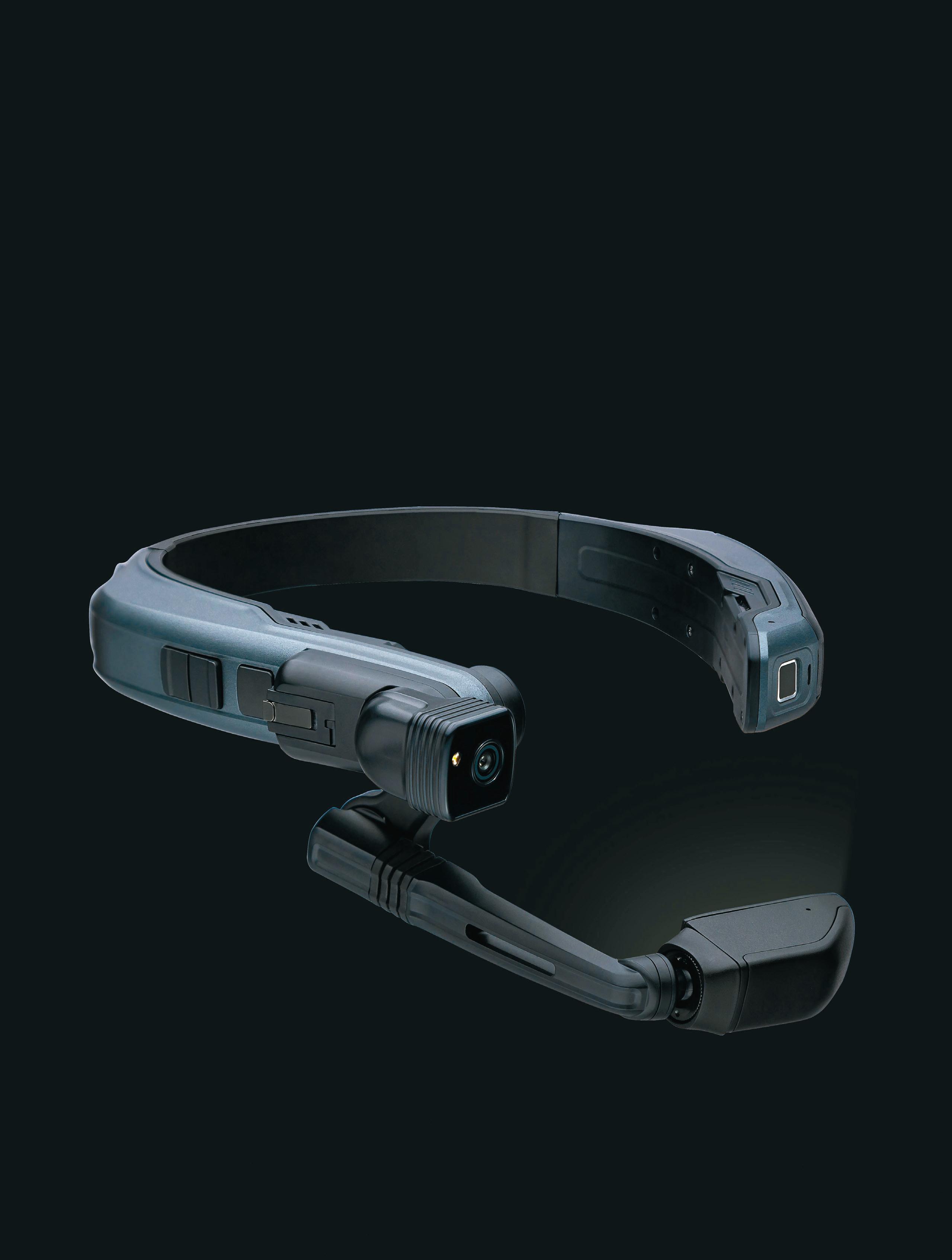
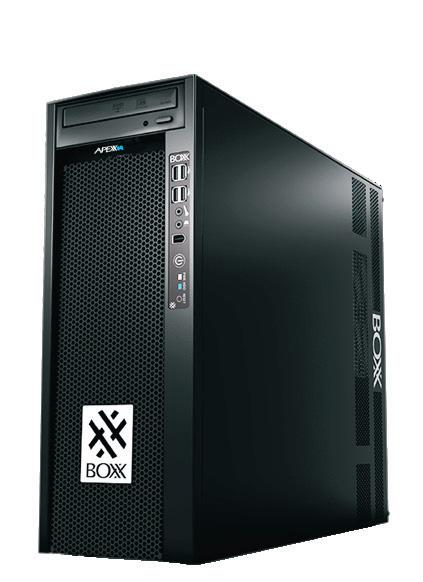
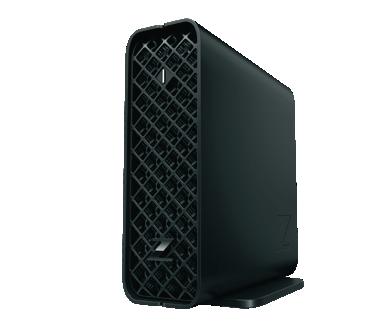
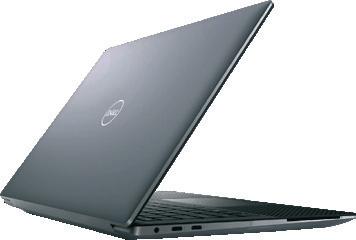
Harman interview P38 Fashion details P30 TECHNOLOGY FOR THE PRODUCT LIFECYCLE DECEMBER 2022 / JANUARY 2023 | £6 | € 7 | $10 | DEVELOP3D.COM ROBOT INSPECTORS NEXT-GEN PIANO DESIGN THE NEED FOR BIOPOLYMERS
UP! Wearables design for working life from RealWear Inside Makelab P34 FREE INSIDE WORKSTATION SPECIAL REPORT
HEADS
Automate SOLIDWORKS manufacturing processes & sell digitally using DriveWorks
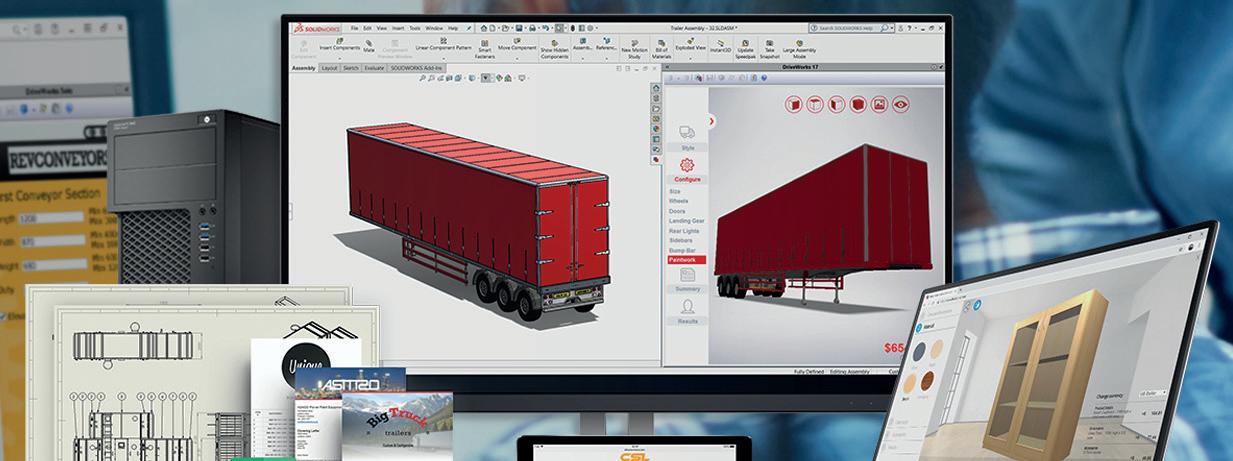
DriveWorks is flexible and scalable. Start for free, upgrade anytime. DriveWorksXpress is included free inside SOLIDWORKS or start your free 30 day trial of DriveWorks Solo.
30DAY

Automate
assemblies and drawings Generate production ready drawings, BOMs & quote documents automatically Enter product specifications and preview designs inside SOLIDWORKS Free online technical learning resources, sample projects and help file
Modular SOLIDWORKS® automation & online product configurator software




Complete SOLIDWORKS part, assembly and drawing automation
Automatically generate manufacturing and sales documents
Configure order specific designs in a browser on desktop, mobile or tablet





Show configurable design details with interactive 3D previews


Integrate with SOLIDWORKS PDM, CRM, ERP, CAM and other company systems




Scalable and flexible licensing options

One time setup
Set up once and run again and again. No need for complex SOLIDWORKS macros, design tables or configurations.

Save time & innovate more Automate repetitive SOLIDWORKS tasks and free up engineers to focus on product innovation and development.
Eliminate errors
DriveWorks rules based SOLIDWORKS automation eliminates errors and expensive, time-consuming design changes.

Connect sales & manufacturing

Validation ensures you only offer products that can be manufactured, eliminating errors and boosting quality.


Integrate with other systems
DriveWorks Pro can integrate with other company systems, helping you work more efficiently and effectively.
Intelligent guided selling
Ensure your sales teams / dealers configure the ideal solution every time with intelligent rules-based guided selling.
Find under the SOLIDWORKS tools menu Entry level SOLIDWORKS part
Create a drawing for each part and
SOLIDWORKS®
Sold and supported by your local SOLIDWORKS reseller
DriveWorksXpress Entry level design automation software included free inside SOLIDWORKS®
and assembly automation
assembly DriveWorks Solo
part, assembly and drawing automation add-in
SOLIDWORKS parts,
FREETRIAL
DriveWorks Pro
and supported by your local SOLIDWORKS reseller
Sold
www.driveworks.co.uk Try examples online at www.driveworkslive.com
EDITORIAL Editor Stephen Holmes stephen@x3dmedia.com
+44 (0)20 3384 5297
Managing Editor Greg Corke greg@x3dmedia.com
+44 (0)20 3355 7312
Staff Writer Claudia Schergna claudia@x3dmedia.com
Consulting Editor Jessica Twentyman jtwentyman@gmail.com
Consulting Editor Martyn Day martyn@x3dmedia.com
+44 (0)7525 701 542
DESIGN/PRODUCTION
Design/Production Greg Corke greg@x3dmedia.com
+44 (0)20 3355 7312
ADVERTISING
Group Media Director Tony Baksh tony@x3dmedia.com
+44 (0)20 3355 7313
Deputy Advertising Manager Steve King steve@x3dmedia.com

+44 (0)20 3355 7314
US Sales Director Denise Greaves denise@x3dmedia.com

+1 857 400 7713
SUBSCRIPTIONS
Circulation Manager
Alan Cleveland alan@x3dmedia.com
+44 (0)20 3355 7311 `
ACCOUNTS
Accounts Manager Charlotte Taibi charlotte@x3dmedia.com


Financial Controller

Samantha Todescato-Rutland sam@chalfen.com

Wrapping up the final issue of DEVELOP3D for another year, I’ve had time to reflect on all the people, topics and products we’ve looked at in these pages during 2022. We’ve covered a lot of ground, and we’ll be aiming to give you just as much variety in 2023.
This issue is no exception. Greg has been beavering away to produce an exceptional Workstation Special Report, full of insight and reviews of the latest in hardware, processing and graphics.
Our cover story looks at a different type of hardware, as the wearable technology experts at RealWear give us a peek behind the curtain at their company. These headsets are built specifically for industrial use, eschewing flimsy futuristic consumer tech for tried-and-tested resilience and proven ergonomics. Meanwhile, Claudia conducted not one, but two excellent interviews for this issue. One was with Harman’s Philipp Siebourg, with the future of car audio design under the spotlight. The other was with Christina Perla, CEO and co-founder of MakeLab, a woman working to make additive manufacturing more accessible to a far wider range of creatives and companies.
Elsewhere, we also tinkle the ivories with Casio, as its Tokyo design team talks us through the process of creating a piano designed to fit modern lives and living spaces.
I’ll sign off here with a huge thanks to everyone who has contributed to DEVELOP3D over the past 12 month, giving us their time, helping us to pull together these pages, offering their opinions, or simply getting in touch for a natter.
In 2023, DEVELOP3D celebrates its 15th year in print and we look forward to celebrating that milestone with all our readers!
Stephen Holmes Editor, DEVELOP3D
@swearstoomuch
DEVELOP3D.COM DECEMBER 2022 / JANUARY 2023 3
ABOUT DEVELOP3D is published by 19 Leyden Street London E1 7LE, UK T. +44 (0)20 3355 7310 F. +44 (0)20 3355 7319 © 2022 X3DMedia Ltd All rights reserved. Reproduction in whole or part without prior permission from the publisher is prohibited. All trademarks acknowledged Opinions expressed in articles are those of the author and not of X3DMedia. X3DMedia cannot accept responsibility for errors in articles or advertisements within the magazine
WELCOME DEVELOP3D.com facebook.com/DEVELOP3D @DEVELOP3D groups/DEVELOP3D Join our online community
Magazine,
The Tools to Supercharge Your CAD Workflow
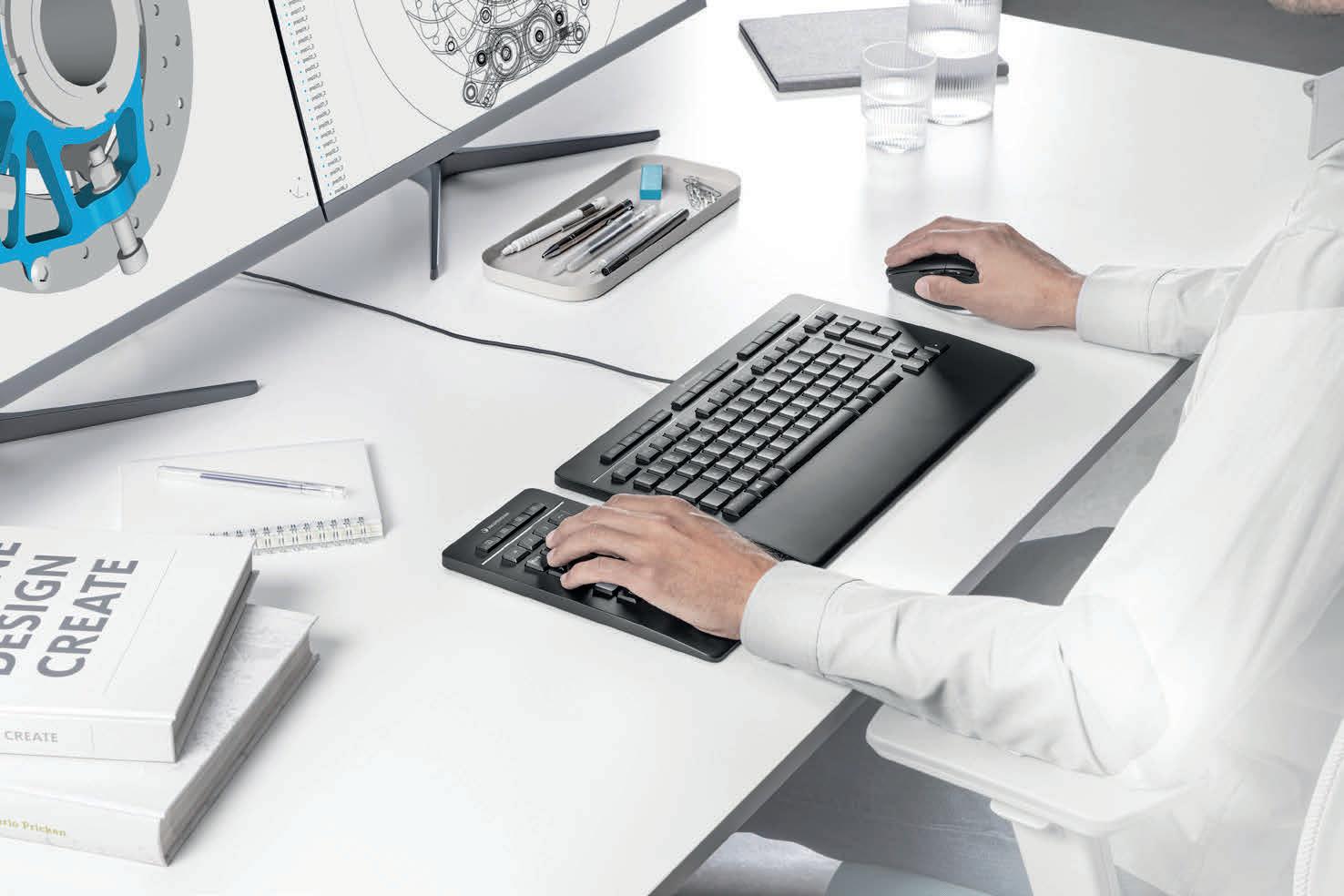
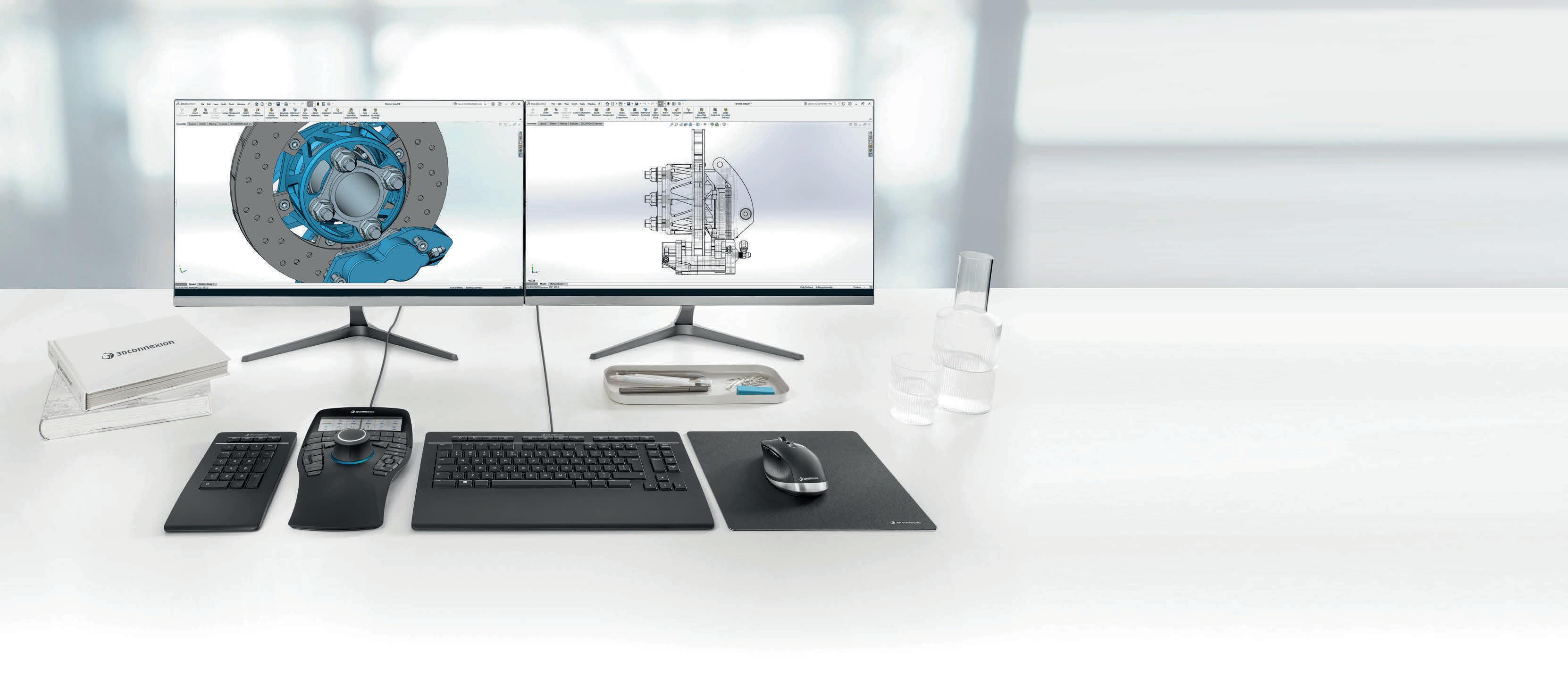
SpaceMouse ®
Smooth, intuitive and powerful navigation
CadMouse
Specially designed for CAD professionals

Keyboard Pro with Numpad

Customization taken to the next level
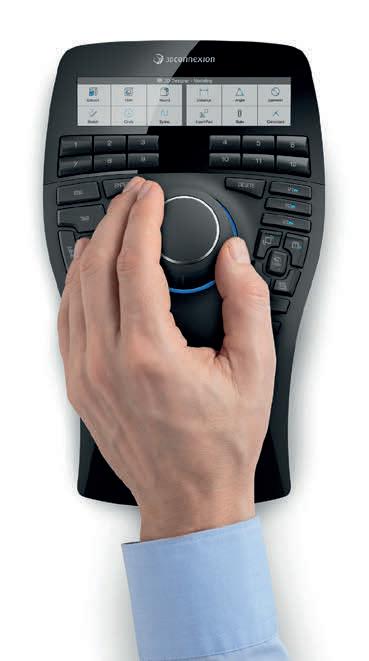
out more
Find
NEWS
PTC buys ServiceMax in a bid to stretch the digital thread, Epic Games adopts Hoops Exchange for CAD import and Siemens launches Simcenter Cloud HPC
FEATURES
Comment: IDC’s Luke Williams on biopolymer futures


Comment: SJ on manufacturing workforce mathematics

Visual Design Guide: Toka 4 from Gecko Robotics
COVER STORY Workplace wearables get real Sweet music: Casio rethinks the piano for modern homes


Eurominuterie’s stylish designs for garment details
Inside Makelab: A new breed of copy shop
Q&A: Philipp Siebourg of Harman International
THE LAST WORD
The way we purchase many products is changing, creating challenges for designers and manufacturers. How might these shifts impact our gift-giving habits? FREE
Comment: workstation energy efficiency
13th Gen Intel Core vs AMD Ryzen 7000 CPUs
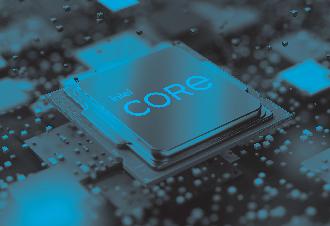
Review: Scan desktop workstations
Review: Boxx Apexx S4.04 workstation
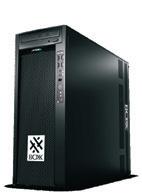

Review: HP Z2 Mini G9 workstation



Round-up: mini desktop workstations

Review: Armari Magnetar M64TP-RW1300G3

Review: Dell Precision 5470 mobile workstation

Round-up: ultra-portable mobile workstations
Review: Intel Arc Pro A40/A50 GPUs
Review: Nvidia RTX A2000 / Nvidia T1000 GPUs


AMD Radeon Pro OpenGL driver

DEVELOP3D.COM DECEMBER 2022 / JANUARY 2023 5
INSIDE WORKSTATION SPECIAL REPORT
DECEMBER 2022 / JANUARY 2023 ISSUE NO. 137 06 13 14 16 20 26 30 34 38 44 WS03 WS04 WS14 WS17 WS18 WS19 WS20 WS24 WS25 WS28 WS34 WS36
magazine
Forest Stewardship Council certified well-managed forests, controlled sources and/or recycled material CONTENTS www.develop3d.com December January2023 workstationspecialreport With impressive performance and hardware tracing built this low profile graphics card transform theworkflows lovers smalldesktop workstations,writesGregCorke SmallFormFactor(SFF)worksta like Precision 3460 havebecomeextreme ly popular designers and engineers because they take up signifi cantly spacethanstandarddesktop towers. However, because their slenform,theyhavebeenlimitedtoprofile’GPUs halfheightbracket. Historically,low-profilecardshavebeen verymuch‘entry-level’—perfectlygood for CAD, lacking performance featuresformoredemandingworkflows asreal-timevisualisationand raytracerendering. This changed last with introduction Nvidia RTX A2000. This powerful low GPU not only delivered more performance than before, but introduced RTX technologyentry-levelsegment.Previously, order professionalNvidiagraphics with hardware ray tracing built-in, you needed classGPU. The other major difference between theNvidia A2000andprevious low-profile offerings that double height board, taking up two on motherboard.accommodate beefier type for better cooling, where hot directly exhausted the workstation via the on bracket. size, Nvidia RTX A2000 started workstations well, as the Z2 MiniG9(seepage18). But not limited to workstations. can fitted standard towers, when GPU purchasedseparately comeswith half heightandfullheightATXbracket. Nvidia A2000 featured GBofGDDR6memory. timeoflaunch we suggested might be light its intended workflows. After all, datasets quickly swell, especially 4K resolution. recently,however,Nvidia released GB version, which subject thisreview. GB models identical with Mini DisplayPort outputs and minimal matt black enclosure. maxboard of70W GPU designed to operatewith slot the A2000 with full suite proapplications. In and software Inventor, Solidworks Revit — thandelivered.Compared to the Nvidia A4000, SPECapc Solidworks benchmark scores may dropped off 4K resolution, we still perfectly smooth viewport with 26.4 Frames Second (FPS) testing our large 2,300 part, milliontrianglesnowbikeassemblywith vizworkflowsthingsstartedto down little. While card showed great performance FHD resolution, dropped considerably especially in some of our more demanding tests. VRED Professional 2023 with aliasing to ultra-high in Unreal Engine 4.26 ray tracing enabled, reacheddoubledigits.InGPUrendering,the A4000was 88% faster V-Ray, in Solidworks Visualize stillrendered Camaro model 4K(100passes de-noising) in perfectlyacceptable38.5seconds. an ourtestinghighlightedimportanceofselecting rightprodriver. Newerisnotalwaysbetter.InSolidworks Visualize 2022, card almost timesslower the driverthan with certified516.94 verdict its impressive performance hardware ray tracing, Nvidia RTX A2000 has completely transformed the andultra-compactworkstation.excellentchoice CADusers want to expand design visualisation, with dedicated tools KeyShot GPU tracersthatarestarting make way CADviewports. forgetabout GBversion card. much better now well the TheRTXA2000 notthe for you designvizseriously.TheRTXandabove much suited moredemandingworkflows,especially resolution. these full boardsforfull sizedtowers. youhaveyourheart pint-sizeddesktop,thenthere’snothing outthererightnow comesclose. NvidiaRTX RTXA2000(12GB) budgets and little designvisualisation, should Thislow-profile nailed CAD.DisplayPorts, max models. Solidworks2022, our assemblies, hardly difference Nvidia A2000. And (Ex cheaper. Nvidia T1000 (8GB) RTX opens possibilities entry-level viz workstations applications KeyShot courtesy Cooper) WS34_D3D_DEC22FEB23_Nvidia-RTX-A2000.indd 19/12/2022 www.develop3d.com workstationspecialreport Threemoreultra-compactdesktopworkstationsforspace-constrained environments,orsimply sitprettyonyourdesk Tinydesktopworkstationsthealternatives 190 178mm, microworkstation smaller the G9, narrows your 65W Intel shouldn’t you CAD difference performancebetween 65W i9-12900 i9-12900K neglible, you’ll get multi-threadedperformance rendering. There’s compromise graphics GPUs Nvidia A2000 covering viz. machine from choice storage HDDs SSDs) are ports can VESA-mounted Dell’s all-in-onemonitor (pictured) deskclutter-free. Precision3260 name, nature, ThinkStation workstation 183mm. just this is, ports picture left. thermals check, presume ThinkStation can low processors, configured or Gen CPUs (up plus pro the T1000 making for machine placed desktop mode the stand) under or VESA with custommounting and kg) can throw between and lenovo.com/workstations LenovoThinkStationP360Tiny powerful option high-performanceGPU opens Nvidia A5000 GB) well real-time and tracing.However, expect exact level performance would standard mobile desktop draws less ThinkStation 202mm features design themotherboard the andserviceability. the supports 128 DDR5 memory, smaller Precision Compact, 12th processors lenovo.com/workstations ThinkStationP360Ultra www.tinyurl.com/P360-ultra WS19 December2022 January workstationspecialreport Vs WS04_05_06_07_08_09_10_D3D_DEC22JAN23_Intel_AMD.indd 19/12/2022 WorkstationspecialreportforCAD,visualisationandbeyond DECEMBER 2023 DEVELOP3D.COM THEBATTLEOFTHECPU 13thGENINTELCOREVERSUS CAD-CENTRICAMDRYZEN7000FORWORKFLOWS MINIWORKSTATIONS POWERFUL MACHINES TO SIT PRETTY ON YOUR DESK OR HIDE BEHIND A DISPLAY INTELARCPRO WHAT DO INTEL’S LONG AWAITED DISCRETE GPU MEAN FOR CAD AND VIZ? Vs Slimline laptops PORTABLE MOBILE WORKSTATIONS Exclusive WS01_D3D_DEC22JAN23_Cover.indd 19/12/2022 PLUS
The wood used to produce this
comes from
PTC ANNOUNCES ACQUISITION OF SERVICEMAX IN A BID TO STRETCH THE DIGITAL THREAD
PTC has announced the acquisition of ServiceMax, in a move designed to strengthen its closedloop product lifecycle management (PLM) offerings.
ServiceMax, a provider of cloud-based field service management (FSM) software, is expected to be fully integrated into PTC by the end of January 2023.
The acquisition was signed for almost $1.5 billion and aims to expand PTC ’s offerings by extending the digital thread of product information into downstream enterprise asset management and FSM capabilities.
This deal is particularly strategic for PTC, executives from the company said, because its manufacturing customers rely on FSM for product performance, customer satisfaction and profitability. “The addition of ServiceMax will realise a key part of PTC ’s closed-loop PLM strategy,” said PTC president and CEO Jim Heppelmann.
As he explained, the PLM capabilities that PTC already offers engineering and manufacturing firms provide a system of record for the digital definition of any product configuration. ServiceMax adds to this, by providing a system of record for monitoring and servicing products after they leave the factory and are in use by customers.
ServiceMax has changed hands regularly in recent years. PTC is acquiring the company from the private equity firm Silver Lake, which in turn purchased it from General Electric in 2018.
The ServiceMax FSM platform is typically used by companies with extensive field service and support operations, helping them to coordinate out equipment repairs.
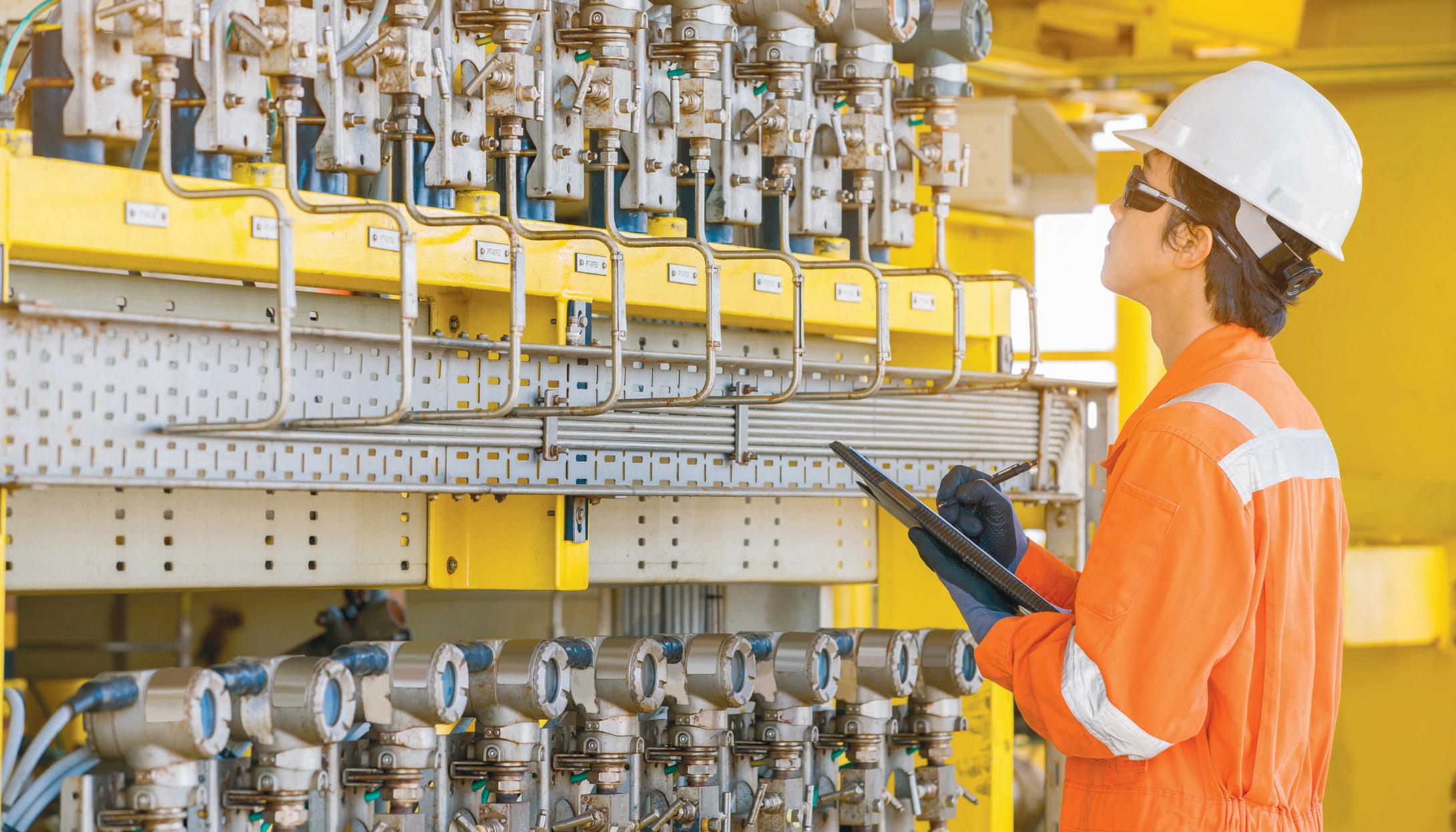
For instance, a wireless network operator might use the platform to dispatch technicians to a mast or radio base station experiencing technical issues.
Additionally, ServiceMax provides a mobile app, giving engineers working in the field immediate access to technical data on how to repair malfunctioning equipment and information on the availability of spare parts needed to make a fix, among other functions.
“Upon completion of this acquisition, PTC will have the unique ability to complement the full digital product definition from our computer-aided design (CAD) and PLM solutions with detailed usage information from our Internet of Things (IoT) solutions and the complete service history from ServiceMax,” said Heppelmann.
In that respect, he claimed, PTC “is poised to be the only company that will be able to offer manufacturers this comprehensive view of their products at each stage of the lifecycle.”
ServiceMax and PTC have worked together since 2015 to support manufacturers in the creation of complex, highly configured products for the medical, industrial and aerospace industries.
The two companies said FSM is key for manufacturers in those industries, as it allows them to maintain product performance, extend product lifecycles, increase customer satisfaction, drive revenue growth, and expand profitability.
“ServiceMax and PTC have a longstanding relationship rooted in the common profile of our customers, the natural synergies of our products, and a shared understanding of the importance of product data at different stages of the lifecycle,” said ServiceMax CEO Neil Barua. ServiceMax was built on the Salesforce platform and offers capabilities that include management of all relevant information about serviced products, creation/management of work orders, and scheduling/dispatching of technicians. These capabilities integrate closely with Salesforce’s customer relationship management (CRM) capabilities.
Alongside its FSM platform, ServiceMax also offers an artificial intelligence tool, which can recommend possible ways to fix a malfunction and rank answers by their likelihood of success. www.ptc.com
Field service engineers use ServiceMax to access information on appointments, consult technical information and check on spare parts
6 DECEMBER 2022 / JANUARY 2023 DEVELOP3D.COM NEWS
NEWS
» The cloud-based field service management provider brings PTC users a system of record for products after they have left the factory and are in use by customers


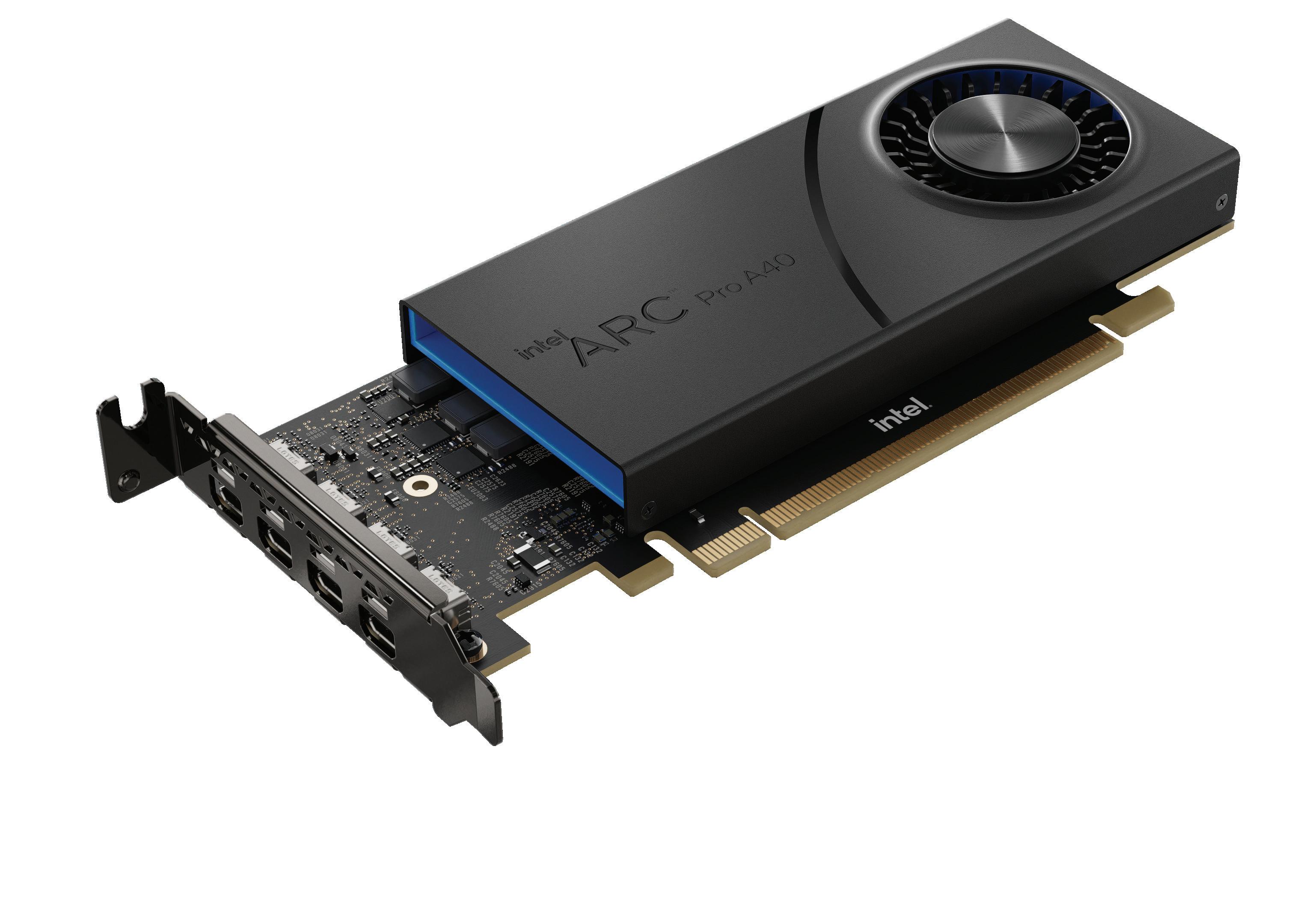
Intel® Arc™ Pro A40 GPU unites fluid viewports, the latest in visual technologies, and rich content creation in a condensed half height, half length form factor. • Ray Tracing Hardware Acceleration • Dedicated AI Acceleration • Industry First AV1 Hardware Encode • 6GB High Speed Memory • Software Certifications • Up to 4x Displays, with Audio Support and Latching Mechanism • Single Slot, Tiny Form Factor • Premium Components • Extended Warranty Professional Graphics Begins Here Intel.com/ArcProA40 © Copyright 2022 Intel Corporation. All rights reserved. Intel, the Intel logo, and other Intel marks are trademarks of Intel Corporation or its subsidiaries. Intel Arc Graphics is a trademark of Intel Corporation in the U.S. and/or other countries. Other names and brands may be claimed as the property of others.
EPIC GAMES ADOPTS HOOPS EXCHANGE FOR CAD IMPORT
Stratasys buys QA expert Riven
Stratasys has acquired Riven, a cloud-based quality assurance software that aims to help customers inspect, diagnose and correct deviations between CAD files and 3D-printed parts, resulting in higher accuracy rates and lower costs.
Riven’s technology will be integrated into Stratasys’ GrabCAD Additive Manufacturing Platform, benefiting customers that use a Stratasys 3D printer running GrabCAD Print software. A new version of this software that uses artificial intelligence to pre-adjust models automatically is currently being tested, according to Stratasys execs.
www.stratasys.com
Epic Games has announced it has selected Hoops Exchange from Tech Soft 3D to simplify CAD data import. The technology will be incorporated into Epic's Datasmith pipeline, used to bring CAD models into the Unreal game engine to create more sophisticated visualisation and interactive applications.
According to Epic Games, customers from industries including automotive and aerospace had previously complained that they found it challenging to get their data into Unreal Engine, because CAD data is typically created for manufacturing, rather than for interactive visualisation.
To solve this problem, Epic Games built Datasmith, a collection of tools that allows Unreal Engine customers to import preconstructed scenes or complex assets and
assemblies from industry-standard design applications into Unreal Engine. The result is a more streamlined workflow when it comes to importing and preparing CAD data for visualisation.
At the same time, Epic aims to support the widest possible range of 3D design applications and file formats, which is where Hoops Exchange comes into the picture. This is a software development kit, or SDK, which supports imports in over 30 CAD formats, including Catia, Solidworks, Inventor and Revit.

Epic Games has already reported positive feedback from customers. Several companies from the automotive sector, for example, have said they are now able to bring in 3D CAD models and interact with them via virtual reality, in order to perform engineering reviews.
www.epicgames.com
Xcelerator gains complex simulation on AWS
Siemens Digital Industries Software has added scalable, on-demand, highperformance simulation capabilities to Siemens Xcelerator as a Service (XaaS) with the launch of Simcenter Cloud HPC.
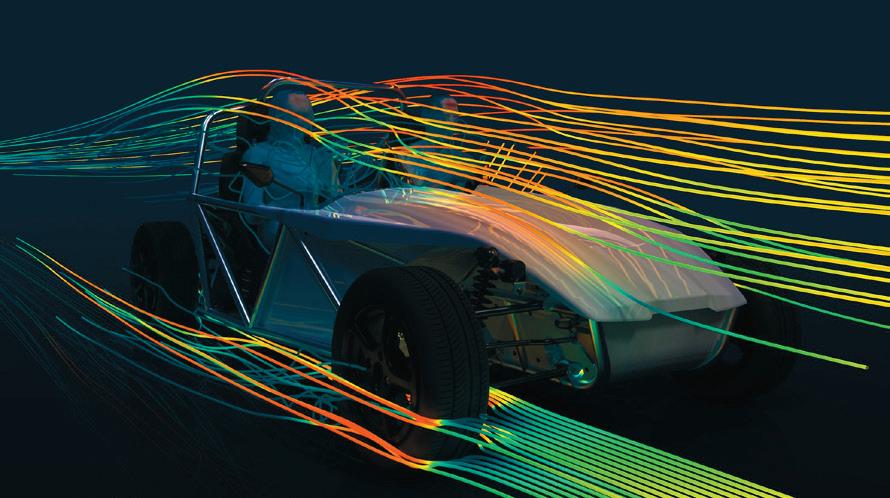
As part of an ongoing collaboration between Siemens and Amazon Web Services (AWS), the new service is hosted on AWS, optimised for Simcenter solver technologies and managed by Siemens.
The new service, according to Siemens executives, is designed to reduce the costs traditionally associated with onpremise high performance computing (HPC), allowing organisations of all sizes to access the benefits of advanced simulation, gain deeper insight into the performance for their products, and make more informed engineering decisions.
New LPBF app from Dyndrite
Dyndrite has announced the launch of its first enduser software, Dyndrite Materials and Process Development for LPBF.
Focused on materials and process development for laser powder bed fusion (LPBF) additive manufacturing systems, the new software takes advantage of Dyndrite’s Accelerated Computation Engine (ACE) and 3D volumetric part segmentation. Leveraging that technology, it provides the ability to work with CAD data directly, handle large files, and save and share build recipes.
www.dyndrite.com
Zortrax launches full-metal AM packages
Zortrax has launched two AM sets — Full Metal Package 17-4 PH and Full Metal Package 316L — as well as a new filament, Victrex Paek AM 200, which is designed to be extruded at lower temperatures, having a lower melting point than Peek.
Simcenter Cloud HPC is accessible seamlessly from the desktop simulation tool with no additional configuration needed, providing “immediate access to near-unlimited compute capacity”, while avoiding the cost and complexity of accessing third-party cloud services. www.sw.siemens.com
Each Zortrax Full Metal Package has been developed by the company to offer customers all the essentials for an easy start with metal 3D printing. They include either Basf Ultrafuse 316L or Basf Ultrafuse 17-4 Ph metal-polymer filaments, patented by Basf Forward AM. www.zortrax.com
8 DECEMBER 2022 / JANUARY 2023 DEVELOP3D.COM NEWS
By bringing CAD data into Unreal Engine, manufacturers can create more sophisticated visualisations
Simcenter Cloud HPC provides cloud-based capabilities for advanced simulation on AWS
High Temp 3D Printers High Temp 3D Printers for demanding applications for demanding applications

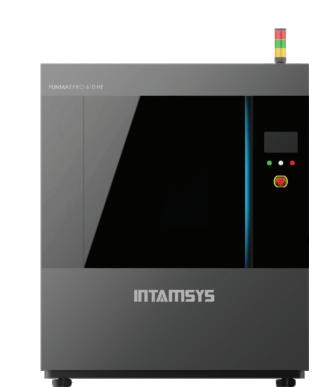

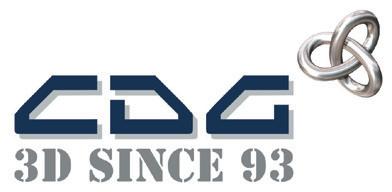
Materials include:

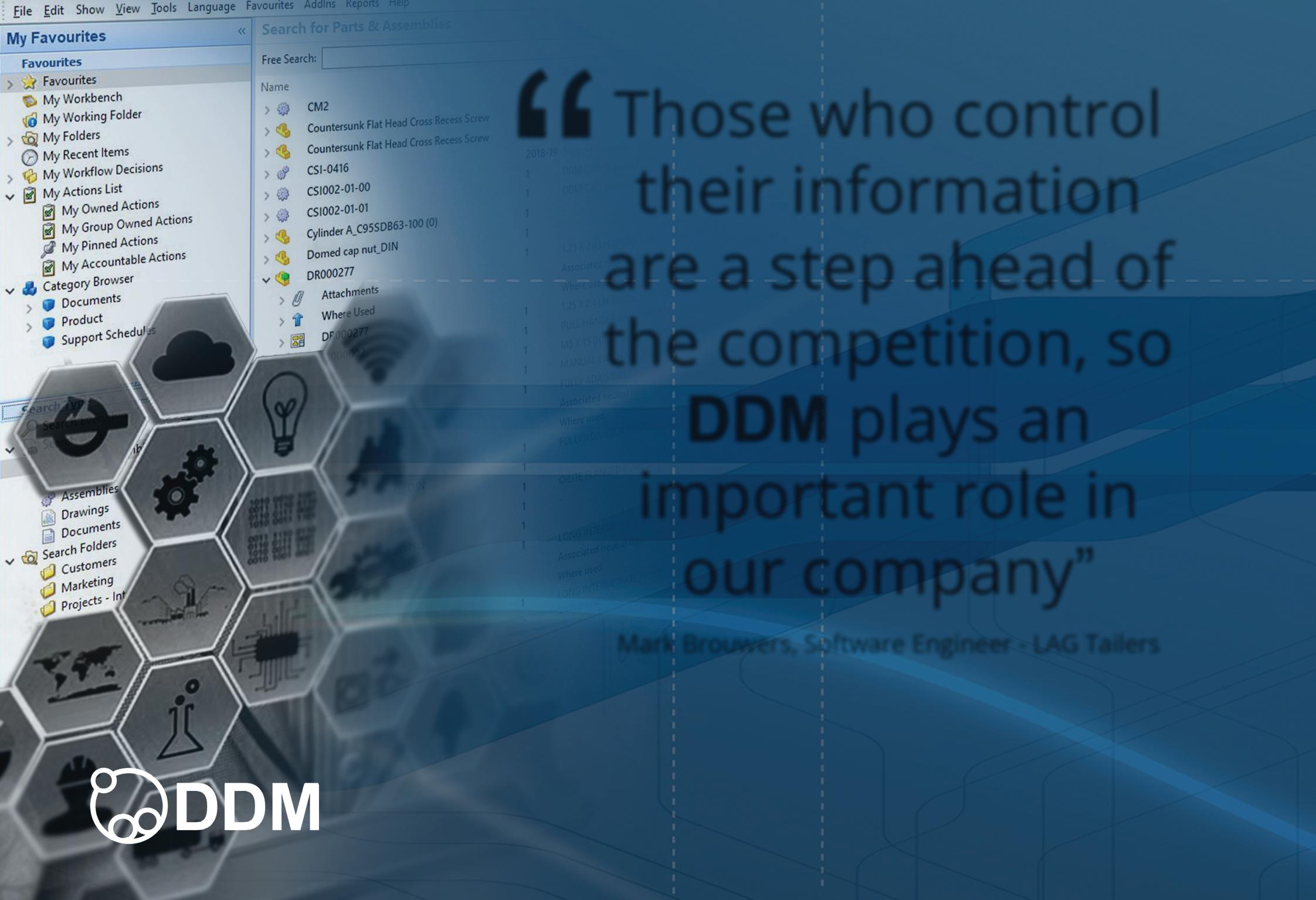
PEEK, PEKK, PEI, PPSU, PC, PA, PA+CF, ABS, ASA, PETG, HIPS, TPU, PLA, PVA
610
— 260 × 260 × 260 mm

— Single head
— 450 °C extruder temp
— Print speed 300mm/s XY
— Ceramic heated bed
— 305 × 305 × 406 mm
— Dual head
— 450 °C extruder temp
— Print speed 300mm/s XY
— Ceramic heated bed

www.cdg.uk.com
— 610 × 510 × 510 mm
— Dual head
— 500 °C extruder temp
— Print speed 500mm/s XY
— Vacuum system on bed
“
Funmat HT [Enhanced]Funmat Pro 410Funmat Pro
· 01420 556755


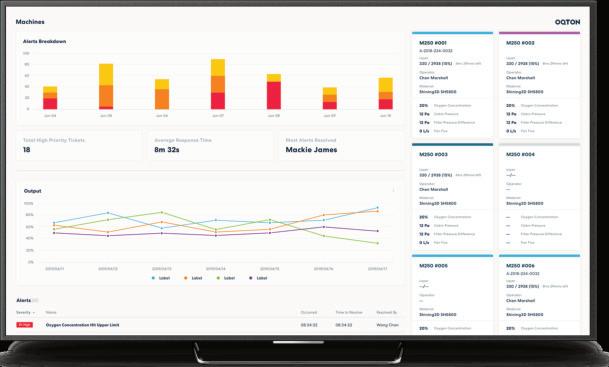


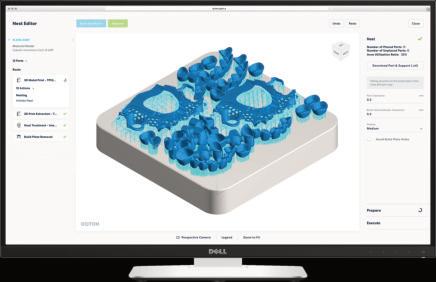

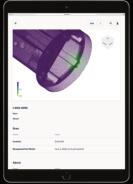
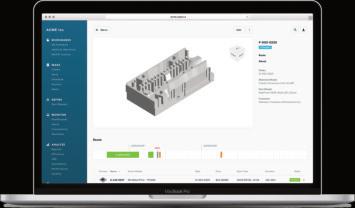


SIGNAL INTEGRITY EXTENSION LAUNCHED FOR FUSION 360
Autodesk has announced its new Signal Integrity Extension for Fusion 360, powered by Ansys to enable users to analyse PCB electromagnetic performance.
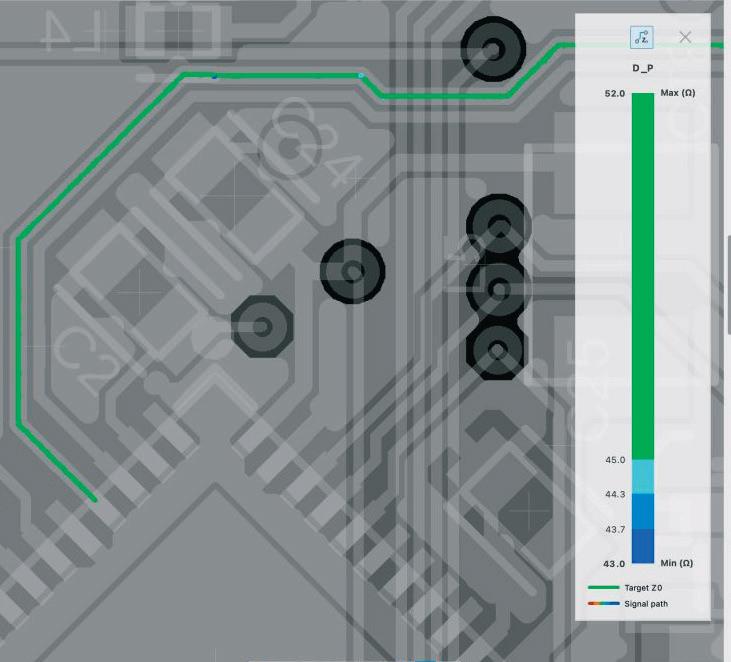
The results are rendered with a coloured gradient, enabling designers and engineers to easily identify problematic signal paths and violations, make design updates and deal with any signal impedance mismatches that they find.
Fusion 360 Signal Integrity Extension should enable users to deliver compliant smart products, reduce development costs and shorten time to market.
The new extension is designed to assist them in making sure that their products’ high-speed, RF and wireless capabilities meet design specs and are compliant with a range of industry standards, directives and rules.
It was also developed to help minimise costly PCB physical testing and board respins, by giving users immediate access to feedback on their design’s electromagnetic performance and thus reducing project timelines.
Fusion 360 Signal Integrity Extension offers simple input parameters and configuration to empower engineers to select signals of interest for fast, ondemand analysis, explore their design and inspect parameters that characterise highspeed signals, such as propagation delay, trace length, impedance and coupling.
Additionally, users should be able to manage and control impedance for every transmission line throughout a board, for a distortion-free and optimal high-speed performance design, and visually identify
any potential impedance or coupling issues, thanks to a superimposed colourcoded overlay on 2D PCB designs.
“What we want to do for manufacturers is improve the collaboration, help them design things faster and help them do more design exploration, so they can get more innovation in a shorter time,” said Autodesk VP of industry strategy Srinath Jonnalagadda, speaking at the company's Autodesk University 2022 event.
“With this simulation extension, we want to make sure that design insights are readily available for engineers at the time when they are doing the design. The extension is able to give real-time insights, so the designers can figure out how to optimise their product and printed circuit board designs,” he said. The new extension is now available for a 14-day trial. www.autodesk.com | www.ansys.com
Photocentric unveils Liquid Crystal Titan
Photocentric, inventor of LCD 3D printing, recently took the opportunity at Formnext to show off parts created by the Liquid Crystal Titan, its largest 3D printer yet.
According to company executives, the machine has been developed to combine large size, high resolution, fast print speeds and high accuracy.
The Titan is equipped with a 700 x 395 x 1200 mm build volume and a 91µm pixel pitch resolution, and also features an 8K 32-inch LCD screen. With it, the company aims to

ROUND UP
Materialise has announced that seven new partners have joined its CO-AM software platform to support design and preprinting automation, traceability, printing and post-processing for 3D-printed parts.
Materialise Magics has also been integrated into CO-AM www.materialise.com
Authentise has released its Digital Design Warehouse platform, which was developed to help organisations establish more cohesive additive manufacturing initiatives, by bringing into one place insights into AM processes collected from disparate silos and teams www.authentise.com
3D Systems and ALM have partnered to expand access to industry-leading 3D printing materials, in an agreement that involves the addition of 3D Systems’ DuraForm PAx material to ALM’s portfolio. This will give ALM customers access to a unique copolymer designed specifically for use with SLS technologies www.3dsystems.com
make large-scale production a reality for additive manufacturing applications in automotive, transport, creative arts and merchandising.
Photocentric also announced it will be delivering ceramic production parts in Alumina and Silica and benefiting from extensive experience in photopolymer and LCD-based, large-scale manufacturing to mass manufacture Alumina parts. It is also partnering with Loctite and BASF Forward AM, to develop and validate high-performance engineering-grade resins for industrial applications. www.photocentric group.com
Dyemansion has announced its Powerfuse S PP postprocessing station for vapour polishing, in a move designed to bring surface and material improvements specifically to parts 3D-printed in polypropylene, making new use cases possible for this material www.dyemansion.com
Cloud Factory has raised £1.7 million for its direct metal 3D printing technology to manufacture sustainable jewellery and develop its online jewellery platform. Through its use of additive manufacturing, the company defines itself as the world's first zero-waste jewellery factory www.cloudfactory.jewelry
DEVELOP3D.COM DECEMBER 2022 / JANUARY 2023 11 NEWS
Fusion 360 Signal Integrity Extension is designed to help users deliver safe, compliant smart products
The Liquid Crystal Titan is Photocentric's largest 3D printer yet



additivemanufacturingstrategies.com networking & intelligence summit NEW YORK | february 7-9, 2023 THE VOICE OF 3D PRINTING 3dprint.com The Leading Source of Industry Analysis, Market Forecasting and Data for Additive Manufacturing smartechanalysis.com
Since designers are now expected to be conscious of their role in sustainable product development, an awareness of emerging ways to remove carbon from the design process is paramount. Reducing our dependence on fossil fuels is one of the key steps in decreasing our carbon footprint — and adopting biopolymers may be the answer.
So what actually are biopolymers? Crude oil is typically used to create virgin plastic. Crude oil is refined, polymerised and processed to form pellets used to injectionmould plastic parts. Biopolymers are derived from renewable sources. Instead of crude oil, they are created from a renewable feedstock, in the form of crops, waste cooking oils or algae. These renewable feedstocks are processed at a biorefinery, polymerised and similarly processed to form pellets for injection moulding.
Renewable feedstocks are a carbon sink, as they absorb carbon throughout their life. As a result, biopolymers exhibit a negative carbon footprint and contribute to the reduction of carbon. Replacing virgin polymers with biopolymers helps to build a circular economy, removing the need for fossil feedstocks like crude oil.
SAYING NO TO VIRGIN PLASTIC
The primary advantage of biopolymers is that they remove the dependence on crude oil and replace it with renewable sources that contribute to the reduction of carbon. Before biopolymers, the nonfossil alternative to virgin polymers was a mechanically recycled polymer.
Mechanical recycling starts with the waste plastic that is collected from your door. Local councils send it for sorting, cleaning, shredding and reprocessing, where it becomes pellets for injection moulding.
The primary limitation of mechanical recycling is the lack of complete cleanliness and traceability. For these reasons, mechanically recycled polymers cannot be used to manufacture medical or food/
drink-safe products. Biopolymers, by contrast, have cleanliness and traceability attributes identical to virgin polymers.
IDC recently worked with Reuser to develop a reusable coffee cup lid. BioPolypropylene was used to manufacture the product, which has a negative carbon footprint, offers mechanical and thermal properties nearly identical to that of a virgin Polypropylene and is fully recyclable at the end of its life. IDC’s sister company Naiad became the first UK manufacturer to use Bornewables’ bio-Polypropylene within the food and drink industry, while the use of biopolymers contributed to Reuser’s mission of replacing the disposable, single-use food and beverage system with innovative reusable solutions. The fully recyclable bio-Polypropylene, with an established end-of-life infrastructure, formed a circular economy.
Much of the attention around sustainability is focused on one-off projects where face masks or plastic bags have been recycled to form an exotic piece of art or furniture. While this removes single-use products from landfill, the elaborate and laborious processing means this can never be adopted at a scale where the positive environmental impact would be meaningful.
Earlier in 2022, Philips launched the world’s first breakfast set made from bio-based plastics. The toaster, kettle and coffee machine were manufactured from biopolymers derived from recycled cooking oil. It is hoped that other manufacturers will follow suit and embrace the use of biopolymers at scale as a direct replacement for fossil-based plastics.
Injection moulding biopolymers is no different from virgin polymers. No special set-up or processing is required, and mass production can begin immediately using existing infrastructure.
WHAT’S STOPPING US?
The primary drawback of biopolymers is cost. While virgin Polypropolyne costs roughly £2/kg, bio-Polypropolyne costs roughly £3/kg. The cost of biopolymers is
largely driven by the expensive and lowyield processing of renewable feedstocks, but with time and economies of scale, the price gap between bio and virgin polymers is expected to close significantly.
In addition, the price of virgin polymers is linked to the price of crude oil, which is only going to increase as stocks are depleted. While there are thousands of virgin polymers available with properties to suit almost any application, there are only a handful of biopolymers to choose from. Bio Polypropylene (PP), Polyethylene (PE) and Polyethylene terephthalate (PET) are among the most common. These polymers have a limited number of useful applications.
Chemical recycling is an emerging process that can produce a wider range of available bioplastics. Here, non-mechanically recyclable waste plastics are broken down into hydrocarbons that are polymerised and processed to form virgin-equivalent biopolymers. This will play a key role in reducing the quantity of conventionally unrecyclable plastic sent to landfill.
The use of biopolymers is supporting the push for a circular economy that isn’t dependent on crude oil. As the processing of renewable feedstocks develops and economies of scale reduce raw material costs, the use of biopolymers is set to have a significant positive impact on the plastics industry.
ABOUT THE AUTHOR: Luke Williams is a Senior Design Engineer at IDC. He plays a key role in design for manufacture, in particular design for injection moulding. As well as detailed design, this involves polymer selection across a range of parts for medical and industrial devices. Recent work has involved the analysis and implementation of biopolymers to deliver sustainable solutions

DEVELOP3D.COM DECEMBER 2022 / JANUARY 2023 13
COMMENT
Replacing virgin polymers with biopolymers helps to build a circular economy, removing the need for fossil feedstocks like crude oil
Design and manufacturing pros who want to play their part in creating more sustainable products need to keep a close eye on biopolymers, writes Luke Williams of industrial design consultancy IDC
Current numbers simply don’t add up if the manufacturing sector hopes to maintain a fit-for-the-future workforce, writes our columnist SJ. Here’s some advice for employers keen to recruit new talent to the sector in 2023
My first written sentence, made with a shiny yellow number 2 lead pencil, was an algebraic equation.
Raised by a math teacher, my mother taught me the language of numbers – and the stories they told –before I even learned to ride a bike.
In this column, I have another story to tell, about hiring in advanced manufacturing, and in this one, the numbers just don’t add up. Or, as members of the Gen Z cohort sometimes say: “The math isn’t math-ing.”
I recently had the honour and pleasure of attending the International Conference for Additive Manufacturing. After their sessions, I made a point of speaking to panellists about their perspectives on the job market.
I’m happy to report back that many were optimistically hiring. They had “tons of positions open”, they told me. I expressed surprise because, from a personal perspective, I’ve been seeing record layoffs and industry colleagues struggling to get rehired. For the last year, my LinkedIn feed has been filled with contacts being laid off, companies going bankrupt and start-ups disappearing almost overnight.
The more sage members of the community were quick to point out that many of the layoffs were happening at specific types of companies, and in particular, those that manufacture machines.
In other words, it’s simply a reflection of “too much supply, not enough demand”, they told me, and not something for the advanced manufacturing sector as a whole to be overly concerned about.
At the same time, one of the more prestigious firms reported continued record growth for the industry, increasing numbers of patents, and even hinted at potential job security into the future, thanks to the large demand they were seeing for employees.
From my perspective, this last point is where “the math isn’t math-ing.” Why, I wondered, am I seeing this complete disconnect between the dismal situation seen on my LinkedIn account and hubristic industry reporting?
MAKE IT ADD UP!
It’s time to put our yellow number 2 pencils to work. I imagine the math problem might read something like this: “In the manufacturing industry, 25% of employees are more than 55 years old and the median age of the workforce is 44.5 years. If a person is selected at random from this industry, what is the probability that they are under 30 years of age?”
Now, I don’t need a calculator to tell you how bleak that picture looks for the future of advanced manufacturing. I’ve heard first-hand the frustrations of young high school students, worried about their future earning potential; of parents, who are scared to see their child begin a career that might get outsourced before it has barely begun; of employers, representing organisations both large and small.
Businesses in the US are disheartened by the unsustainable, over-inflated salaries required to retain top talent. In the UK, they are struggling to back-fill a talent pipeline hamstrung by immigration challenges as a result of leaving the EU. And companies in both the US and the UK all face fierce challenges when it comes to creating more diverse workforces.
MY ADVICE TO INDUSTRY
But, as I stand in a weird gap between people close to retiring and people entering the workforce for the first time, I have a unique perspective to offer companies looking to attract and retain talent. My advice comes in three parts.
First, “If you can see it, you can’t be it.” Statistically, only 180 young players out of a pool of 1.5 million have the chance to become a pro footballer in the UK. Yet many take those odds, because they see the sport everywhere. If you want to attract and retain a workforce of skilled employees, create programmes that are widely seen. Penetrate spaces popular with young people and market career opportunities on social media: Snapchat, TikTok, or Instagram. Meet them where they are most comfortable and most receptive to your message.
Second, “Make it bite-sized.” This upcoming generation is one accustomed to instant gratification, because its members were born and raised on the internet. They’re not interested in extensive 401k benefits, life insurance, retirement programmes/assistanceship, or stocks with long vesting periods. Instead, offer them achievable and clearly outlined goals to achieve regular promotion faster. Offer them healthcare benefits for their pets (because having children in this economy? Absolutely not.) For those that do have children, offer a generous family leave policy – for both partners. Give them lots of options, but make them bite-sized. This generation loves to pick and choose, creating a benefits package tailored to their wants and needs.
Third, “Be fuckin’ for real.” That’s Gen Z slang for “be authentic and cut the bullshit.” This starts with company culture. The younger generation wants to work for a company where personal values align with company values and overall mission. Rewrite your company story, find a purpose. In 2023, you need to “eat, pray, love” your company culture. It’s not enough to simply slap three keywords on an inspirational landscape and hang it on a wall in the break room. No, you have to change your company culture to be more open and responsive to the social issues that this generation cares about, like climate change, mental health and DEI (diversity, equity and inclusion). My mother’s favourite algebraic equation is y = mx + b, used to describe the slope of a line. Those four characters tell a story about who crossed what and where, how fast or how slowly, upwards or downwards. At some point, we have to draw the line for ourselves. I remain optimistic that change always brings a positive slope.
ABOUT THE AUTHOR: SJ is a metal additive engineer aka THEE Hottie of Metal Printing. SJ’s work involves providing additive manufacturing solutions and #3dprinting of metal parts to help create a decarbonised world.

14 DECEMBER 2022 / JANUARY 2023 DEVELOP3D.COM
COMMENT
Companies in both the US and UK face fierce challenges in 2023, when it comes to attracting and retaining diverse talent

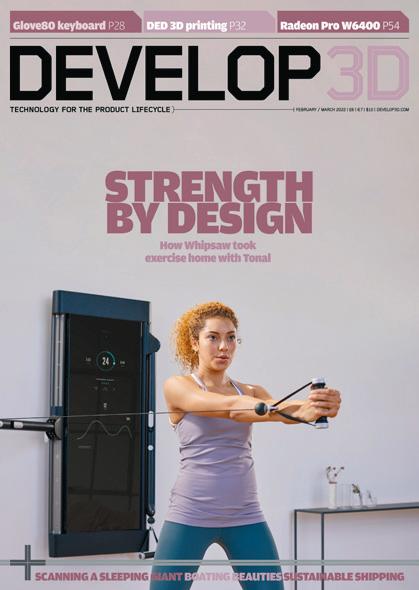
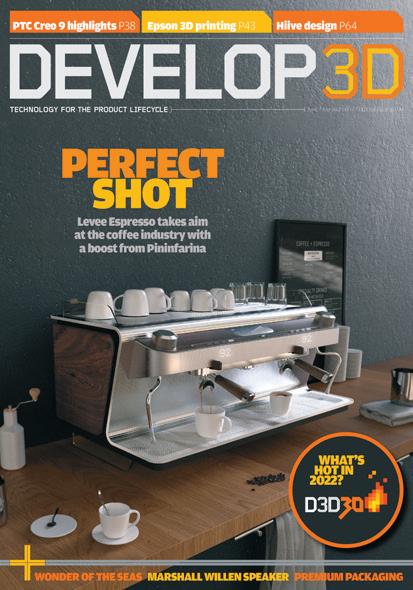

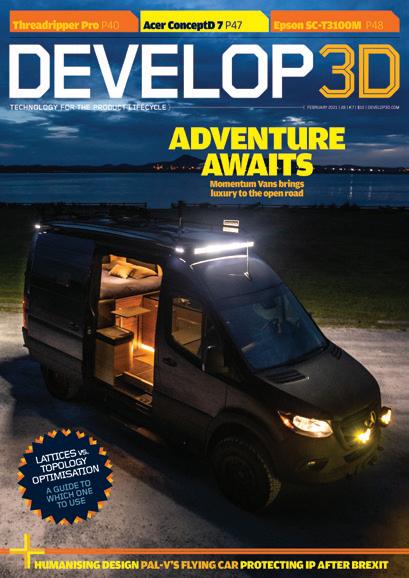



Subscribe now FREE Print* or digital Technology for the product lifecycle register.develop3d.com *Free for UK readers ($49 per annum for ROW)
VISUAL DESIGN GUIDE TOKA 4 FROM GECKO ROBOTICS
A climbing robot developed for inspecting areas too difficult or dangerous for humans to access, including pipework and boiler systems
ALL UNDER CONTROL
Front and rear HD driving cameras provide an operator with visuals for manoeuvring around environments and for capturing an asset’s surface condition during inspection
SMOOTH TRANSITIONS
Actuation of the sensor arms enables the robot to accomplish angle transitions while still capturing necessary data, and without slowing down the process
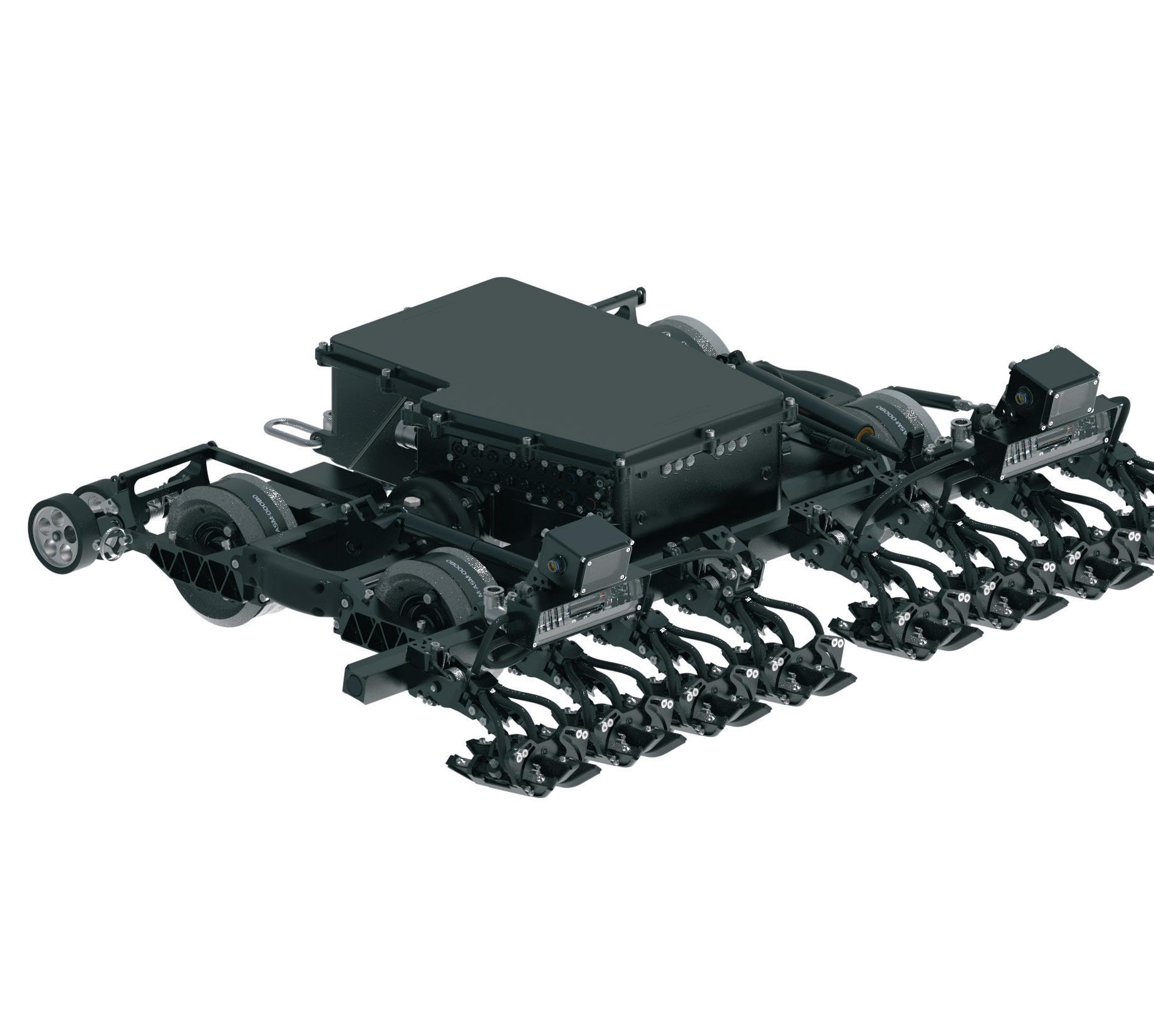
STRONG ATTRACTION
Permanent rare earth magnetic wheels support strong asset surface adhesion at speeds of up to 9 metres per minute
ALL THE DATA YOU NEED
Capable of carrying a payload of around 56Kg, the Toka 4 can be equipped with between 24 and 32 ultrasonic inspection sensors, in order to collect a wide array of data at rates of around 39 samples per metre
16 DECEMBER 2022 / JANUARY 2023 DEVELOP3D.COM
UPWARDS CURVE
The Toka 4 has been designed for curved surfaces such as tank walls and pipework, making it a valuable tool for companies where employees perform regular inspections, in industries such as oil and gas, pulp and paper, power generation and maritime transportation

FULL COVERAGE
The Toka 4 utilises compact rotary magnetic encoders for the accurate positioning of data, allowing it to create 3D models of inspection data

DEVELOP3D.COM DECEMBER 2022 / JANUARY 2023
BBI AUTOSPORT PUSHES THE BOUNDARIES OF MOTORSPORTS AND 3D MODELLING WITH FUSION 360
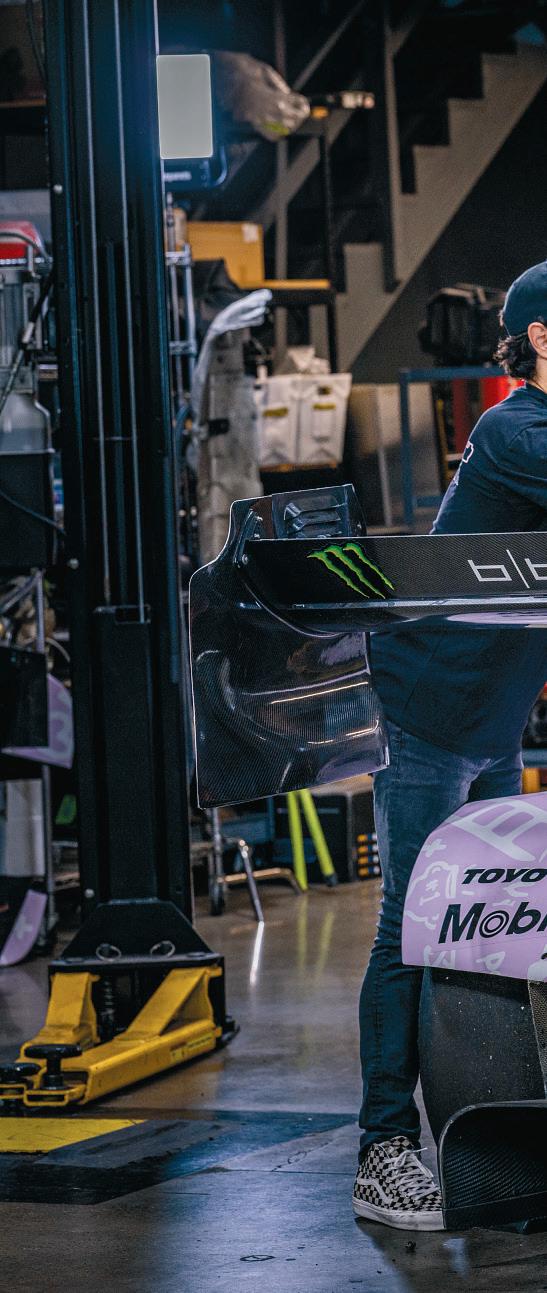
BBi
By: Gregory Han
Like many origin stories , the early beginnings of the Huntington Beach, California automotive tuning company BBi Autosport can be traced back to the wide-eyed and formative years of childhood.

“It was one afternoon when my cousin and I were playing outside when we spotted a stunning Porsche 959 drive by,” recollects BBi co-founder Betim Berisha, “It was the very same car on my cousin’s favourite poster up on his wall. We later found out the driver behind the wheel was Bill Gates!”
The sighting of the supercar – one of only
292 ever built – would give birth to a lifelong obsession with Porsches that would only intensify with age, culminating in Berisha founding BBi Autosport in 2005.
Alongside designer and company CTO, Dmitriy Orlov, today BBi Autosport operates at the upper echelons of bespoke motorsports, hosting a team capable of not only tuning and customizing the “phenomenal, dynamic, wildly versatile canvas” of Porsche vehicles,” but also designing vehicles uniquely their own in spirit and performance.
Designing “The Pig”
BBi’s talent for conjuring one-of-a-kind Porsches is perhaps best embodied by the creation of the Hoonipigasus, a beastly 1,400 HP mid-engine AWD rally racer conceived from the ground up in partnership with Hoonigan Racing for rally car legend, Ken Block. Loosely inspired by the Porsche 911, “The Pig” – as it is fondly referred to by its creators – was to be let loose on the death-defying winding course of Pikes Peak International Hill Climb for its 100thanniversary race with the hopes of breaking records on its way up to the race’s 14,100 feet peak.
The Pikes Peak trial was preceded by BBi’s own race against time. Battling an “insane” schedule compounded by long lead times further complicated by the pandemic, BBi found themselves designing, engineering, fabricating and testing The Pig in parallel.
Traditional tools wouldn’t allow each of the team members to work concurrently and collaboratively without “stepping on each other’s toes”. The Pig not only had to get assembled to roll up to the starting line by race day, but had to be engineered to the most exacting standards.
With a mere 0.04mm margin of error for their measurements, the team had to factor in every aspect of every part to line up with precise accuracy to bring their vision to life.“Producing parts of that
Autosport explains how Fusion 360 enabled them to design the Hoonipigasus, “a car that can do nearly anything.”
Sponsored content
quality is a daunting task when dealing with the tight deadline we were under,” says Berisha.
From chaos into collaboration
The need for a CAD/CAM solution that would allow the BBi team to develop products concurrently and outside the boundaries of traditional 3D modelling software made Autodesk Fusion 360 the ideal tool set, one that could bring all of their aggregated data into one centralized location. They’d find simplicity in using a cloud product development tool integrating CAD, CAM, CAE, and PCB to turn prototypes into production-ready parts.
“Autodesk Fusion 360 enabled us to move seamlessly through every stage in our development process, whether we were designing an engine, chassis, or even the smallest component,” says Betim. Tools like generative design enabled Betim and his team to run flow analysis to generate recommended outputs. They then used this data to design parts manufactured to their desired specifications.
“Fusion 360 allowed Dmitriy, to bring all of our aggregated data into one centralized location,” he says, “We could then all design and build in parallel by prioritizing tasks based on their lead times. For example, making moulds and tooling for bodywork was our first priority because it would have the longest lead time.”
Thesecarscan doanything: hillclimbs,offroad,iceracing, rallyracing, enduranceraces BetimBerisha, Founder,BBi Autosport
“Collaborating on the cloud turned the chaos into organized chaos, Fusion 360 enabled us to design, validate, build and get straight to the racetrack very quickly.”


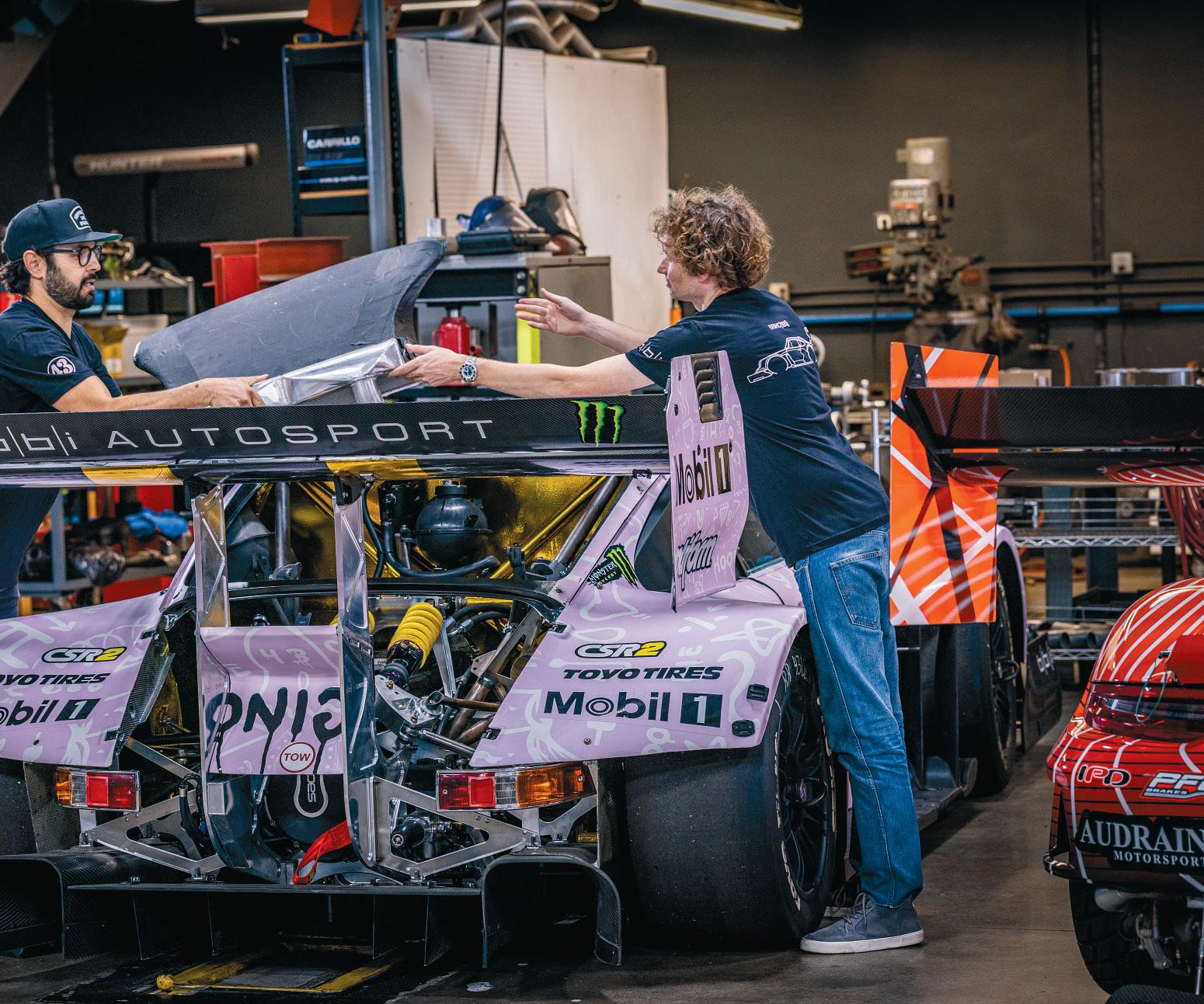
The motorsport to consumer product pipeline
Unfortunately, even with the greatest plans in place, motorsport races are unpredictable by nature. The Pig would drop a valve before even qualifying for the race, leaving a disappointed Block and the BBi team to look ahead toward the 101st “Race to the Clouds.”
Though disheartened, Betim remains upbeat about the lessons learned leading up to the race and how they’ll translate to their consumer products division.
“There’s a trickle-down effect from our motorsport division to our consumer product division,” notes the Porsche-loving-kid-turned-BBi-founder. “We found with almost the click of a button, Fusion 360 is capable of exporting our 3D models to our CNC machine to manufacture right then and there, ending up with a finished part that is ready to hit the racetrack or ship out the door to our client.”
As for Pike’s Peak, “We’ll be back. A little wiser, always humble, but no less hungry.”
Learn more about Fusion 360 here: https://www.autodesk.com/products/fusion-360/
Sponsored content All images courtesy of Autodesk
MORE THAN MEETS

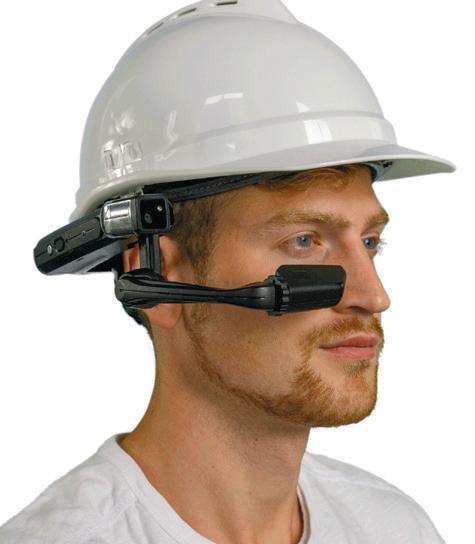
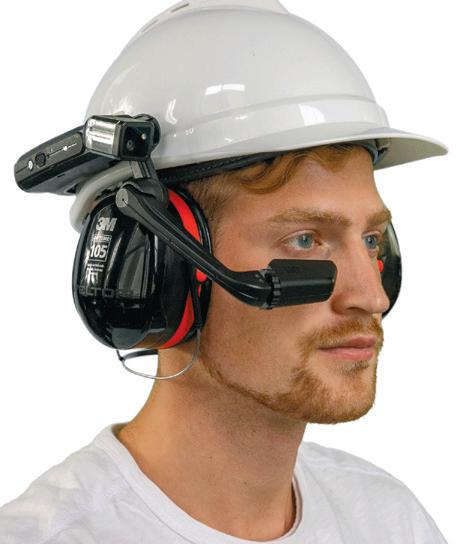

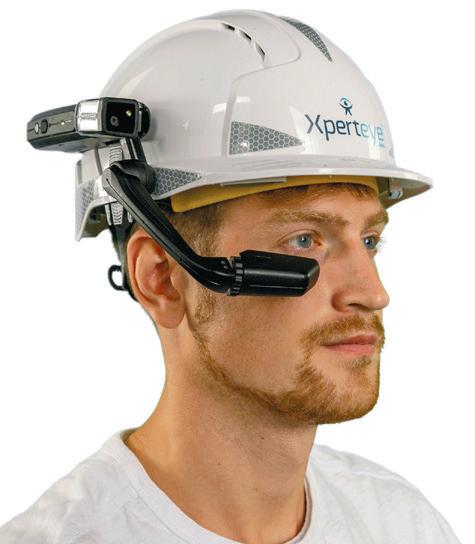



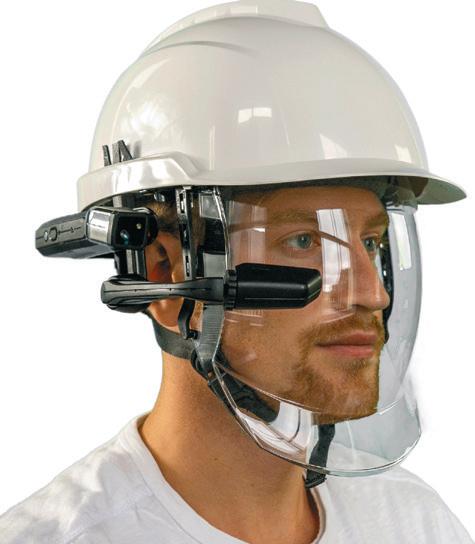


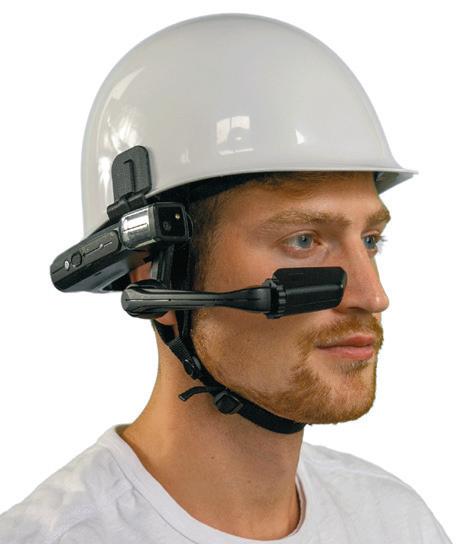





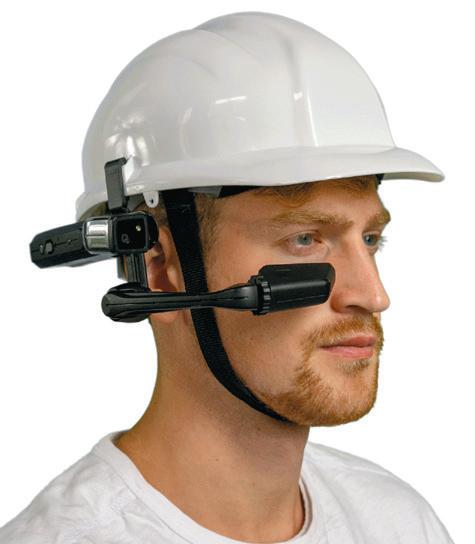






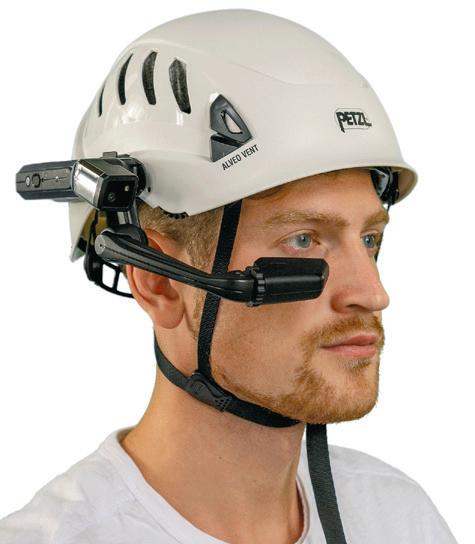





20 DECEMBER 2022 / JANUARY 2023 DEVELOP3D.COM
MEETS THE EYE




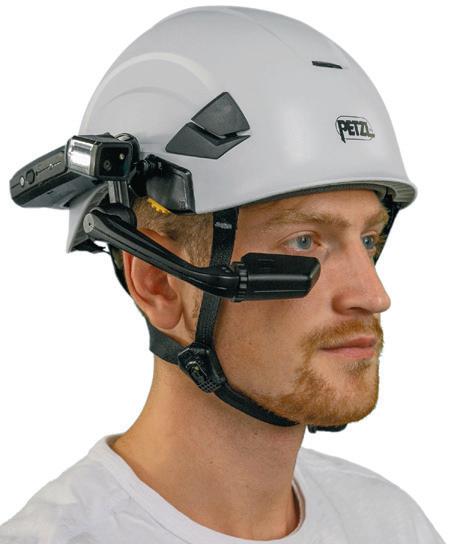





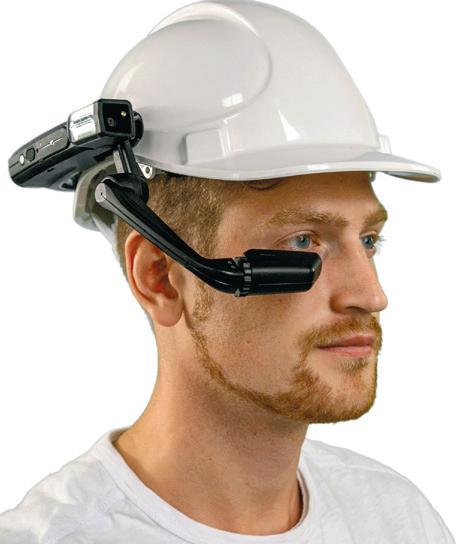






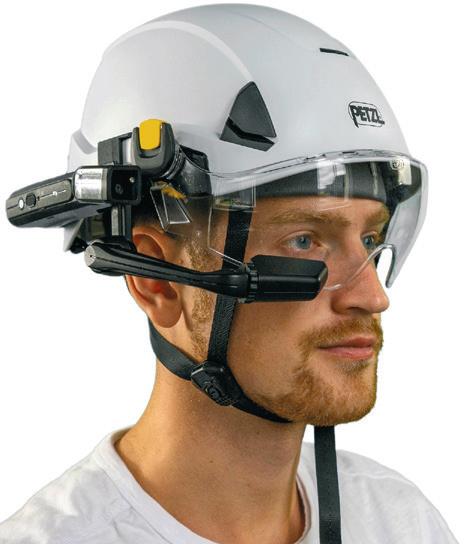


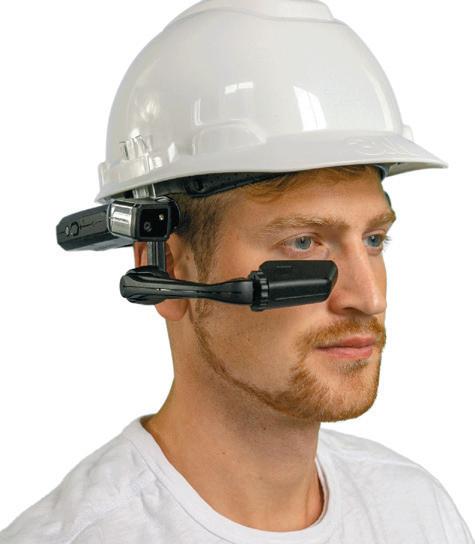









DEVELOP3D.COM DECEMBER 2022 / JANUARY 2023 21 COVER STORY
Put yourself in the steel-toe capped work boots of a lift maintenance engineer for a moment.
Responding to an issue, you put on your new head-mounted, mixed reality headset, which is going to show you how to identify and fix the problem through vivid, overlaid graphics. You stride towards the elevator in question – and whoosh. You failed to spot the edge of the lift shaft and down you plunge.
It’s not just the cost and complex set-up associated with new head-mounted displays that are off-putting, says Noah Balmer. It’s also the risks they pose when a user has bright lights blasting both eyeballs.
“Yes, you can see through it – but it’s like when you see something in your peripheral vision, for example. You know, something’s there, but you have to actually look at it to see it. And when you’re looking at something, you have blind spots everywhere else.”
Balmer is director of product design at RealWear, a company that since 2016 has produced head-mounted displays that position a screen close to the wearer’s eye, but leaving their view unencumbered. Marketed as ‘assistive reality’, RealWear’s products are built solely with industrial use in mind.
For most industrial maintenance workers, he says, the jump from laminated print-outs of work instructions, say, to hi-tech, mixed reality headsets is far greater than you might imagine.
“With our device, it’s a lot easier for people to wrap their head around, or have it wrap around their head!” laughs Balmer. “We can just explain to them that this is a normal display. It doesn’t have holograms that dance around, you don’t need to develop new models, or digitise every schematic you have in your factory.”
RealWear’s products, such as the latest Navigator 500, offer a screen similar to a digital viewfinder on a camera. Once your eye is up against it, it looks like a big display. It’s often compared to a hands-free mobile phone display.
For someone needing to read page 132 of a PDF, while wearing gloves and goggles inside of a crawlspace, having to consult a document or a tablet is not ideal. A bunch of laminated papers is still the norm at many companies, according to Balmer. “They wake up in the morning, and they print out a bunch of crap. And then they laminate it. They’re all there fighting over the lamination machine!”
The Navigator 500 connects to WiFi or can be fitted with a modem. It can connect, for example, to a Microsoft Teams call, its camera capable of putting an expert on the other side of the world at eye level with the problem at
RealWear’s handsfree technology can quickly get expert eyes on a technical issue, via a standard Microsoft Teams call
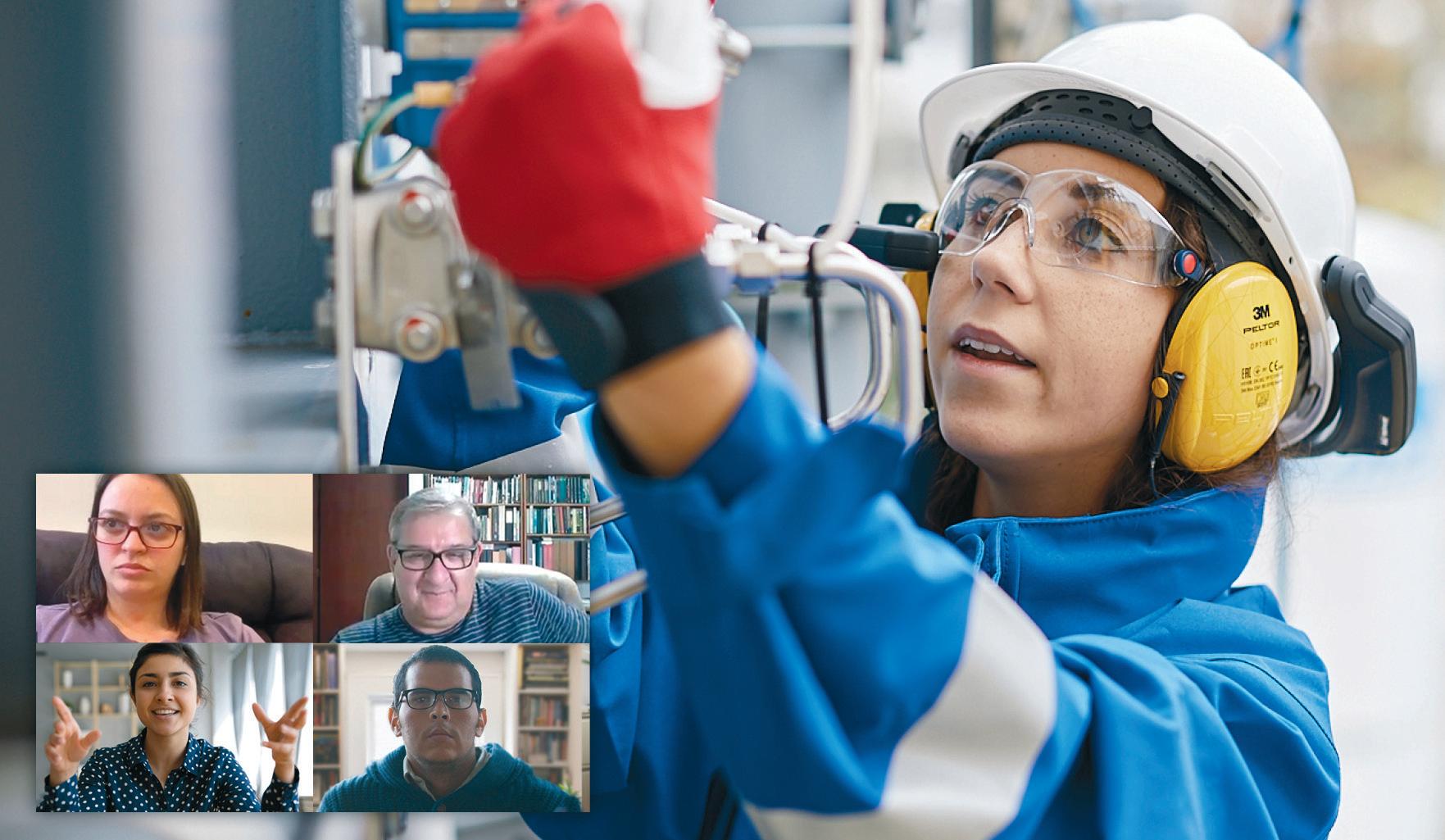
22 DECEMBER 2022 / JANUARY 2023 DEVELOP3D.COM COVER STORY
» Hands-free access to documentation is a godsend for workers operating in awkward or high-risk environments. Stephen Holmes talks to RealWear, a company behind wearable technology that prioritises industrial needs and winning fans in work environments ranging from oil rigs to operating theatres
hand. Or it can bring up video for a walk-through of how to conduct a repair via its screen.
While many new augmented and mixed reality (AR/ MR) headsets have been launched, few companies yet have detailed models for their service workers to use.
“Most of the time, they’re printing out a PDF,” says Balmer, “There’s no way they’re gonna get to the next level of augmentation.”
UP TOP DESIGN
Before RealWear even started, its founders were already working in different companies, learning about optics and head-mounted devices. Using Human Factors and User-Centred Design principles, plus all they had learned about optics and how the human eye works, they began to build industrial headsets.
A lot of this is based around the shape of the human head, and the fact that what might be a perfect fit for one person may be huge or a tight squeeze on another, given their very different head dimensions. Eye dominance also plays a role, especially for a product that might be worn all day, hence RealWear’s display arms can be flipped to accommodate this.
In an industrial space, there’s also the challenge of PPE – personal protective equipment. Many countries have different hard hat designs to meet varying safety certifications, so everything is slightly different.

(RealWear offers around 50 different clip designs for
different hard hats.) And you can add to this mix a wide range of use cases. A wearer might need ear defenders, for example, but then they can’t wear the device under the brim.
A lot of this product development work and identifying specific problems comes down to physical prototyping. At RealWear, much of this is down to the framework set out by Balmer’s predecessor.
“The guy that I replaced, Stephen Pombo, was a pretty famous guy around this space. He was a model maker in the Bay Area for 30 years. He worked on original models for Apple computers and for Atari. He worked on some Star Wars assets for Industrial Light & Magic,” says Balmer.
“He hired me, and long story short, I realised that sketching models, scratch builds, these kinds of things, are way more important than people realise.”
The development process at RealWear begins with masses of brainstorming and consideration of specific customer requirements, but very quickly, moves into physical prototyping.
Balmer models most of the concept designs in Solidworks, and then 3D prints quick models for assessment on a desktop Prusa in his home office, in order to get an idea of how something might work or sit on the headset.
For presentation models, he steps up the design to the two workhorse Markforged Onyx 3D printers at RealWear’s design studio. “Those things just print every time. I’ve done like a 26-hour build lots of tiny parts –and it just works every time. It’s miraculous!” he says. These prototypes are vitally important, he says.
“You can have bigwigs in a room talking, and you’re not gonna get anywhere until you put something on someone’s head and see if they like it or not see if it hurts their brain! Part of what I do here is make a ton of working models, and then test them on people. And that’s really, I think, the key to success for anything that goes on the human body, especially.”
A lot of Balmer’s role involves concepting, research and user studies. His design team, meanwhile, boasts plenty of CAD geniuses.
“I’m pretty good, but you know, there are those masters,” he says. “They’ve been doing it for 10,000 more hours than me, and I’m not going to catch up anytime soon while I read all these emails!”
A new display in a different form factor might begin life as a development circuit board hanging off a headset made of cardboard and 3D-printed parts. This, according to Balmer, is because he doesn’t want to be married to any single idea.
“If I make a model that takes two months, I’m really going to have to make it work, you know? But if I make it out of cardboard and I show it to people, they’re not
● 1 Lightweight and rugged, RealWear headsets can handle long hours in difficult environments
● 2 Ball joints allow for perfect screen positioning, even when working in cramped conditions

● 3 Thorough concepting work is key to achieving the best fit and comfort levels in RealWear headsets

DEVELOP3D.COM DECEMBER 2022 / JANUARY 2023 23
1 2 3
‘‘ This is a normal display. It doesn’t have holograms that jump around, you don’t need to develop new models, or digitise every schematic you have in your factory ’’
worried that there’s a big investment. If I show it to the CEO, he’s not worried that we’re gonna lose hundreds of thousands of dollars, because we have to zigzag from this specific concept,” he explains.
“It doesn’t feel scary to them, because it’s just like, ‘Oh, it’s fun.’ It’s like a costume and it looks stupid and there’s wires hanging off it. They feel like they’re part of something.”
As the design progresses, and more models are tested, the design eventually transitions into PTC Creo for detailed mechanical engineering and production, with every element built in 3D CAD, right down to the last chip on the custom board. “In the beginning, it’s all about ‘fake it till you make it.’ Then you start getting into real mechanical and electrical engineering and it has to get more locked down,” says Balmer.
Loadbearing models are outsourced to Protolabs to be made using SLS 3D printing. CNC models are produced for final testing with all the electronics fitted in place.
The headsets feature a lot of metal components, in order to be able to stand up to industrial use. A ball joint for the display could be skimped on to save costs, says Balmer, but then you’re opening up the product to flaws. If it isn’t a ball joint, then it can’t be adjusted to achieve perfect horizontal levelling for the user.
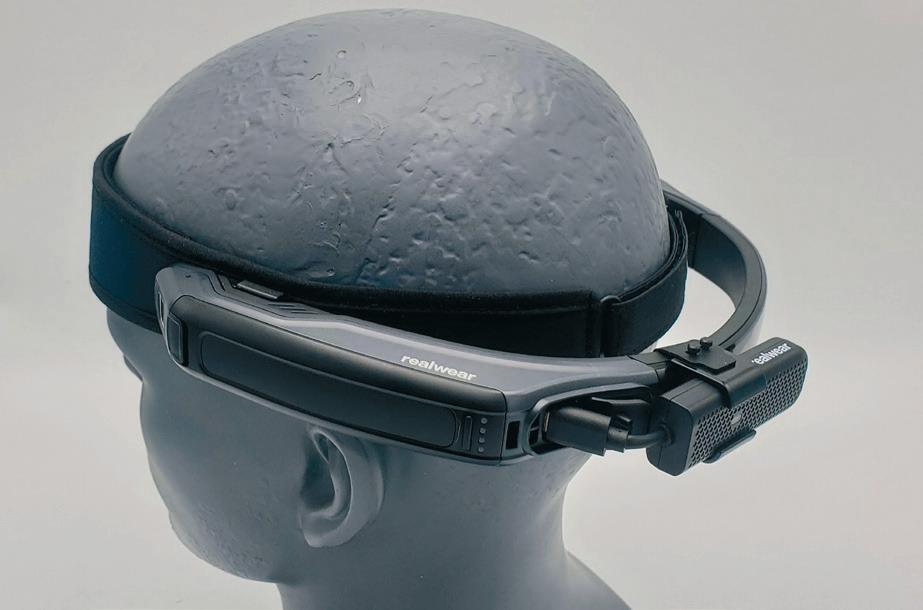
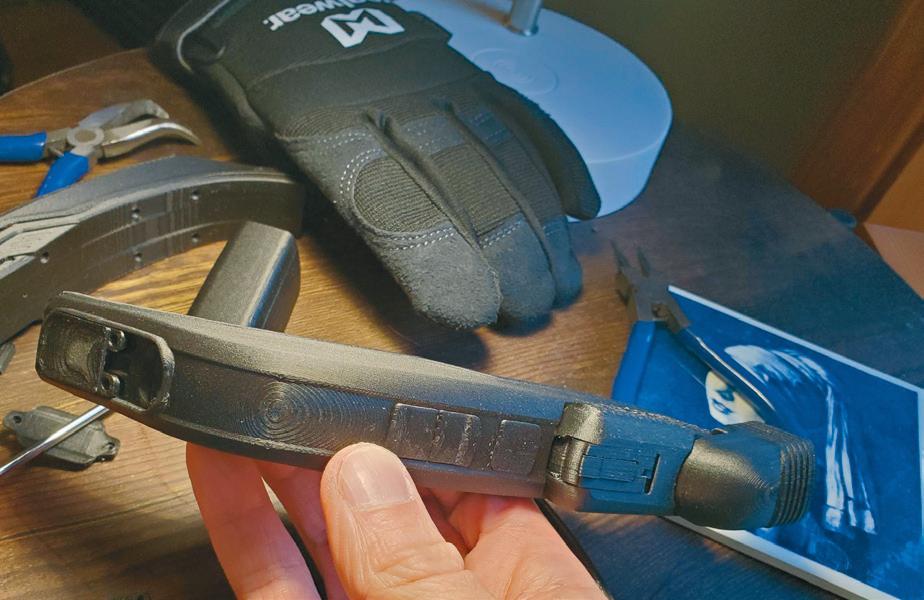
“Why would that matter? It’s just a little bit, but I don’t know if you’ve ever mounted a TV to a wall one inch off [level] or something like that? It doesn’t feel good, like your brain has to somehow rotate five degrees. It takes more processing and brain power.” Such is the drive to achieve the best level of everyday comfort.
CLEVER COMPONENTS
The industrial settings in which the headsets are designed to be worn add further levels of complexity. Drop-tests are rigorous, while the need to balance strength with weight reduction leads to a lot of FEA work to assess the best placement of internal ribs and screws. As a result, the latest model weighs, on average, only two-thirds what its predecessor weighed.

● 4 Modular designs enable custom elements, such as this tiny modem, to be fitted
● 5 Designs need to be versatile to accommodate different combinations of helmets, visors, goggles and masks
● 6 3D printers from Prusa and MarkForged play a key role in the prototyping process at RealWear
● 7 Prototypes are created to test different variations of colour, materials and finishes
● 8 RealWear designers work fast, using sketches and scratch models to ensure that design and prototyping processes stay nimble
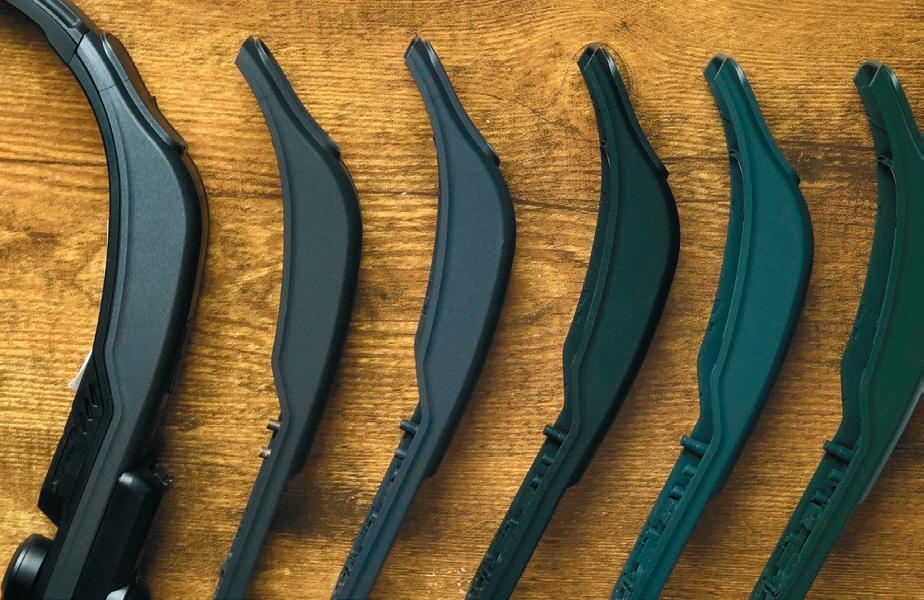
24 DECEMBER 2022 / JANUARY 2023 DEVELOP3D.COM
‘‘ What I do here is make a ton of working models and then test them on people. And that’s really the key to success for anything that goes on the human body ’’
6 7 4 5
Modularity is another key factor. With a huge range of add-on components and features, the headsets can be customised for all kinds of roles.
“It makes sense in this world, because we’re using components from the smartphone industry. You get a camera from a smartphone, and in two years, they don’t even make that camera anymore. It’ll be some newer camera,” says Balmer.
“And so, for a business, it actually makes sense, because you can lengthen the lifespan of the overall product by offering accessory modules to make it more powerful.”
The latest model now offers a spring-loaded metal slide switch for the camera connector unit that allows the user to swap it for a different type of camera – such as specialised wide angled or thermal imaging kit – or for something else entirely, like a laser or a flashlight.
And if it turns out that a customer has a very specific requirement, then the headset proves far more versatile, and won’t require a full redesign to accommodate those needs.
Rugged aesthetics, such as overmoulded TPU bumpers, are designed with industrial use in mind, while Balmer suggests that other glasses companies have fallen into the trap of “trying to be a fashion brand.”
Donning a RealWear headset, he says “This looks pretty silly on me, but if I’m in a factory and I’ve got goggles and gloves on, it doesn’t matter that I don’t look like Blade or Vin Diesel or something!”
This versatility is a real strength, enabling RealWear to grab the attention of professionals in a wide range of sectors. Surgeons and cleanroom professionals love the devices. This widening market means that, over time, the design team will be looking to make products even more versatile.

As well as modularity, the latest model offers different head mounting options, including a lightweight, washable, soft headband option.
“For a medic performing surgeries, this is a much better design than a bump cap, or a hard hat, or some strappy thing,” explains Balmer. “[The Navigator 500] is kind of a chameleon, in that it can have different cameras, different sensors and different mounts on it for what you need in your industrial space or in your environment.”
RealWear is more accessible than many wearable devices, with its clever design allowing for a vast range of configurations and possibilities. That is enabling the company to plan clearly for the road ahead, spotting any proverbial lift shafts well before it steps into one.
www.realwear.com
DEVELOP3D.COM DECEMBER 2022 / JANUARY 2023 25 COVER STORY 8
‘‘
’’
With our device, it’s a lot easier for people to wrap their head around it — or to have it wrapped around their head!
HITTING ALL THE RIGHT NOTES
Whether upright or grand, a traditional piano isn’t always a good fit for a contemporary living space. Stephen Holmes speaks to the team behind Casio’s Privia range, which has been hard at work on a design more in harmony with modern customer lifestyles

PROFILE
Casio’s bold new Privia PX design is in tune with the needs of modern musicmakers

Learning to play a musical instrument is a pastime that many pursue in their youth, only for their acquired skills to lie dormant in adulthood.
With a full-size piano taking up a considerable amount of room in a compact modern living space, former pianists face particular challenges when it comes to reacquainting themselves with their instrument.
It’s these thwarted musicians that Casio is targeting, introducing new models in its slimline home range Privia, designed to get them back to playing music again.
The design team is based in central Tokyo, near Shinjuku, but its research mission took it to London. Speaking to people who had given up playing the piano, team members found that a key issue was indeed the physical form of the piano. In short, traditional pianos were judged to be too large or aesthetically incongruous with home interiors.
“They felt those pianos were difficult to play with family or friends, and lonely to play alone, because the installation area is most of the time limited to the wall, so they simply gave up playing again,” says Shuhei Nakamura, an assistant manager in the product design department at Casio.
With these findings in mind, the team headed back to Tokyo and began the process of redesigning the piano to harmonise with people’s daily lives and at a scale better suited to modern homes.
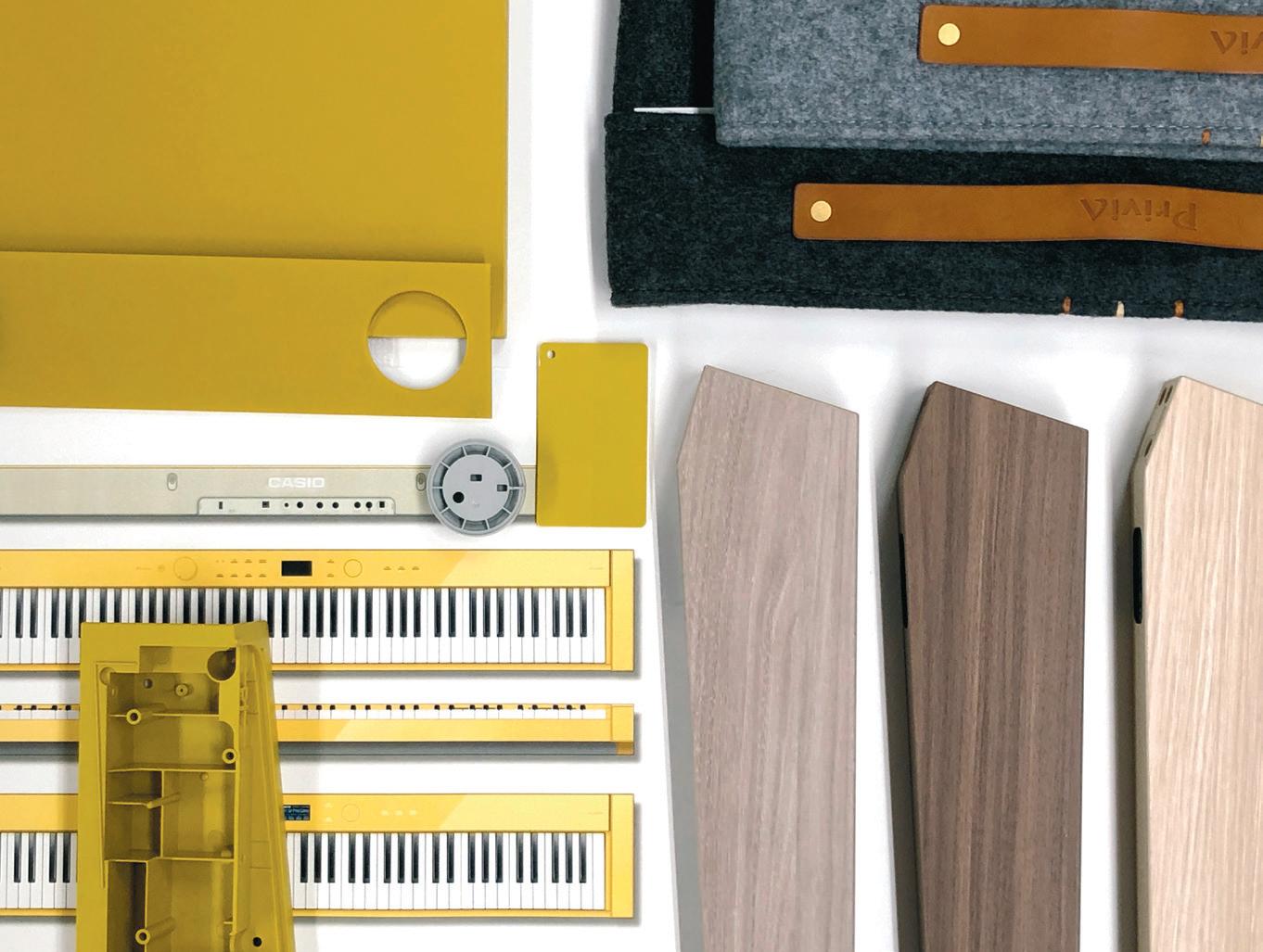

ALL TOGETHER NOW
For the new PX line-up, a team of nearly 50 people was involved, drawn from several divisions dedicated to different technological aspects of the product.
Of these, six were responsible for the visual identity of the piano, working closely with a hardware design and engineering team of 10, who took charge of identifying the right materials, structure and exterior.
“We created four types of concept model in two batches before the final product design stage, since the new Privia series targets new users and an unprecedented market,” explains Nakamura.
A lot of effort went into the concept process, much of it involving hand-drawn sketches. These, Nakamura says, led directly to an innovative design being born: “It was a distinctive design that was unfamiliar as a piano at the stage of the internal discussion.”
Once the final design theme was chosen, the process then moved into 3D CAD with PTC Creo used to further develop
the product, to add in the electronic elements and to enable the model to be mass-produced.
The PX range includes new elements never seen before in Privia products, so there was a lot of engineering to be carried out. In particular, developing the unique stand with its three-pedal unit proved a challenge in terms of meeting Casio’s strength criteria. This demanded structural studies and CAE evaluations of dozens of variations before a final design was reached.
In addition, a newly developed housing composed of wood and resin was designed to improve the acoustic characteristics of the piano, while retaining a slim and compact aesthetic. The development team achieved this by testing several variations using computer-aided engineering tools, allowing for a functional design capable of housing the inner electronics to be built as close as possible to the original design intent.
COLOURS AND TEXTURES
Colour and finish were extremely important in creating a design for the PX range that could either seamlessly blend into the background, or stand out as a focal point, depending on the preference of the customer.
“Once the shape is decided to some extent, the general flow is to examine the colours and textures with CG sketches,” explains Casio mechanism development engineer Takahiro Moriya.
The polished finish on the ‘Harmonious Mustard’ coloured model – a radical departure from traditional black-and-white finishes – uses the same high-gloss method as an acoustic piano, with its lustre attained from multiple applications of paint and polishing.
“To express the ideal colour directed by our designer, we went through a number of trials right up until we started mass production,” explains Moriya, adding that this special colour, rarely found on a piano, was chosen for its ability to harmonise with virtually any room’s interior, while adding a touch of elegance to the living space.
To help maintain the analogue form of a piece of furniture, while boasting all the digital capabilities required for a professional-quality instrument, the design team used ‘stealth printing’ for the console area.
“Our intention was that it’s best that the button seems like it doesn’t exist on the console when the LED is off, as it may give a gadget-like impression if any of the letters can be seen through while we want it to look like an interior piece,” says Moriya. With this method, the musician is able
28 DECEMBER 2022 / JANUARY 2023 DEVELOP3D.COM
1 2
‘‘ We created four types of concept model in two batches before the final product design stage, since the new Privia series targets new users ’’
● 1 After conducting initial research in London, the Tokyobased design team headed home to begin its concepting process
● 2 CMF took centre stage for this piano, as Casio strove to create a product that would harmonise with modern home interiors
● 3 Pen-on-paper sketching proved valuable in the process of creating the new design
● 4 Foam prototypes enabled the design team to quickly ideate on scale and angles
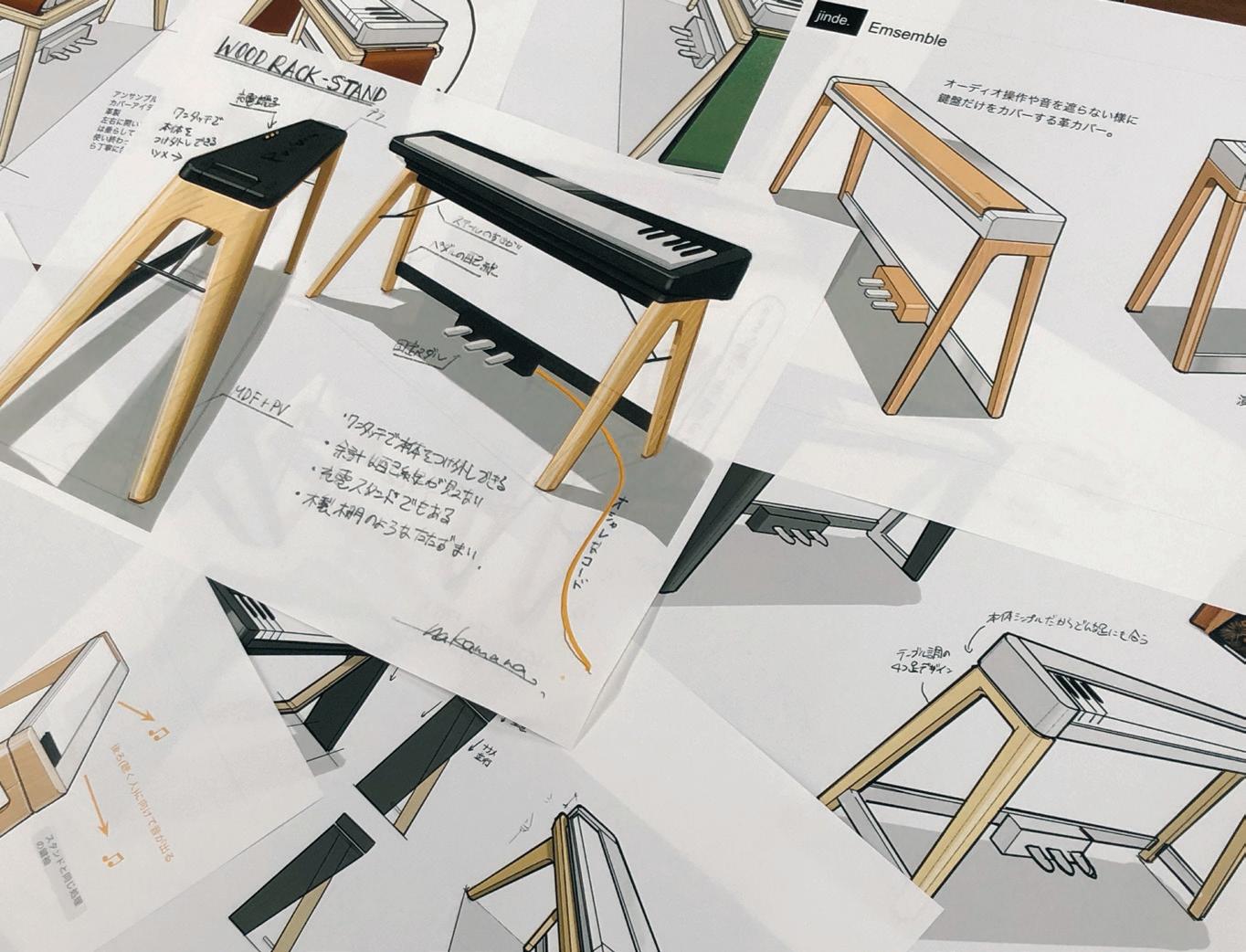
● 5 Marketing renders were created to virtually showcase the depth of colours, materials and feel of the product
to see touch buttons when the device is in use, but only a satisfyingly smooth surface when it is turned off.
A key element throughout the development was the use of physical prototypes to further evolve the design. This included initial foam concept models, to evaluate the size and form of the keyboard, and fitting internal electrics into a 3D-printed prototype casing to test sound and playability. Physical prototypes were also used to determine the final production moulds, to confirm consistency between CAE evaluation and actual product, and highlight any issues that might be difficult to determine under CAE evaluation.

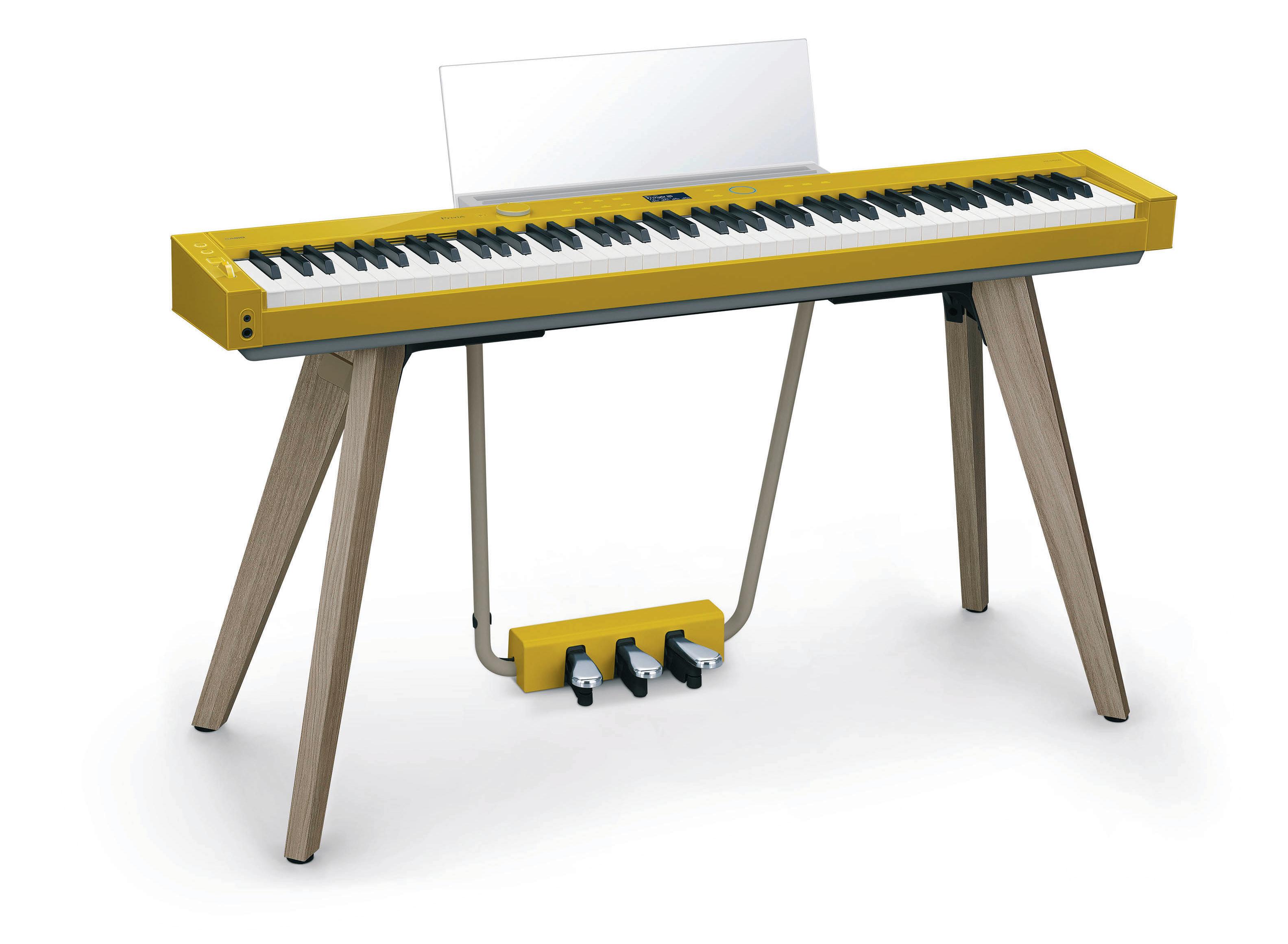
The digital work continued with Casio working alongside a regular production partner to create the marketing visualisation artwork from CAD data. “They have captured our intention very well of how the product should be portrayed, so that the users can feel the colour and texture of the product,” concludes Moriya.
With its compact profile, minimalist mid-century aesthetics and high-end finish, the new additions to the Privia PX range have been designed to appeal to a wide range of musicians, enabling them to hit all the right notes. www.casio.co.uk
3 4 5
The devil is in the details. In the fashion world, the interior finish of a dress or the design of a tiny button can transform an everyday garment into one that exudes high quality and luxury.
Headquartered in Padua, northern Italy, Eurominuterie produces billions of stamped small metal details for the fashion industry each year. Its output includes decorative elements, internal components, buttons, eyelets, rivets, rollers, hooks and lace feeders for footwear.

Although these components are generally small and simple, they are the result of a careful design study and a production process that involves several stages.
The process starts with a client request, typically for a new or customised design. Team members from the production department at Eurominuterie studies the
30 DECEMBER 2022 / JANUARY 2023 DEVELOP3D.COM
Buttons, eyelets and rivets are just some of the detailed metal parts designed and manufactured for the fashion industry by Eurominuterie. Claudia Schergna spoke to the team to find out how digital tools help deliver those final flourishes for a garment
ONTHEBUTTON
brief and draws on the company’s catalogue, where they can find years’ worth of designs for previous projects. They then make the necessary changes and add some new elements, to come up with something as similar as possible to the item requested by the client in terms of functionality and style. And finally, they work with the technical department to select the best technologies and materials to realise the project.
With over four decades in the industry, Eurominuterie is able to offer a wide choice of processing to enhance a finished product, while also helping guide clients with creative solutions for customisation, says CEO Alessandro Rigato.
For example, he says, “we have developed a refined painting technique that allows the items to maintain strength and aesthetic appearance without giving rise to oxidation or staining.”
IN-HOUSE MOULDS
As well as producing individual components, Eurominuterie also makes its own moulds in-house, giving it the flexibility to respond to customisation requests, while also reducing production costs, material waste and delivery times.
Moulds for each component are designed using Cambrio Cimatron, which allows the team to visualise the piece and estimate the quantity and cost of material needed. The pieces are stamped on sheets of metal using CNC machines, which are also programmed using Cimatron technology.
Stamped parts then undergo a galvanic process to apply aesthetic and protective treatments by adding a thin layer of metal deposited by electrolysis onto surfaces. These can be more valuable metals like gold, silver, or nickel, giving the product the lustrous finishes desired by the client.

DEVELOP3D.COM DECEMBER 2022 / JANUARY 2023 31
Technology from Cimatron enables Eurominuterie to create fashion details with passion
PARAMETRIC DESIGN
Eurominuterie’s digitalisation process began when the engineering team felt the need for CAM software to help programme its growing number of CNC machines. Once they saw how much the adoption of such technologies aided workflow and how it revolutionised production, they never went back.
Cimatron was chosen in part because of its capabilities with parametric design, explains Rigato, “a method that does not focus on individual results but describes the entire design process, allowing us to automatically, or almost automatically, infer many design variations, promising to increase our competitiveness and profitability.”
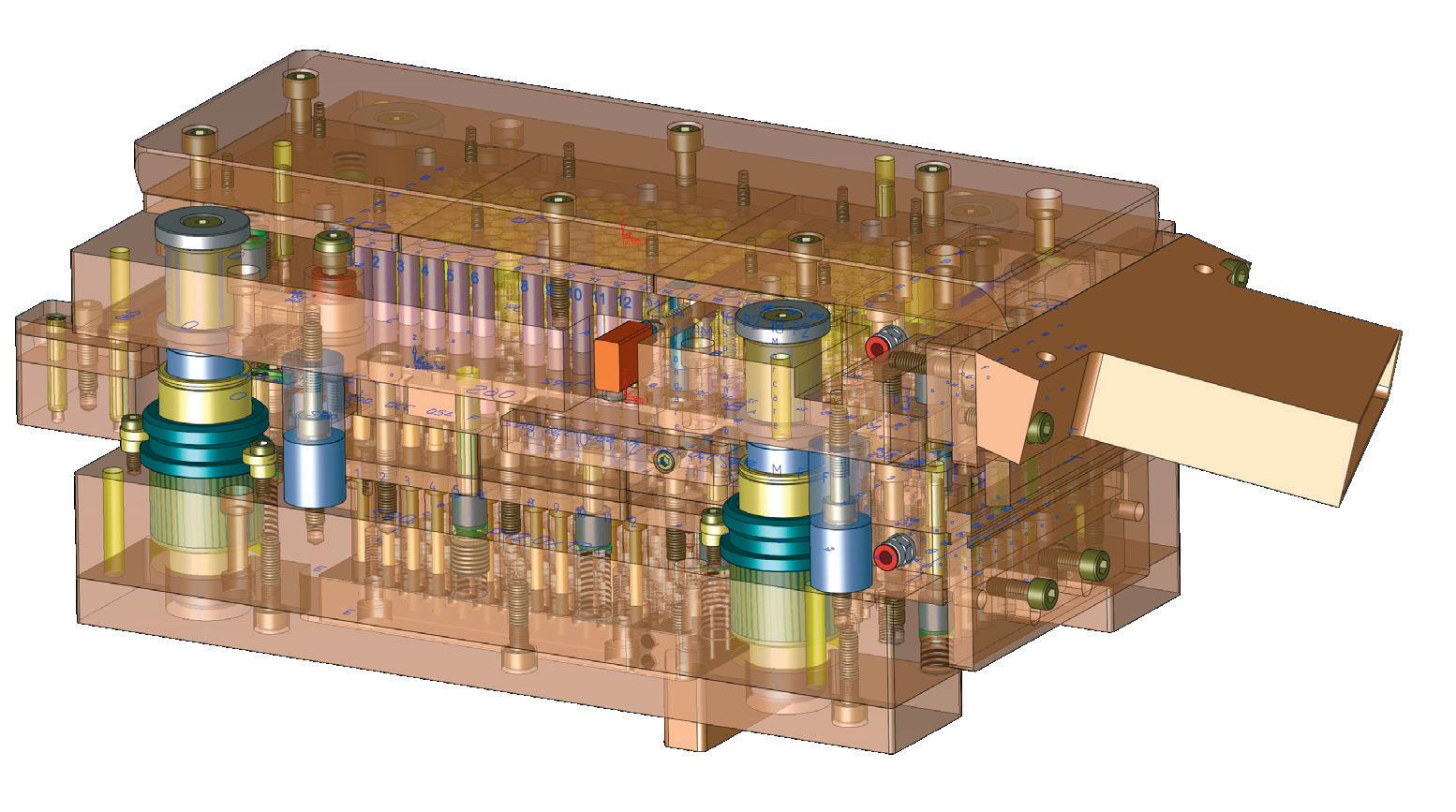
The ability to reuse data and develop it further from project to project enables changes to be made with greater ease, he says. Cimatron offers several modellingto-analysis functions that help speed up delivery times and cut costs.
One of these is mould set-up, which allows the team to create 80% or more of the mould. Beyond that, only a few new parameters need to be entered to create a unique custom design.
“Over time, we have set up several basic mould structures in the company: those that are not needed in a new project are simply deleted, then we only need to modify other parts,” explains Rigato.
“The work is completed really quickly. In cutting and punching, the tools in the system from the earliest versions were already very advanced. Now, with the updates and upgrades that Cimatron regularly provides, even the deep-drawing strips can be designed very quickly and reliably. They have given us great advantages in these phases.”
Thanks to this feature, every change is updated in the drawing and all CAM procedures involved. In this way, the parallel design capability enables Eurominuterie engineers to start working on CAM programming even if a design process is just at the beginning stages.

RIGOUROUS, LOGICAL AND INTUITIVE
Rigato points out that the team has developed its own control model for the designs, with a scheme to follow that is available to all technicians, which improves the quality and reduces errors substantially.
The system makes it possible to define precise rules according to a chosen operating standard with which everyone can comply. This might include positions, diameters, rank, applied technologies and tool combinations, for example.
“In reality, the correct way to proceed is dictated by the system itself; the sequence of operations is rigorous, logical and intuitive,” says Rigato. “After constructing our reference formulas, the mould almost assembles itself.”
When it comes to CAM, although the steps at Eurominuterie are not particularly complex, the integration that Cimatron provides between design and machine tool

programming makes the workflow smoother.
“The technology in our industry has not changed much on the method,” says Rigato, “but the way we build today allows us to save literally hundreds and hundreds of hours, not to mention labour. We could never go back from digitisation.”
The digitisation of the product development through manufacture has given Eurominuterie’s team more design freedom to deliver truly unique pieces, each of them capable of catching the eye. www.eurominuterie.com
● 1 After modelling and stamping, the process moves on to the milling of components
● 2 Cimatron Die allows the team to visualise pieces such as eyelets and estimate the quantity and cost of material in advance
● 3 Users can construct the geometry of the mould and utilise that knowledge at subsequent stages in the design process
32 DECEMBER 2022 / JANUARY 2023
PROFILE
1 3 2
















































































































































































































































































































































































































































































































































































































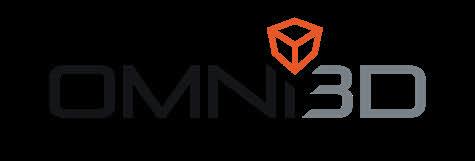








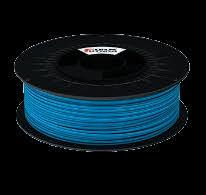

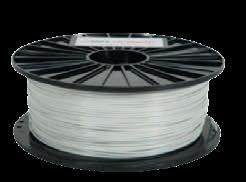




WINTER SALE up to 40% Off replik8.co.uk Prices are subject to the items being in UK stock. Stock is limited for some materials. All filament is 1.75mm diameter. Discount is off the current published price or the manufacturers list price. Sale ends on 31st January 2023. Payment is via credit card, paid online. VAT & shipping is added in the checkout. 3D PRINTER FILAMENT
CLICK AND
Born from a young couple’s desire to democratise additive manufacturing, Makelab is a 3D printing bureau like no other. Makelab CEO and co-founder Christina Perla talks to Claudia Schergna about the company’s values and vision

‘‘
Makelab is a different concept. We try to attract creative souls, which is a niche. I don’t think many people in the industry do that
Upload. Print. Collect. That’s how most print shops work today. What if 3D printing could be just as straightforward?
This is the mission behind the 3D printing service bureau Makelab. Based in Downtown Brooklyn, New York, Makelab is very unlike your typical printing facility. Small, bright and spotlessly clean, desktop 3D printers and post-processing machines are arranged neatly on shelves around the lab. A small dog wanders around the office, while the staff chat over their lunch.
“Makelab is a different concept,” says Christina Perla, confidently. The Makelab CEO met Manny Mota, her co-founder, at Pratt Institute, where she was an industrial design student, and he was working as a shop technician. When they first approached the additive manufacturing (AM) industry, they quickly realised that most services were inaccessible for small businesses, freelancers and students.
Some years later, having established themselves in the industry, they came to recognise that the gap in the market that they had spotted as students was actually more like an abyss.

PROFILE
’’ 1 4
AND COLLECT
A MODERN APPROACH
Repeatability and profitability are the pillars on which the Makelab business was built, Perla explains. Local service, an open-door policy and face-to-face contact are what attracts customers and “makes them stick”, she says.
The relationship with customers, meanwhile, is always post-order: “We are not a consultancy,” she clarifies. “Most of our orders come from direct print online.”
An analogy that works with investors, she says, is to position Makelab as an AM version of the Kinko’s chain of copy shops, now part of FedEx. While there are clear differences, she adds, “it really explains the multilocation play that we’re going for, the hyperlocal presence and the culture we have here.”
Another similarity is that, for Makelab, no order is too small. Most customers will submit an order quantity of one at first, because it involves the lowest risk. Once they have the results in their hands, they frequently go on to order larger quantities.
Makelab’s most recent projects range from kitchen tools to supports for card games, from jewellery to packaging, and from fem-tech to art installations.
Having such a wide customer pool can be a doubleedged sword. On one hand, it brings more business opportunities. On the other, it might lead to scepticism,
given that other bureaus often specialise in serving a single industry. “The risk is that we might look unfocused,” says Perla.
“We try to attract creative souls, which is a niche. I don’t think many people in the industry do that.”
Another thing that sets Makelab apart from other bureaus is the fact that it doesn’t own any ‘industrial’ 3D printers. While Perla doesn’t rule out investing in these at some time in the future, she says that desktop alternatives offer many benefits without compromising on quality.
“I think the desktop has its place. And when you’re thinking about profitability, smaller modularity and repeatability, this stuff shines,” she says.

“I’d much rather have 34 of these than two big industrial ones,” says Perla, indicating Makelab’s Prusa i3 FDM printers and its Form 3 SLA printers from Formlabs.
When setting up the company, Perla and her team worked on five different types of machines. Moving forward, they decided to stick with Prusa and Formlabs, based on the alignment of values and roadmap between Makelab and these suppliers.
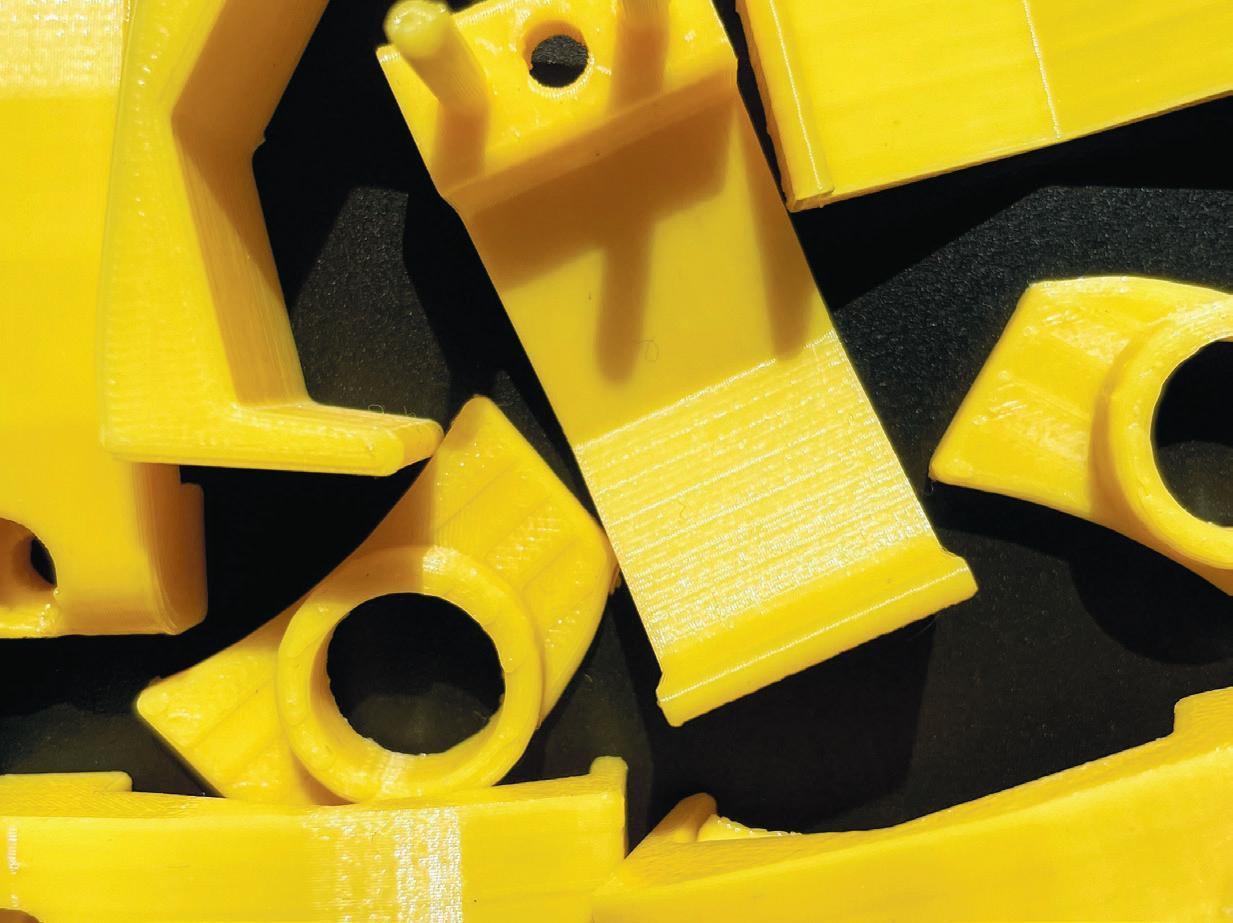
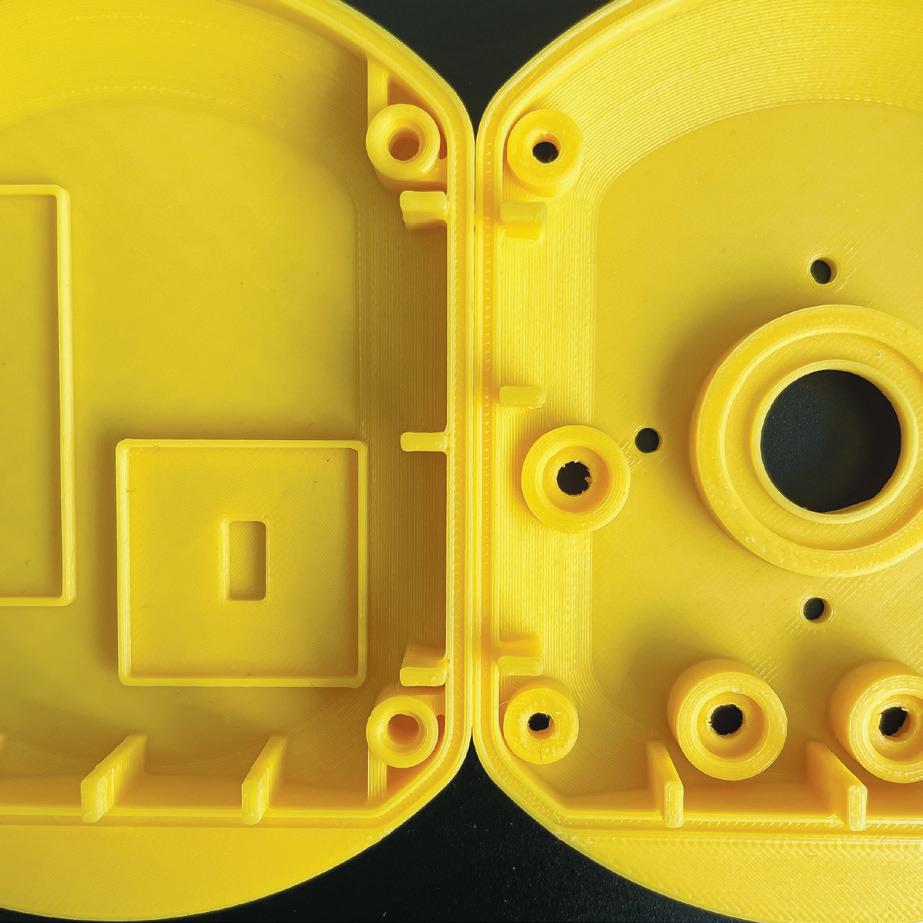
A SIMPLIFIED PROCESS
“Printing is actually the easiest part of the business,” explains Perla. “We know the set of materials. We know
2 3
● 1 ● 2 ● 3 Makelab prints custom parts for a huge range of applications
● 4 Christina Perla is CEO and co-founder of Makelab
what kind of files we’re going to see. We can predict what kind of printability issues we’re going to run into, and know how to solve them.”
Before going to print, Makelab will make a few tweaks to ensure that the print is successful, using Solidworks and Materialize Magics. “We do draw a line between creative direction and just 3D modelling for customers,” explains Perla. “We believe that the customer should own their own creative process.” Customers then select materials, set their timeline, check out and pay.
Fast delivery and collection times – which range from next-day to seven days – are another core element of Makelab’s vision: “We want to be designers’ and engineers’ right hand, be their teammate. You don’t say to your teammate, “I’ll do it next week!’”
If efficiency, automation and repeatability describe Makelab’s approach to production, ‘customer-centric’ is how the company sums up its culture. It’s also focused on community, an ethos reflected in its hiring process. Makelab’s team is expanding fast and diversity, in terms of gender, race, age and background, is a central pillar.
“Our team ranges in age from 20s to 60s, and I love how diversity informs decisions,” says Perla. “We’ve gone very purposefully for people who will challenge each other.”
Being a woman of colour in a male-dominated industry, it wasn’t easy for Perla to make her mark as CEO: “At the beginning, I was more intimidated. Now, I lean on my strengths and on what I bring to the table,” she says.
Besides her work leading Makelab, Perla has also served as the New York ambassador for Women in 3D Printing, a community that aims to inspire and support women in the industry and that campaigns to increase diversity and close the gender gap.
Considering the speed with which Makelab has expanded in the past few years, Perla is confident that the future holds great things for her company. In five years, she predicts, Makelab will be on its way to being “one of the most well-known brands in the additive manufacturing space.”




What makes her business successful? It’s not down to one big thing, she says: “It’s all the small things.”
These ‘small things’ include a strong online presence, a community-based culture and a modular work environment that can be replicated in other locations. (Next stop: a new, identical workshop in Manhattan.) But above all, it’s an innovative vision that aims to democratise and simplify 3D printing, transforming it into that upload/ print/collect experience. www.makelab.com
36 DECEMBER 2022 / JANUARY 2023 DEVELOP3D.COM
PROFILE
● 5 There is no fixed order size at Makelab, where orders vary from a quantity of one to bulk orders
5 6 7 8
● 6 ● 7 ● 8 Parts are printed on Prusa i3 FDM printers or Formlabs Form 3 SLA printers and postprocessed before they are shipped to or collected by customers

www.cimatron.com PROGRAMMING DIE DESIGN MOULD DESIGN ELECTRODES INTEGRATED CAD/CAM FOR MOULD & DIE Stay competitive across your operations with dedicated software that delivers major advantages for toolmakers
HUEMEN-CENTRED DESIGN
At DEVELOP3D Live in November, Harman director of car audio and design and Huemen design lead for Europe Philipp Siebourg showcased the design studio’s work to develop immersive user experiences. Along the way, he presented car audio solutions created for some of Harman’s biggest brands in the market, including AKG, JBL and Mark Levinson. In conversation with Claudia Schergna, Siebourg also shared insights into how Huemen, Harman’s internal design group, is looking to go beyond those big brands and develop its unique technologies to bring together entertainment, information and safety for new in-car experiences
Q : At Huemen, you’ve worked for some of the most wellknown brands on the planet. Could you describe your relationship with your clients? How much influence do they have over your design process and how do you make sure your designs are aligned with their vision?
A : The first thing to keep in mind is that it’s not about how the brand is perceived today, but how it wants to be perceived in the future. That’s something that we can’t read in any article.
It’s important that we spend a good amount of time learning about their vision. Because the product that we’re developing together with them has a lead time of three years, something we design today might already be outdated when it comes onto the market. We are always trying to capture the essence of the [customers’] product, the main message, and what we can offer, from the products that we own ourselves, and we try to bring them together. It’s a bit like reading two books at the same time and finding a chapter that is matching.
Q : Huemen has a team of 250 designers and researchers spread around six locations across the globe. How does geographical distance affect your design processes?
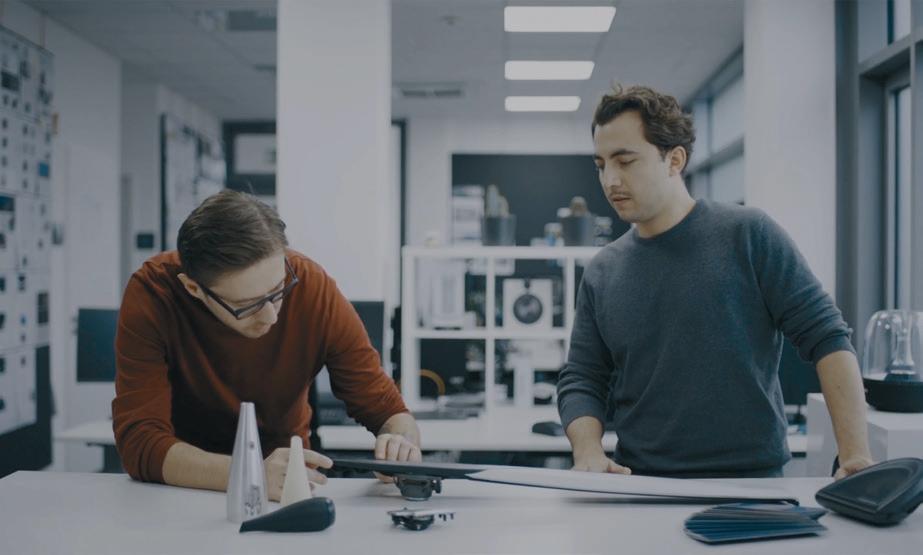
A : We value the fact that all our designers come from different backgrounds, but we also try to standardise the tools we’re working with. For me, it’s important that we are using the same software and tools, so we can share the files and the knowledge. We need a lot of care and attention to detail. It’s great to have one brain that develops them and one brain that makes them accurate, precise, so we can apply them across the globe and have synergies.
Q : What are these tools and why did you select them for your team?
A: We mainly use Rhino and its plug-ins. In Grasshopper, there is no limitation on how you use it, where you can go with it, and how you can script elements. We are also using Python to programme into these scripts, to tailor them to
● 1 The Revel Ultima was designed by Harmon for luxury carmaker Lincoln
● 2 The Hueman team has 250 designers and researchers worldwide
● 3 Harman designs audio systems for some of the world’s best-known brands
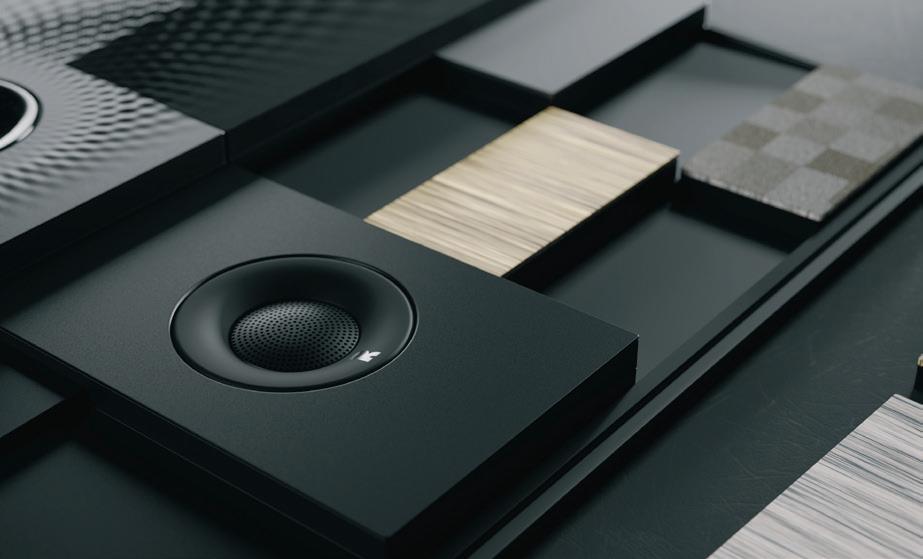

● 4 Ready Care is designed by Harman to improve safety and reduce driver stress
● 5 Philipp Siebourg, speaking at DEVELOP3D Live 2022 about design and customer experience
38 DECEMBER 2022 / JANUARY 2023 DEVELOP3D.COM INTERVIEW
2 3
1
DESIGN
our needs. When it comes to visualisation, we are more and more in need to communicate and express the values of the brand we are working with. We are using KeyShot as a tool, but we are shifting more towards Blender.
Q : How do simulation and physical prototyping fit into the design process?
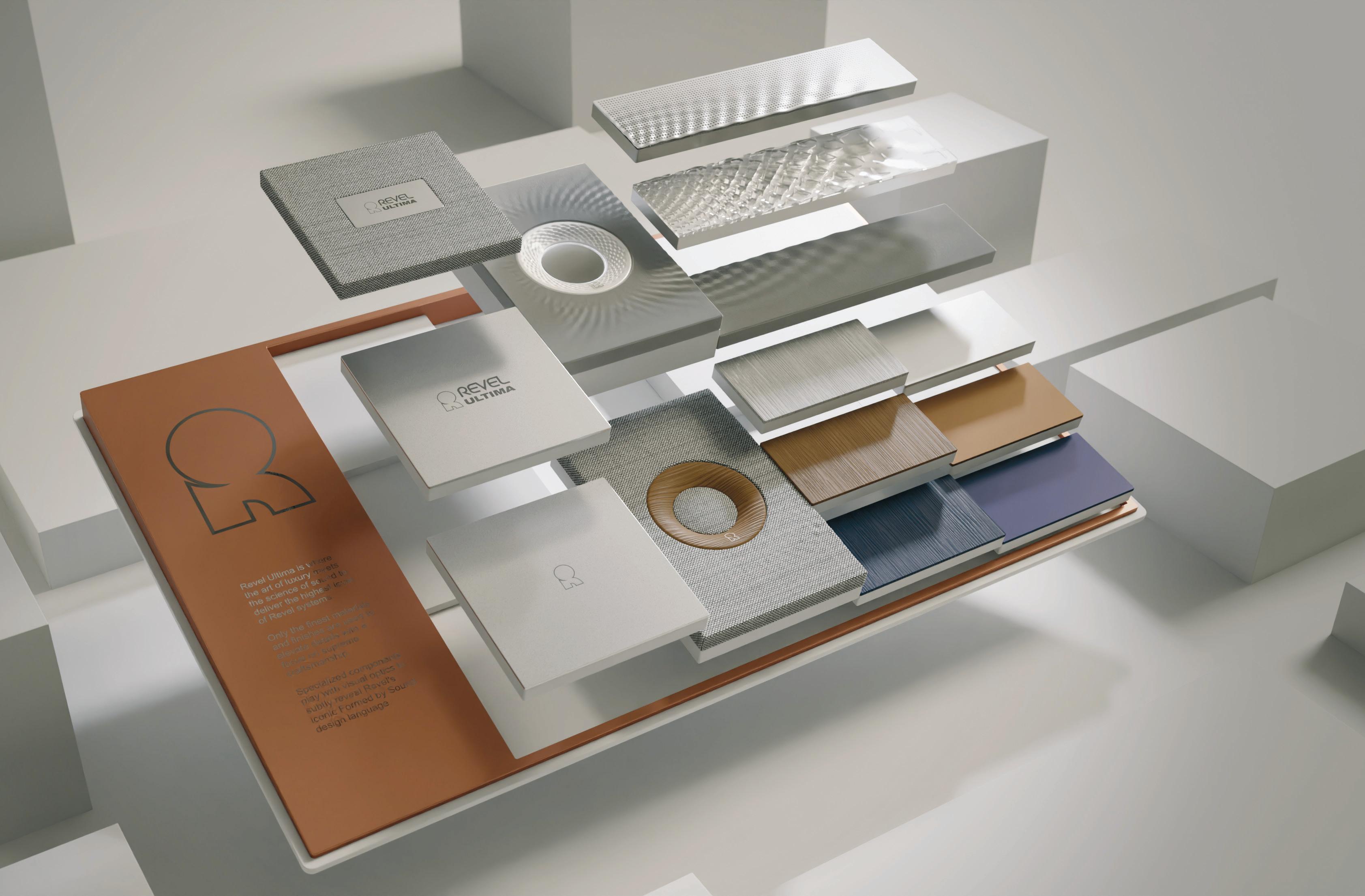
A : We have an engineering team that handles acoustic simulations, which works independently. We receive the learning from them, and we apply it in our scripts and algorithms in Grasshopper. Formlabs is the rapid prototyping device that we’re using. Being able to realise prototypes is especially important for the initial evaluation of products. I think every designer has realised that you can’t really handle the size of the product when you see it on the screen. Sometimes when [the prototype] comes out you realise, “Oh, is it really that small?” or, “Is it that big?” And then it means that we can develop our products and then present them directly to the OEMs.
Q : What makes Huemen different from other design studios and where do you see it going in the future?
A : I think it’s the fact that we consider design more holistically. Today [at D3D LIVE], I spoke a lot about the speaker grilles, the brands and the partnering. But this is not everything that Harman stands for. We develop our own products and our own experiences, and audio and design play a major part in that.

We are developing a few technologies: Ready Care, for example, which is an in-cabin monitoring system on the behaviour of the passengers in a vehicle. With our designs, we can affect the wellbeing of occupants and assist the person driving the car. We can warn them of a child running into the road after a ball, or an ambulance overtaking.
It’s not just entertainment. There are a lot of very intelligent ways of communicating with audio. Because audio is one of our senses. www.huemendesign.com
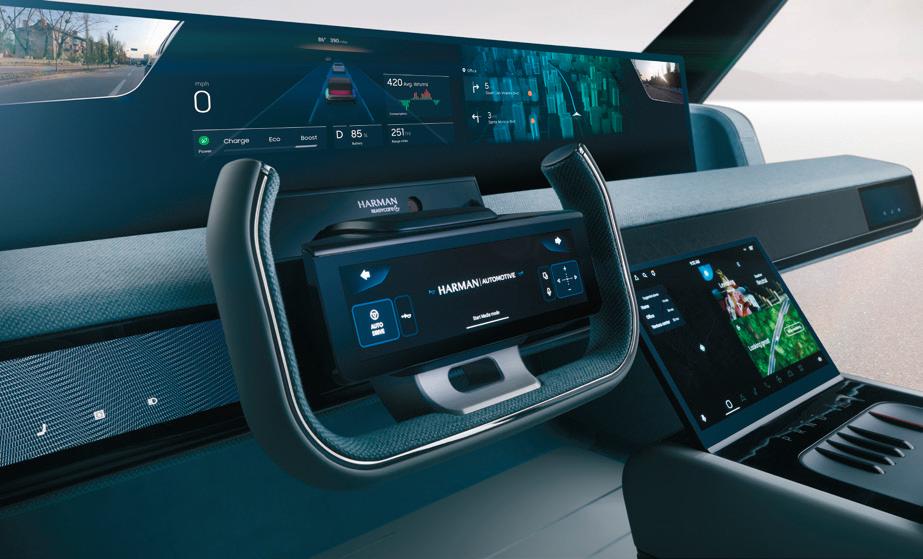
DEVELOP3D.COM DECEMBER 2022 / JANUARY 2023 39
‘‘
The first thing to keep in mind about our work is that it’s not about how a brand is perceived today, but how it wants to be perceived in future ’’
4 5
ENHANCE WORKFLOWS FOR MANUFACTURING DEVELOPMENT WITH THESE ADVANCED
Whether it’s designing new products or solving the most challenging engineering problems, product development professionals in the manufacturing industry are turning to solutions that help them stay competitive and keep up with project demands.
The design and manufacturing of physical products can be incredibly complex. Engineers and designers must find ways to accelerate concept development, perform realistic simulations, and improve productivity across global teams.

Groundbreaking hardware and software tools, powered by NVIDIA RTX technologies, are unlocking new capabilities in design
and engineering workflows. Professionals can create and deliver realistic visualization and simulations, whether it’s for automotive models or consumer products — and they can do this with realtime rendering, large GPU memory, virtualization, extended reality (XR) and a platform for full fidelity visualization and simulation of digital twins.
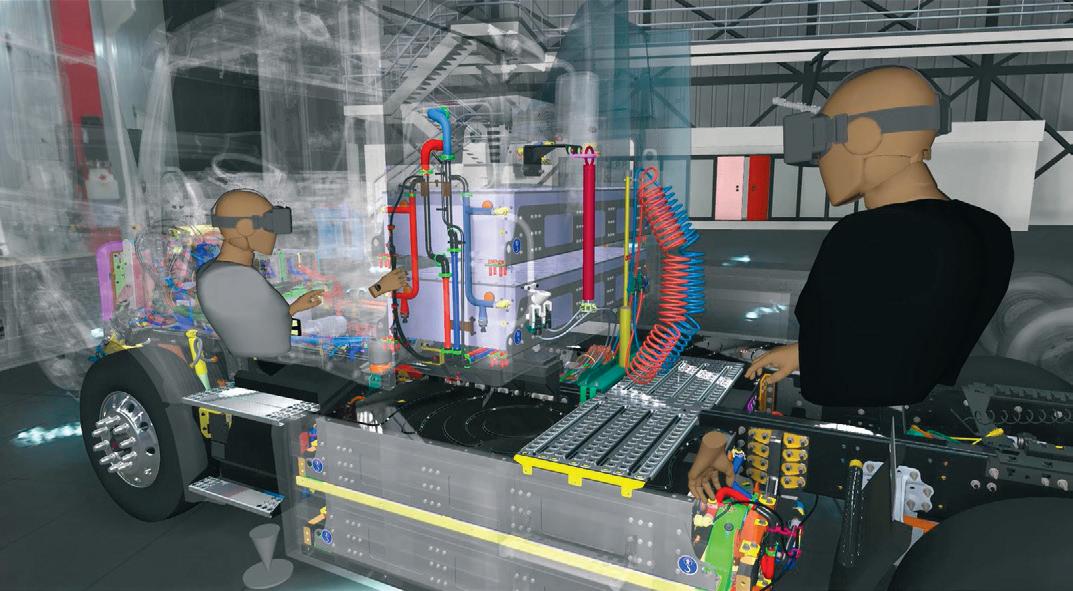
Accelerating Design and Simulation With Real-Time Rendering GPU-acceleration in 3D design and engineering applications is helping manufacturers handle large, complex models, render photorealistic images, and run engineering simulations — all in real time. Designers and engineers can tackle computing and multitasking with NVIDIA RTX professional GPUs, which allows them to leverage real-time ray tracing to accelerate production workflows while boosting productivity and efficiency.
One example of this is Alstom, a global leader in the mobility industry based in France. Alstom provides a range of equipment and services, from high-speed trains and metros to customized services and more. With NVIDIA RTX, Alstom designers can speed time-to-market and use GPU power for their design workflows.
Concept review and customization with Autodesk VRED are significant components of Alstom’s design process. And the team
SPONSORED CONTENT
Full fidelity visualization of BMW factory in NVIDIA Omniverse
Volvo brings new levels of collaboration to design reviews by streaming ESI Group’s IC.IDO using NVIDIA CloudXR. Image courtesy of Volvo Group
MANUFACTURING AND PRODUCT ADVANCED TECHNOLOGIES
reviews these designs on a 16- million- pixel stereoscopic power wall display using NVIDIA RTX GPUs to achieve high quality real-time ray tracing.
Large GPU Memory Brings New Potential For Complex 3D Models
Real-time ray tracing can help engineers and manufacturers enhance their designs, but there’s another component that can make a huge impact on design workflows — GPU memory.
The GPU memory, often referred to as VRAM, is an ultra-highperformance pool of memory dedicated for use by the GPU. This memory offers significantly higher performance than the RAM used by the CPU. The product development process generates massive amounts of graphics data coming from 3D models, rendering scenes and engineering simulations. . With large GPU memory, professionals can easily work with higher resolution visuals and higher fidelity simulations, so users can see more of their designs and gain a better understanding of their products earlier in the process.
NVIDIA RTX professional GPUs deliver large GPU memory and bandwidth, so users can easily handle massive datasets and complex 3D models. The large GPU memory also enables professionals to tackle multi-app workflows and graphic-intensive applications.
In addition to real-time ray tracing and rendering, the Alstom team utilizes the 48 GB GPU memory of the NVIDIA RTX™ A6000, the largest VRAM in workstation cards. And with NVIDIA NVLink doubling it, Alstom experienced an increased
performance of 40x more than previous GPU generations.
Digital Twins Deliver Greater Efficiencies and More Possibilities
As per an ABI Research report, spending on industrial digital twins will grow from $4.6 billion in 2022 to $33.9 billion in 2030, at a 28% Compound Annual Growth Rate (CAGR). Manufacturing companies are using digital twin simulations to reach new levels of innovation and productivity. To create these realistic digital twins, businesses will need multiple platforms and advanced technologies — and NVIDIA Omniverse Enterprise is the solution that will connect them all.
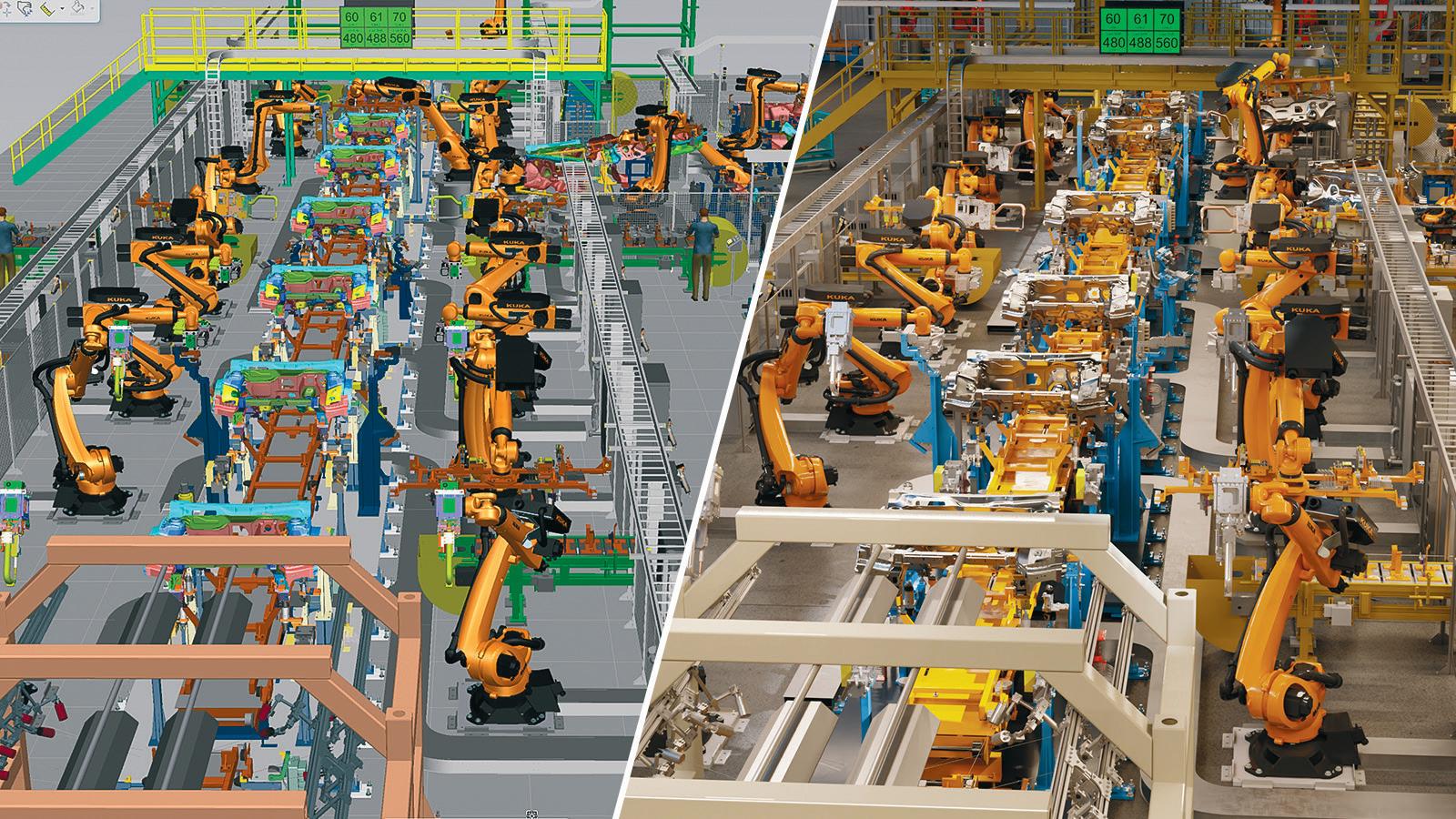
Omniverse Enterprise is a real-time virtual world simulation and 3D design collaboration platform that streamlines complex workflows. It enables global teams to work together simultaneously across multiple software suites in a shared virtual space. Using Omniverse Enterprise, companies can build scalable digital twins, and manage massive, complex data sets from various 3D content creation applications.
BMW Group is one the leading companies using digital twins to create greater operational efficiencies with NVIDIA Omniverse Enterprise. One of the largest auto manufacturers with 31 factories around the world, BMW Group is creating industrial digital twins of several of its automotive factories.
Learn more about enhancing design workflows with NVIDIA solutions. https://resources.nvidia.com/l/en-us-mfg-briefcase
SPONSORED CONTENT
The connection between Siemens Xcelerator (left) and NVIDIA Omniverse (right) will enable customers to develop full-design-fidelity, closed-loop digital twins
the All New Lenovo ThinkPad® P16 Mobile Workstation


and machine learning capabilities, the Lenovo ThinkPad® P16 Mobile Workstation is now powered by the Intel® Arc™ Pro A30M Mobile GPU. Uniting fluid viewports, the latest in visual technologies, and rich content creation in a portable 16” mobile workstation. This system combines a fresh, modern look with powerful professional graphics.
• Ray Tracing GPU Hardware Acceleration
• Dedicated GPU AI Accceleration

• 4GB High Speed Graphics Memory
• 16:10 Aspect Ratio with 4x Display Options

• Lenovo ThinkShield Security
Introducing P16
• All-new 12th Gen Intel® Core HX processors
• Software Certifications for Professional Apps intel.com/ArcProA30M © Copyright 2022 Intel Corporation. All rights reserved. Intel, the Intel logo, and other Intel marks are trademarks of Intel Corporation or its subsidiaries. Intel Arc Graphics is a trademark of Intel Corporation in the U.S. and/or other countries. Other names and brands may be claimed as the property of others.



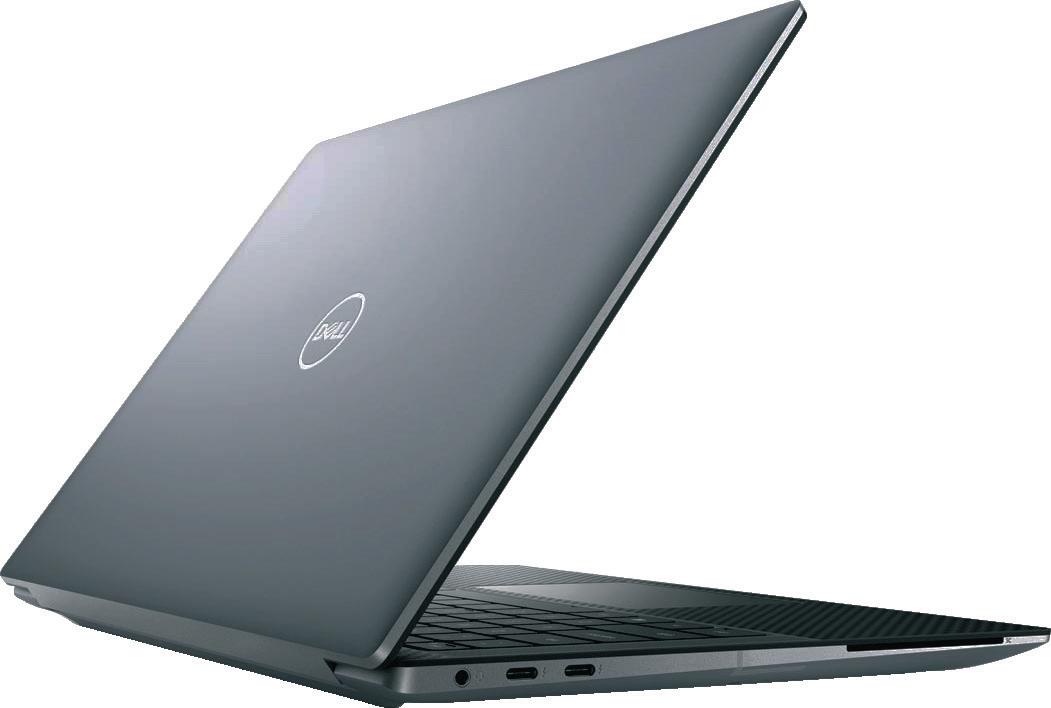
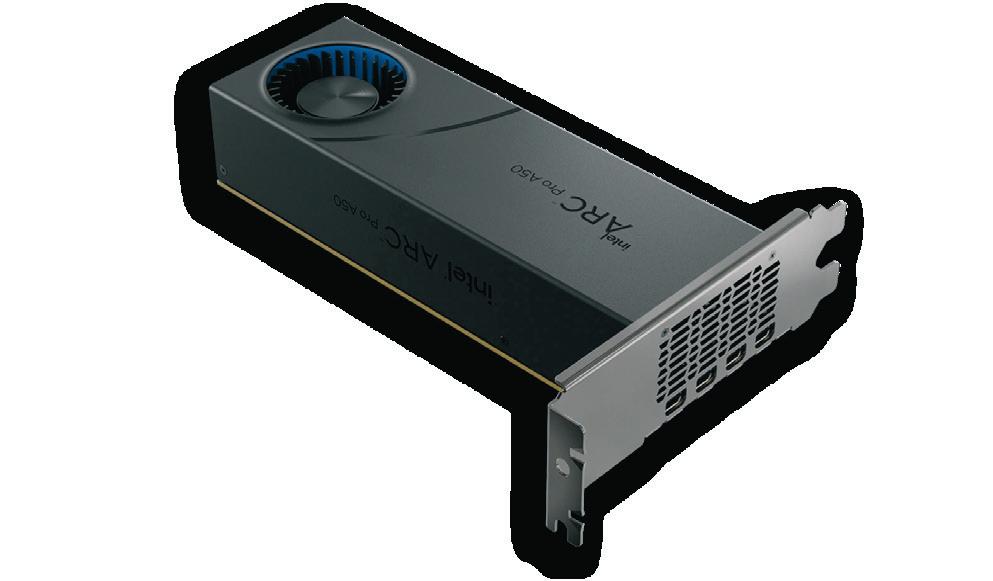

Workstation special report for CAD, visualisation and beyond DECEMBER 2022 / JANUARY 2023 | DEVELOP3D.COM THE BATTLE OF THE CPUs 13th Gen Intel Core versus AMD Ryzen 7000 for CAD-centric workflows MINI WORKSTATIONS Powerful machines, pretty on your desktop or hidden behind a display INTEL ARC PRO What do Intel’s long awaited discrete GPUs mean for CAD and viz? Vs Slimline laptops SUPER PORTABLE SUB 20mm WORKSTATIONSMOBILE Exclusive review
THE COMPUTE HORSEPOWER FOR THE ROAD AHEAD
Massive datasets, complex simulations and tight deadlines are common in design and manufacturing workflows. Engineers require a versatile workstation processor capable of addressing the different compute requirements of their key workflow applications. AMD Ryzen™ 7000 Series processors offer the best of both worlds with high frequency cores for lightly threaded 3D design tasks, and plenty of cores for multithreaded simulation, generative design, and toolpath optimization.
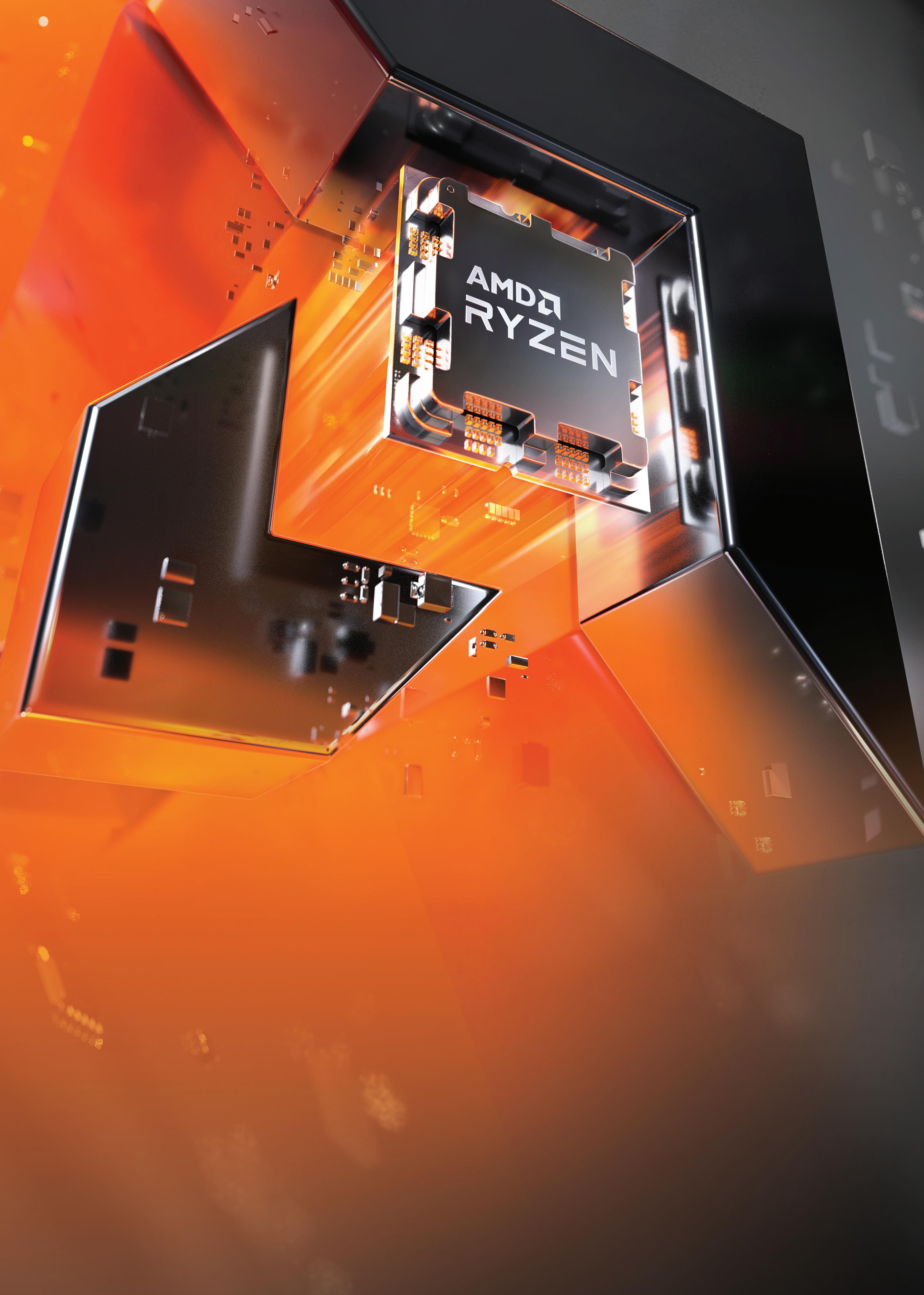
#AMD #TogetherWeAdvance
To learn more amd.com/RyzenCreators
©2022 Advanced Micro Devices, Inc. All rights reserved. AMD, the AMD Arrow logo, Ryzen, Threadripper, and combinations thereof are trademarks of Advanced Micro Devices, Inc. Advanced Micro Devices, Inc., 2485 Augustine Drive, Santa Clara, CA 95054 USA
We need to talk about energy
It feels a little hypocritical to kick off this Workstation Special Report with some advice on how to save energy. After all, I’ve spent the last two months testing workstations with some of the most demanding design and visualisation tools. The fastest processors get lauded, but they are almost always the biggest consumers of electricity.
We all know we need to use less energy to protect the environment, but there’s nothing like a global energy crisis to focus the mind. The fact is that the energy consumption of processors has been rising steadily. Today we have mainstream CPUs that draw over 250W at peak and highend GPUs that hit 450W. And even though we’ve had the coldest snowy December in years, you can still warm a home office with a few high-performance machines. Thank goodness we didn’t do the Workstation Special Report this summer!
Performance per watt has always been a metric for workstations, but how many of us have really purchased a machine with that in mind? We buy our light bulbs and appliances based on energy efficiency, run our washing machines in eco mode. Some of us even drive our cars at 56 mph — if the authorities have cleared the snow.
To learn how to save energy, we first need to understand how much our workstation consumes. The easiest way to do this is with a power meter. Simply plug it into a mains socket, then plug your workstation directly into that. It measures how much energy your entire workstation consumes in realtime, in watts and kWh. Fancier ‘smart’ devices can track usage through an app. While memory, storage, motherboard, PSU, and fans all use energy, the CPU and GPU are by far the biggest consumers in your workstation. To understand how these work in relation to your workflows, you can get a pretty good idea with Windows Task Manager > Performance.
For the CPU, expect to see 100% usage when rendering. In CAD, it’s much lower, as fewer cores are used. For the GPU, realtime visualisation and GPU rendering will also use 100% of GPU resources – again, this is usually much less for CAD.
All processors have a sweet spot where they run most efficiently. After that point there are diminishing returns, and you’ll need to pump a lot more power into the chip to increase frequency and therefore performance. As a result, running CPUs at slightly lower frequencies can save power without slowing things down too much.
Windows has built in power settings to control how much the CPU boosts. To explore the impact of this we rendered an 8K scene in KeyShot. With a highperformance power plan on a Dell Precision 5470 mobile workstation with the 45W Intel Core i7-12800H CPU (see page WS24) it consumed 0.025 kWh and took 18 mins 18 secs. The same scene rendered with an energy saving power plan used 0.022 kWh and took 24 mins 32 secs. Halving the number of cores had the opposite effect, increasing power usage to 0.033 kWh and taking 36 mins 31 secs.
Of course, some processors are more power hungry than others and the new 125W+ Intel Core i9-13900K (see page WS04) is one of the hungriest. The Boxx Apexx 4, for example (see page WS17) , used 0.042 kWh to render the same scene, although it did this in 6 mins 09 secs. But wouldn’t be nice if we could have our cake and eat it too? Save energy and still get the same (or very similar) performance out of your workstation. Well, you might just be able to do that by undervolting your processor. Modern CPUs allow you to lower the amount of power that they receive, but without necessarily slowing them down. It’s generally reserved for people who know what they’re doing, so proceed with caution, or ask your custom
workstation provider if that’s an option. The temptation when speccing out a workstation is to go for as powerful components as you can afford. With ray tracing, more performance generally means lower render times, so there’s a tangible benefit. However, for real time 3D there is a danger of paying for performance you simply don’t need. If your viz datasets aren’t that complex and you can smoothly navigate your scene with a 70W GPU like the Nvidia RTX A2000, do you really need the 200W Nvidia RTX A4500? Your workstation will consume more power and you probably won’t notice a difference.
Another tip is don’t waste compute resources. Some viz tools will continue to render the viewport when idle, so switch them off when not required. This includes Unreal Engine (GPU), Twinmotion (GPU), KeyShot (CPU / GPU), Solidworks Visualize (CPU / GPU) and others.

Also ask yourself some questions: does your render really that many passes? Do you really need it back so quickly? Could you render at a lower resolution? Could you use AI denoising?
Finally, hybrid renderers can use both GPU and CPU resources, but because the code is generally optimised for the GPU, the contribution of the CPU can be quite small. It can still use lots of energy though, so disable it in the settings.
Final thoughts
With new technology, pushing components to their limits seems a natural thing to do. But this not only increases energy usage of the workstation but can also have a knockon effect on our working environment. This winter, the heat given out by the powerful machines tested for this report was certainly welcome. In summer, less so. It’s not only your workstation fans that need to work harder, it’s your office air con as well.
Of course, we all have jobs to do and deadlines to meet. But some small adjustments to your workstation config, workflows, habits, or purchasing decisions can make a big difference.
Driving at 56 mph down the M1 motorway might not feel that exciting, but if it helps save you money and lessen your environmental impact, there’s much to be said for slow and steady win the race.
WS3 www.develop3d.com December 2022 / January 2023 workstation special report
No one wants their workstation to go slower. But in a world obsessed with bigger, better, faster, should we be paying more attention to how much energy they consume? asks Greg Corke
‘‘
Don’t waste compute resources. Some viz tools will continue to render the viewport when idle, so switch them off when not required ’’
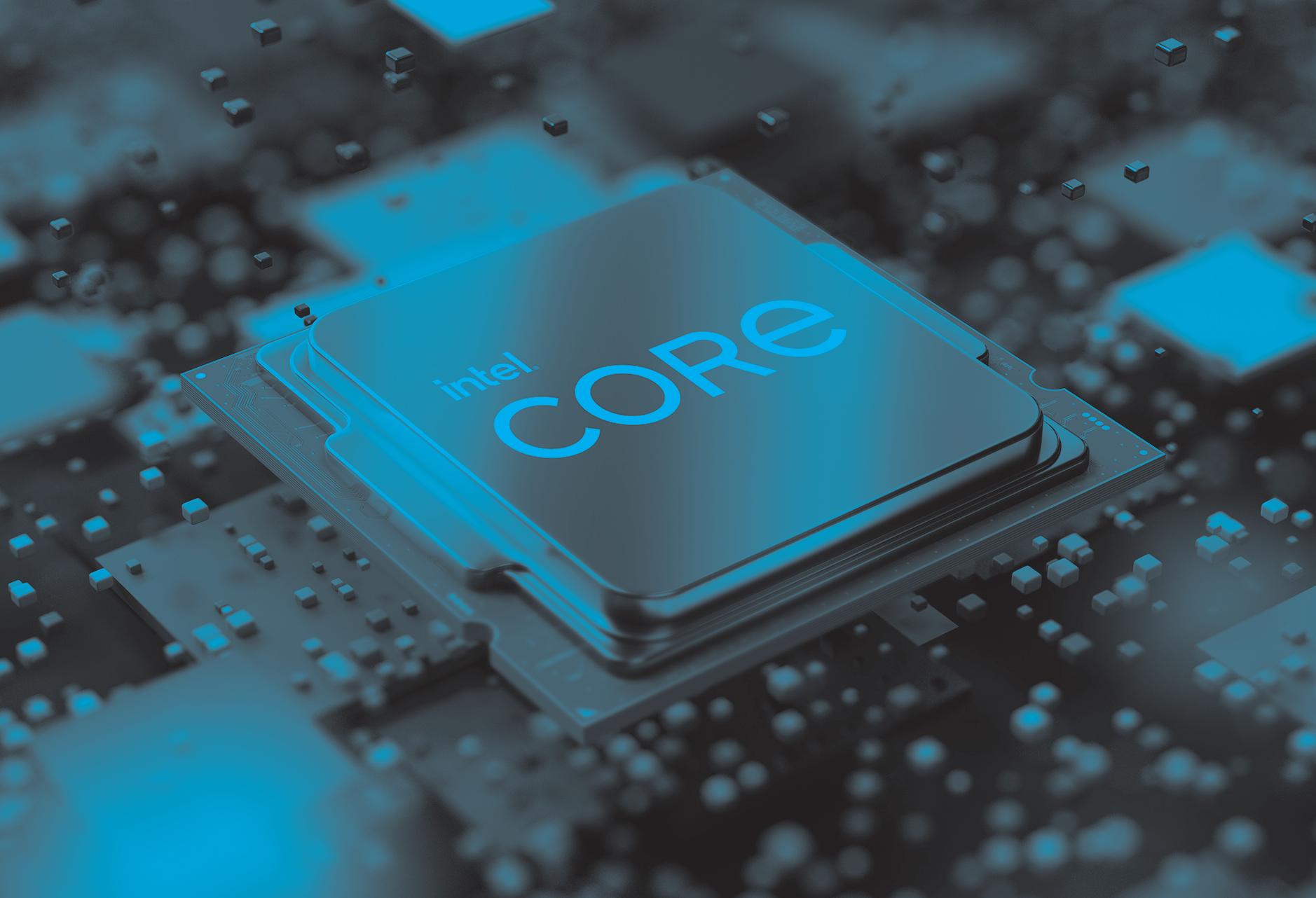
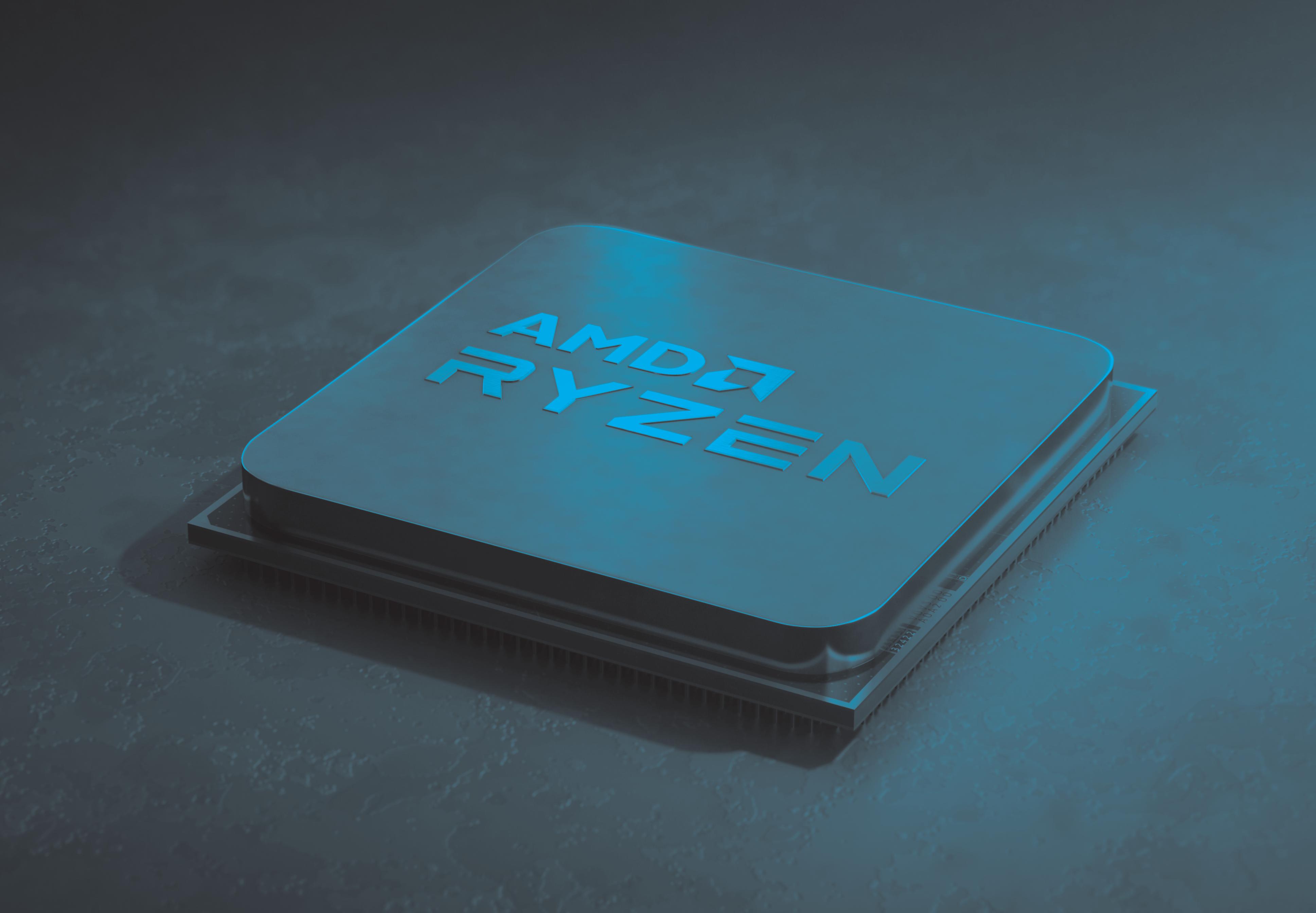
workstation special report
Vs
Intel Core vs AMD Ryzen for
CAD, BIM and beyond
Over the last few years, competition between AMD and Intel has been intense. This is particularly true with AMD Ryzen and Intel Core, popular processors for mainstream desktop workstations.
AMD has maintained a performance lead in extremely multi-threaded workflows like rendering, but the battle for supremacy in single-threaded applications like CAD and BIM, has been hard fought. To a certain extent, AMD and Intel have been playing leapfrog with each new generation since late 2020.
Autumn 2022 saw the launch schedules of both chip manufacturers align. The AMD Ryzen 7000 Series was announced in August while 13th Gen Intel Core got its first public airing in September. High on frequency, these mainstream workstation processors are ideal for CAD and BIM, but still offer plenty for multithreaded workloads including rendering, simulation, point cloud processing, photogrammetry, CAM and more.
Both processor families are now
available in workstations from specialist manufacturers like Armari, Workstation Specialists, BOXX and Scan (who provided the test machines for this article - see page WS14) . We’ve yet to see machines from the major workstation manufacturers. However, this is standard from HP, Lenovo, Dell and Fujitsu – there is always a bit of a lag between launch and support of new technologies.
AMD Ryzen 7000 Series
The Ryzen 7000 Series of desktop processors is based on AMD’s 5nm ‘Zen 4’ architecture. There are four models, ranging in frequency and number of cores.
The top-end AMD Ryzen 9 7950X has 16-cores and a max boost frequency of up to 5.7 GHz. The lower end processors have slightly lower clock speeds and fewer cores but are considerably cheaper. The AMD Ryzen 5 7600X, for example, has six cores and a max boost of 5.3 GHz, but is less than half the price of the Ryzen 9 7950X. The full line up can be seen in the table below. Compared to the previous generation
Ryzen 5000 Series, the number of cores for each class of processor remains the same. All models support simultaneous multithreading (AMD’s equivalent to Intel Hyper-Threading). This utilises twice the number of threads as physical cores to help boost performance in certain multi-threaded workflows, such as ray trace rendering.
Ryzen 7000 gets its performance uplift from a significant rise in base and boost frequency, a claimed 13% increase in Instructions Per Clock (IPC), double the Level 2 cache and support for DDR5 memory (up to 128 GB).
One trade-off with the new chips is a significant increase in Thermal Design Power (TDP), a measure of power consumption under the maximum theoretical load. The top two Ryzen 7000 Series models feature a TDP of 170W and a peak power of 230W, compared to 105W and 142W in the previous generation. However, the CPUs are only likely to draw such power when using multiple cores in combination with Precision Boost
WS5 www.develop3d.com December 2022 / January 2023 workstation special report
With 13th Gen Intel Core and AMD Ryzen 7000, competition in workstation CPUs has never been so strong. Greg Corke explores the best CPUs for designcentric workflows from CAD and BIM to reality modelling and rendering
AMD Ryzen 5 7600X AMD Ryzen 7 7700X AMD Ryzen 9 7900X AMD Ryzen 9 7950X Intel Core i5-13600K Intel Core i7-13700K Intel Core i9-13900K # of CPU Cores 6 8 12 16 14 (6 P-cores + 8 E-cores) 16 (8 P-cores + 8 E-cores) 24 (8 P-cores + 16 E-cores) # of CPU Threads 12 16 24 32 20 24 32 Base Frequency 4.70 GHz 4.50 GHz 4.70 GHz 4.50 GHz 3.50 GHz (P-cores) 2.60 GHz (E-cores) 3.40 GHz (P-cores) 2.50 GHz (E-cores) 3.00 GHz (P-cores) 2.20 GHz (E-cores) Max Boost / Turbo Frequency 5.30 GHz 5.40 GHz 5.60 GHz 5.70 GHz 5.10 GHz (P-cores) 3.90 GHz (E-cores) 5.40 GHz (P-cores) 4.20 GHz (E-cores) 5.80 GHz (P-cores) 4.30 GHz (E-cores) Cache L1 Cache - 384 KB L2 Cache - 6 MB L3 Cache - 32 MB L1 Cache - 512 KB L2 Cache - 8 MB L3 Cache - 32 MB L1 Cache - 768 KB L2 Cache - 12 MB L3 Cache - 64 MB L1 Cache - 1 MB L2 Cache - 16 MB L3 Cache - 64 MB L2 Cache - 20 MB Smart Cache (L3) - 24 MB L2 Cache - 24 MB Smart Cache (L3) - 30 MB L2 Cache - 32 MB Smart Cache (L3) - 36 MB Default TDP 105 W 105 W 170 W 170 W 125 W 125 W 125 W Peak / Max Turbo power 142 W 142 W 230 W 230 W 181 W 253 W 253 W Price (Ex VAT) (from scan.co.uk 11/11/22) £274 £350 £467 £633 £283 £392 £558
Overdrive (PBO), a feature of Ryzen CPUs that increases voltages to allow the CPU to clock higher.
13th Gen Intel Core
The 13th Gen Intel Core processor family (codenamed ‘Raptor Lake’) picks up where 12th Gen Intel Core ‘Alder Lake’ left off, with a hybrid architecture that features two different types of cores: Performancecores (P-cores) for primary tasks and slower Efficient-cores (E-cores).
The P-cores support Hyper-Threading, Intel’s virtual core technology, so every P-core can run two threads. E-cores do not support Hyper-Threading. Workloads are split ‘intelligently’ using Intel’s Thread Director.
The big difference with 13th Gen Intel Core is that it has more E-cores than its predecessor. The flagship Intel Core i913900K, for example, has 16, double that of the Core i9-12900K. This can deliver a big performance boost in highly multithreaded workflows like rendering.
Of course, the P-cores have also been enhanced and while their number remains the same (a total of eight with the Core i913900K), Intel says users can expect up to 15% better single-threaded performance compared to the previous generation with an IPC increase and a Max Turbo frequency of 5.8 GHz.
13th Gen Intel Core is even more power hungry than AMD Ryzen 7000. The top two models feature a TDP of 125W and a max turbo power of 253W. Power consumption of the Core i9-13900K is on par with the AMD Ryzen 9 7950X in single threaded workflows but significantly higher in multi-threaded workflows (more on this later).
Other features include up to two times the L2 cache and increased L3 cache, plus support for up to 128 GB of memory (DDR5 or DDR4).
While the spotlight is on the flagship Core i913900K, Intel has launched a total of six 13th Gen Intel Core processors – three with integrated graphics and three without.
As with AMD, the other models trade off frequency and cores for a lower price. However, the drop in clock speed is more dramatic. The Intel Core i5-13600K, for example, has 6 P-cores, 8 E-cores, and Max Turbo frequency of 5.10 GHz.
Intel’s hybrid architecture
The idea behind Intel’s hybrid architecture is that critical software, especially current
active applications, runs on the P-cores, while tasks that are not so urgent run on the E-cores. This could be background operations such as Windows updates, anti-virus scans, hidden tabs on a web browser, or applications that have been minimised or placed in the background (more on this later).
To help assign tasks to the appropriate cores, 13th Gen Intel Core CPUs include a hardware-based “Thread Director”. Intel states that this works best with Windows 11. We have not done any real testing across operating systems but have heard reports that some applications will only run on the E-cores on Windows 10. It may also be helpful to use the latest software releases or service packs.
Splitting out the CPU into P-cores and E-cores doesn’t mean that highly multi-threaded processes simply run on the P-cores, leaving the E-cores idle. In ray trace rendering software like V-Ray or KeyShot, for example, the Intel Core i9-13900K will max out all 24 cores and 32 threads.
Of course, in modern design workflows, multi-tasking is common, and architects and engineers often use multiple applications at the same time. Thread Director allows you to deprioritise certain processes by simply minimising an application or moving it to the background by maximising another. This forces the calculations for the inactive application to run on the E-cores only, leaving the more powerful P-cores free for the active application.
Having this level of control can be useful if you often run concurrent compute intensive applications, such as rendering, point cloud processing, CAM, photogrammetry and others. It allows you to prioritise tasks quickly and easily, on the fly.
The downside of this approach is when the foreground application is less demanding. If, for example, you’re modelling in Solidworks or Revit, and rendering in the background with V-Ray or KeyShot, you don’t really need to dedicate eight superfast P-Cores to a CAD or BIM application which, in many parts, can only take advantage of a single core.
One way round this is to keep both applications in the foreground, perhaps each on their own monitor, or even leaving a tiny bit of the application visible.
While our testing went no further, there may be other solutions, such as assigning applications to specific cores using Processor Affinity in Task Manager. However, this would only be temporary fix until reboot. Maybe a tool like Process Lasso or Prio could give applications permanent priority.
Availability
Comparing AMD Ryzen 7000 with 13th Gen Intel Core, isn’t just about specs, performance, and features – it’s also about the machines you can buy. When it comes to workstations, not all customers have a free choice of supplier, with many large AEC firms only allowed to procure IT from a major global manufacturer like Dell, HP, Lenovo or Fujitsu.
While both 13th Gen Intel Core and AMD Ryzen 7000 Series workstations are available now from specialist manufacturers like Scan, BOXX, Armari and Workstation Specialists, we expect Intel to continue to dominate in mainstream workstations from the major global manufacturers.
Lenovo is currently the only one out of HP, Dell and Fujitsu to offer an AMD Ryzen desktop processor in a mainstream workstation, and that is with the AMD Ryzen Pro 5000 in the ThinkStation P358, which launched August 2022. Whether Ryzen 7000 (and the Ryzen Pro 7000 that will presumably follow) becomes the catalyst for others to follow suit remains to be seen.
Test setup
For our testing we focused on the top end models from both processor families – the AMD Ryzen 9 7950X (16-cores, 32-threads, and a max boost clock of up to 5.7 GHz) and the Intel Core i9-13900K (8 P-cores, 16 E-cores, 32-threads and a max turbo frequency of 5.8 GHz).
Our CPUs were housed in very similar workstations — the AMD Ryzen 9 7950X in the Scan 3XS GWP-ME A132R and the Intel Core i9-13900K in the Scan 3XS GWP-ME A132C.
Apart from the CPUs and motherboards, the other specifications were almost identical. This includes the 240mm Corsair H100i Pro XT hydrocooler. The other specs can be seen below. Windows Power plan was set to high-performance.
• CPU – AMD Ryzen 9 7950X
• Motherboard – Asus TUF B 650-Plus WiFi
WS6 www.develop3d.com December 2022 / January 2023 workstation special report
Scan 3XS GWP-ME A132R (AMD Ryzen 7000 workstation)
‘‘
The AMD Ryzen 9 7950X starts to show real benefits when rendering, a process that can harness every single core, all the time ’’
Scan 3XS GWP-ME A132C (13th Gen Intel Core workstation)
• CPU – Intel Core i9 13900K
• Motherboard – Asus Z790-P WiFi
Common components
• Memory – 64GB (2x 32GB) Corsair Vengeance DDR5 5,600MHz
• System Drive – 2TB Samsung 980 Pro NVMe PCIe 4.0 SSD
• Cooling – Corsair H100i Pro XT
• PSU – 750W Corsair RMX, 80PLUS Gold
• GPU – Nvidia RTX A4500 (20 GB)
• Networking – 2.5GbE NIC, WiFi
• Operating System – Microsoft Windows 11 Professional 64-bit
Turn to page WS14 for a full review of both workstations.
On test
We tested both workstations with a range of real-world applications used in AEC and product development. We also compared performance figures from previous generation workstations, including 11th Gen Intel Core (Core i911900), 12th Gen Intel Core (Core i912900K) and AMD Ryzen 5000 (Ryzen 5950X). The comparisons aren’t perfect; the older machines all ran Windows 10 with different memory, storage, and cooling configs, but should still offer a pretty good approximation of relative performance.
CAD, BIM and beyond
CAD applications like DS Solidworks and Autodesk Inventor, and BIM authoring tools like Autodesk Revit, are bread and butter for product designers, engineers, and architects. In the main they are single threaded and while some processes can use a few CPU cores, it’s only usually ray trace rendering that can take full advantage of all the processor cores, all the time.
In Autodesk Revit 2021 using the RFO v3 benchmark the Intel workstation was around 10% faster in model creation and export, and, surprisingly, around 5% faster when rendering. We saw similar results in Solidworks 2021 using the SPECapc 2021 benchmark, although Intel’s lead was extended considerably in ‘model rebuild’.
With the InvMark for Inventor benchmark by Cadac Group and TFI, Intel had a small lead in most sub tests, which are either single threaded, only use a few cores (threads) concurrently, or use a lot of cores, but only in short bursts. AMD fared better in the rendering sub test, which
uses all available cores, and when opening files and saving to disk.
Both the Solidworks and Inventor benchmarks also test CAD-native simulation capabilities through Solidworks Simulate and Autodesk Inventor dynamic simulation / FEA. These tests use a few CPU cores, whereas some of the more advanced simulation tools, such as Ansys Mechanical, can take advantage of more.
Here, it’s worth pointing out the chart above where you can see how frequency drops as more cores (threads) are enabled.
Between 1 and 8 threads, Intel maintains a higher frequency than AMD, so this helps give Intel a lead in workloads that use a similar number of threads.
Of course, the core code in many CAD tools is quite old and new generation tools, including nTopology for design for additive manufacturing, is built from the ground up for multi-core processors (and,
more recently, GPU computation). For our nToplogy geometry optimisation test we solely focused on the CPU and, with all cores in use, the Intel workstation had the edge over AMD.
Reality modelling
Reality modelling is becoming much more prevalent in the AEC sector. Agisoft Metashape is a photogrammetry tool that generates a mesh from multiple hires photos. It is multi-threaded, but uses CPU cores in fits and starts, and uses a combination of CPU and GPU processing.
We tested using a benchmark from specialist US workstation manufacturer Puget Systems. In most of our tests the Ryzen 9 7950X performed poorly and was even slower than the Ryzen 5950X. Intel had a clear lead – between 25% and 39% faster.
In point cloud processing software, Leica Cyclone Register 360, which can run
WS7 www.develop3d.com December 2022 / January 2023 workstation special report
0 1 2 4 6 8 10 12 14 16 18 20 22 24 26 28 30 32 5.8 5.7 5.6 5.5 5.4 5.3 5.2 5.1 5.0 4.9 4.8 4.7 4.6 4.5 Processor frequency in
to number of CPU threads used (using Cinebench R23 custom run) Number of threads Processor frequency (GHz) Intel Core i9-13900K workstation AMD Ryzen 9 7950X workstation 0 1 2 4 6 8 10 12 14 16 18 20 22 24 26 28 30 32 500 450 400 350 300 250 200 150 100 50 0 Number of threads Total system power draw (Watts) Intel Core i9-13900K workstation AMD Ryzen 9 7950X workstation Total system power draw in relation to number of CPU threads used (using Cinebench R23 custom run)
relation
WS8 www.develop3d.com December 2022 / January 2023 workstation special report InvMark for Autodesk Inventor CPU tests 2,141 2,307 1,832 1,855 1,272 1,959 2,166 1,725 1,455 1,477 2,487 2,615 1,740 1,522 1,686 5,593 5,706 3,555 3,671 1,894 1,544 1,743 1,337 1,088 1,237 2,757 2,807 1,473 1,390 1,499 1,364 1,240 1,140 963 1,159 2,509 2,611 2,339 1,777 1,992 1,434 1,473 1,377 1,263 1,313 Modelling Drawing Assemblies Ray Tracing Data Translation Opening files Saving to disk Dynamic Sim FEA Benchmark score (bigger is better) 1.23 6 Solidworks 2021 SPECapc benchmark CPU tests 0 1 2 3 4 5 6 7 8 6.25 6.53 4.50 4.35 2.63 1.77 2.93 2.87 1.53 2.39 2.77 3.04 2.62 2.05 2.20 2.07 2.265 1.90 1.64 1.86 CPU Raytrace CPU Rebuild CPU Convert CPU Simulate Benchmark score (bigger is better) 1.23 Autodesk Revit 2021 RFO v3 benchmark CPU tests Model creation Export Rendering Time secs (smaller is better) 1.23 68.9 61.5 70.2 89.5 79.1 211.4 189.6 211.9 282.0 235.3 19.8 18.8 26.4 26.6 42.3 Cinebench R23 benchmark Ray trace rendering 0 5000 10000 15000 20000 25000 30000 35000 40000 Single core test Multi-core test Benchmark score (bigger is better) 1.23 2,022 2,193 1,579 1,649 37,601 37,862 24,361 14,854 KeyShot 10 Ray trace rendering (bike model - 128 passes) 0 50 100 150 200 250 300 350 400 86.7 104.4 356 391.5 3,840 x 2,378 resolution 7,680 x 4,758 resolution Time secs (smaller is better) 1.23 AMD Ryzen 9 7950X Intel Core i9-13900K Intel Core i9-12900K AMD Ryzen 9 5950X Intel Core i9-11900 AMD Ryzen 9 7950X Intel Core i9-13900K Intel Core i9-12900K AMD Ryzen 9 5950X Intel Core i9-11900 AMD Ryzen 9 7950X Intel Core i9-13900K Intel Core i9-12900K AMD Ryzen 9 5950X Intel Core i9-11900 AMD Ryzen 9 7950X Intel Core i9-13900K Agisoft Metashape Professional 1.73 Puget Systems benchmark 0 1000 2000 3000 4000 5000 6000 135 84 120 111 405 314 426 391 2,244 1,446 2,095 2,439 5,985 4,490 5,994 5,888 Rock model School Map School model Park Map Time secs (smaller is better) 1.23 AMD Ryzen 9 7950X Intel Core i9-13900K AMD Ryzen 9 5950X Intel Core i9-11900 AMD Ryzen 9 7950X Intel Core i9-13900K AMD Ryzen 9 5950X Intel Core i9-11900
on up to five CPU threads on machines with 64 GB of memory, Intel had a 7-10% lead when registering both of our point cloud datasets. In practice, the lead over the 11th / 12th Gen Intel Core and Ryzen 5000 would be even higher, as those machines had 128 GB memory, so the software used 6 CPU cores.
Rendering
The Ryzen 9 7950X starts to show real benefits when rendering, a process that can harness every single core, all the time. In V-Ray and KeyShot, two of the most popular tools for design visualisation, the Ryzen 9 7950X showed around a 10% lead over the Core i9-13900K.
In Unreal Engine, the lead was smaller when recompiling shaders, a process that uses every CPU core, along with the GPU.
In Cinebench 23, a benchmark based on Cinema4D, there was virtually nothing between the two processors.
We also did stress tests to see how CPU frequency dropped over time. When rendering in KeyShot, the Core i9-13900K started at 4.89 GHz, dropped to 4.63 GHz after a few minutes, but maintained that frequency for well over an hour. The Ryzen 9 7950X fared better here, starting at 5.5 GHz but then maintaining a solid 5.0 GHz.
Much of this is down to the relative power consumption of the two CPUs, which you can read more about later.
Multi-tasking
These days, very few architects, engineers or product designers use single applications and, with compute intensive workflows on the rise, such as reality modelling, rendering and simulation, it’s very important to consider a CPU’s ability to multi-task.
Even with the lower-end 13th Gen Intel Core and AMD Ryzen 7000 Series processors, which have fewer cores, it will be possible to leave one or more multi-threaded tasks running in the background, and still leave resources free for bread-and-butter 3D modelling.
To explore multi-tasking potential, we pushed both machines to their limits, with a demanding AEC workflow, consisting of point cloud processing and photogrammetry.
We registered a 24 GB point cloud dataset in Leica Cyclone Register 360 while, at the same time, processing a series of high-res photographs in Agisoft Metashape.
If done sequentially it would have taken the AMD machine 1,039 secs and the Intel 826 secs. However, running both
jobs in parallel the AMD finished in 625 secs and the Intel in 646 secs. With more threads trying to run concurrently, clock speeds dropping, and some processes being pushed to slower E-Cores, the Intel workstation starts to slow down.
To push the machines even harder we added ray tracing into the mix, rendering an 8K scene in KeyShot using 8 cores and 16 threads. Here, AMD’s 16 highperformance cores showed a real benefit, completing all three tasks in 729 secs compared to 779 secs on Intel.
Graphics
CPU speed has some influence over graphics performance, but the extent to which it does depends on the software. In Revit, an application renowned for being CPU limited, the Intel Core i9-13900K showed around a 7% performance lead over the AMD Ryzen 9 7950X when using the same Nvidia RTX A4500 GPU. This lead was smaller in Solidworks, which has a more modern graphics API that better harnesses the power of the GPU.
In Unreal Engine 4.26, an application renowned for being GPU limited, rather than CPU limited, the difference between Intel and AMD was negligible when testing with the Audi Car Configurator model.
WS9 www.develop3d.com December 2022 / January 2023 workstation special report nTopology 3.24 Geometry optimisation 0 20 40 60 80 100 120 Bike seat (Voronoi pattern) Time secs (smaller is better) 1.23 37.61 35.80 63.63 68.39 116.06 V-Ray 5.0 benchmark Ray trace rendering 0 5000 10000 15000 20000 25000 30000 V-Ray 5.0 CPU Benchmark Score (bigger is better) 1.23 29,458 26,952 17,325 19,839 11,064 AMD Ryzen 9 7950X Intel Core i9-13900K Intel Core i9-12900K AMD Ryzen 9 5950X Intel Core i9-11900 6 Multi-tasking workflow benchmarks (Cyclone Register 360, Metashape and Keyshot) 0 200 400 600 800 1000 Cyclone and Metashape Cyclone, Metashape and Keyshot on 8 cores Time secs (smaller is better) 1.23 626 646 895 954 729 779 863 Test did not finish AMD Ryzen 9 7950X Intel Core i9-13900K AMD Ryzen 9 5950X Intel Core i9-11900 AMD Ryzen 9 7950X Intel Core i9-13900K Intel Core i9-12900K AMD Ryzen 9 5950X Intel Core i9-11900 6 Leica Cyclone Register 360 Point cloud registration 0 500 1000 1500 2000 Small dataset (24 GB) Large dataset (99 GB) Time secs (smaller is better) 1.23 477 427 Data not available 665 699 1,194 1,106 1,480 1,785 1,888 AMD Ryzen 9 7950X Intel Core i9-13900K Intel Core i9-12900K AMD Ryzen 9 5950X Intel Core i9-11900 Unreal Engine 4.26 Recompile shaders 0 50 100 150 200 Audi Car Configurator model Time secs (smaller is better) 1.23 189.7 194.5 AMD Ryzen 9 7950X (with Nvidia RTX A4500) Intel Core i9-13900K (with Nvidia RTX A4500)
’’
‘‘ Intel’s good all-round performance does come at a cost. While power demands of the two CPUs are similar in single threaded workflows, the Core i9-13900K soon starts piling on the watts when more CPU cores come into play
Power consumption
Compared to the previous generations, both processors use a lot of power. The Intel Core i9-13900K has a Thermal Design Power (TDP) of 125W and a max turbo power of 253W. The AMD Ryzen 9 7950X has a TDP of 170W and a peak power of 230W. But specs only tell part of the story.
In reality, the Intel chip draws noticeably more power in multi-threaded workflows than AMD. This was observed at the plug socket, when measuring power draw of the overall systems – taking into account CPU, motherboard, memory, storage, and fans.
When rendering in Cinebench using all cores, for example, the AMD workstation draws 341W at the plug, but the Intel workstation trumps this considerably with a whopping 451W. In KeyShot it’s even more with Intel at 509W and AMD at 382W
Power consumption in single threaded workflows is significantly lower and much more equal, with the AMD and Intel workstations drawing 127W and 122W respectively.
However, as you can see in the chart on page WS07, as core utilisation increases Intel soon starts drawing more power.
Of course, more power means more heat, which means the workstation’s fans must work harder. This has a knock-on effect on acoustics, and the Intel machine was noticeably louder when rendering, especially over long periods. This could potentially be mitigated with a higher-end all-in-one cooler.
But what you really want to know is how increased power usage might impact your electricity bill. Based on the current UK electricity rate of £0.34 per kWh for households (and £0.211 per kWh for businesses), rendering for eight hours
a day, five days a week, would cost you £241 (£150) per year with the AMD Ryzen 9 7950X workstation and £319 (£198) per year with the Intel Core i9-13900K workstation.
While rendering all day long is an extreme use case, it should give some food for thought, especially if your firm uses multiple workstations. Energy prices are also set to rise in April 2023 (see page WS03 for more on energy use in workstations).
The verdict
For years, Intel was the only serious option for workstation processors. But

now with AMD Ryzen 7000 and 13th Gen Intel core, designers, engineers and architects have real choice.
From our tests, the Intel Core i9-13000K demonstrates a clear lead over the AMD Ryzen 9 7950X in single threaded and lightly threaded workflows. And with more E-Cores than before, it has also closed the gap considerably in ray trace rendering.
To provide some context, 18 months ago, AMD Ryzen offered nearly double the rendering performance of Intel Core (Ryzen 5000 vs 11th Gen). That lead has now shrunk to around 10% in some apps.
And while AMD still comes out top when multi-tasking, Intel now competes much more strongly, even in scenarios where before it failed.
But Intel’s good all-round performance does come at a cost. While power demands of the two CPUs are similar in single threaded workflows, the Core i9-13900K soon starts piling on the watts when more CPU cores come into play. AMD’s superior power efficiency is a big win, both in terms of energy usage and acoustics.
Of course, Ryzen 7000 and 13th Gen Intel Core aren’t just about the top-end models. For CAD users on a tight budget, the Intel Core i5-13600K and AMD Ryzen 5 7600X look like great value CPUs. And with the 7600X having a slightly higher boost frequency, we expect there to be little between both processors in single threaded CAD or BIM workflows.
WS10 www.develop3d.com December 2022 / January 2023 workstation special report
0 1 2 3 4 5 6 4.71 4.80 5.40 5.37 Shaded with edges Shaded with edges with RealView and Ambient Occlusion Score (bigger is better) 1.23 AMD Ryzen 9 7950X (with Nvidia RTX A4500) Intel Core i9-13900K (with Nvidia RTX A4500) Autodesk Revit 2021 RFO v3 benchmark Graphics test 0 5 10 15 20 Standard graphics test Time secs (smaller is better) 1.23 18.17 16.88 AMD Ryzen 9 7950X (with Nvidia RTX A4500) Intel Core i9-13900K (with Nvidia RTX A4500) InvMark for Inventor
Graphics tests 0 1000 2000 3000 4000 5000 Standard graphics test Score (bigger is better) 1.23 4,874 4,997 AMD Ryzen 9 7950X (with Nvidia RTX A4500) Intel Core i9-13900K (with Nvidia RTX A4500) Unreal Engine 4.26 Graphics tests 0 5 10 15 20 Audi Car Configurator model Frames Per Second (bigger is better) 1.23 17.37 17.16 AMD Ryzen 9 7950X (with Nvidia RTX A4500) Intel Core i9-13900K (with Nvidia RTX A4500)
Solidworks
2021 SPECapc benchmark Graphics tests
(by Cadac Group and TFI)
Your choice of CPU has very little bearing on 3D performance in GPU limited applications like Unreal Engine
Power to design
From 3D modeling and simulation to visualization in VR and more, power through your most demanding workflows with Z by HP desktop and laptop workstations.
Professional Performance
Design in real time with the power of high-performance workstations configured with NVIDIA RTX™ graphics.
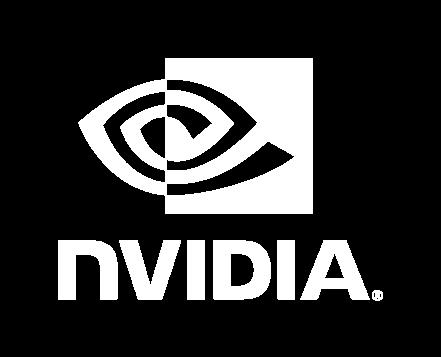
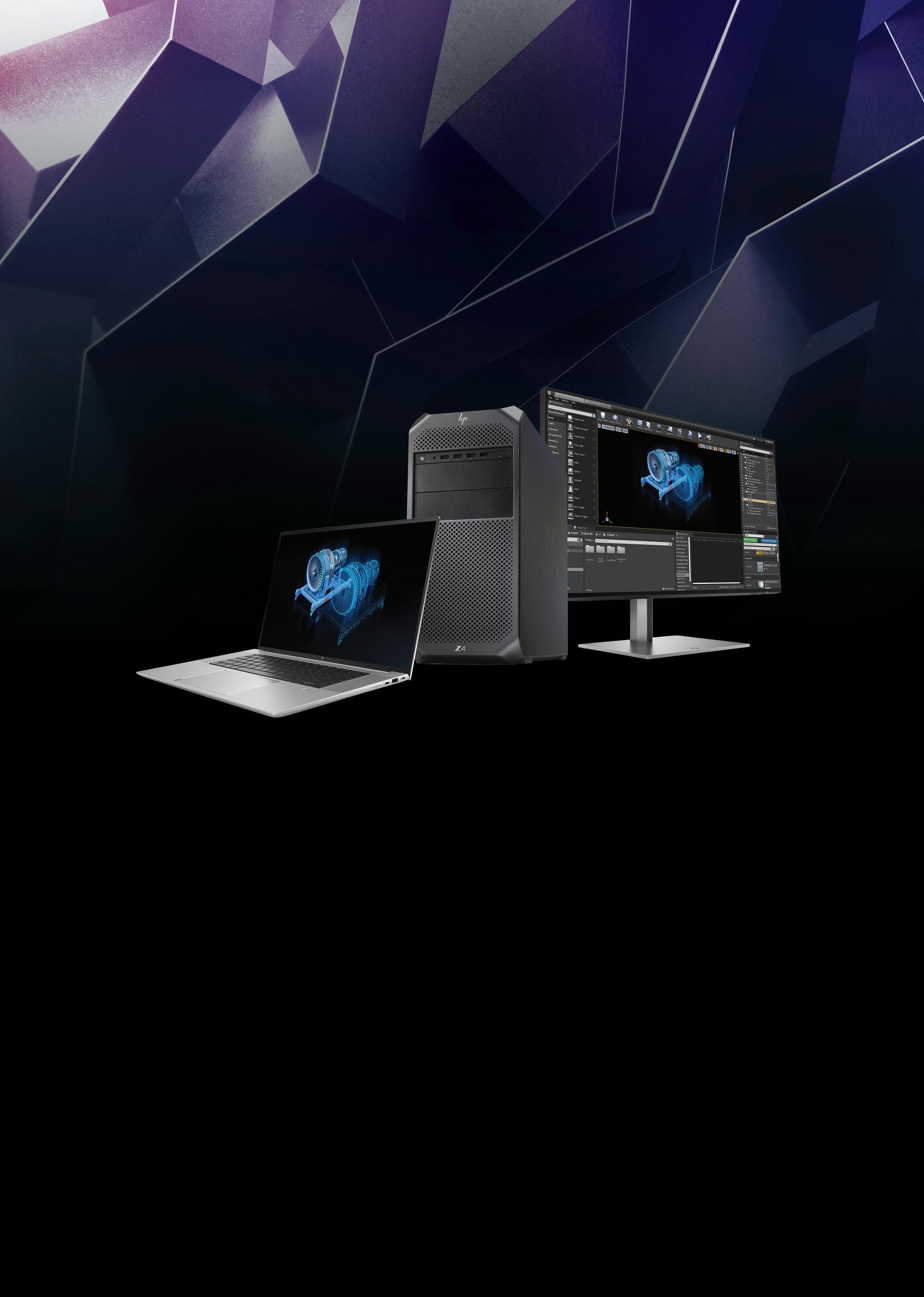
ISV Certified
Certified with leading software applications to ensure peak performance even with complex projects.
Upgrade and Customize
Configure to meet your complex workflow demands today with ample room to expand as your needs change.
Reliability
Our workstations undergo military-standard testing,1 plus up to 360K additional hours of testing.
© Copyright 2023 HP Development Company, L.P. The information contained herein is subject to change without notice. NVIDIA and Quadro are trademarks and/or registered trademarks of NVIDIA Corporation in the U.S. and other countries. 1. Undergoes MIL-STD testing. MIL-STD testing is not intended to demonstrate fitness for U.S. Department of Defense contract requirements or for military use. Test results are not a guarantee of future performance under these test conditions. Accidental damage requires an optional HP Accidental Damage Protection Care Service. Find solutions customized to your workflow needs. LEARN MORE
A guide to choosing the right GPU.
Modern graphics cards (or GPUs) are complex pieces of hardware which should improve performance within the viewport, but should also improve visual clarity and accuracy. Although there is no reason they should be daunting pieces of hardware. This article aims to offer some simple guidance on how GPUs work and considerations to help increase software performance. Let’s begin with the most common question:
Do I choose a gaming GPU or a professional GPU?
Both are designed for different tasks and software needs. If you want to mostly play games, then choose a purpose-built gaming GPU. If you use business critical software requiring hardware validation or certifications, then a professional GPU is right for you. These are optimized for 24x7 usage with warranties that characteristically last for a lengthy 3 years. Professional GPUs can carry more memory than their gaming counterparts, although the underlying graphics architecture can be similar. Other main differences are the physical card design and layouts, Pro GPUs are built for workstation case needs, which requires different power connector positions, different fan designs, and have different thermal considerations to their counterparts - particularly how hot air is exhausted out the GPU and overall system. The next consideration is overall host system portability.
Do I choose a mobile or deskside system?
Recent mobile laptops (or mobile workstations) are now as powerful as many tower or deskside equivalents. There are benefits to a larger system, such as component upgradeability and multiple GPU support, but for typical CAD workflows a mobile system can be adequate. When looking to matching GPUs in both choices, you won’t see much performance or feature difference between the comparable GPUs, although mobile laptops can mean less dedicated graphics memory.
Windows can require more RAM, so GPU requirements are increasing.
6GB is a great sweet spot for traditional CAD.
Scott Jackson, Intel,
Director, Product Management.
Typical GPU performance needs by task
High-end GPUs: are great for real time experiences, simulations and GPU rendering tasks. They often draw the most power.
Medium workload GPUs: are great for 2D and 3D CAD/BIM projects, along with typical image and video editing.
Does expensive graphics mean better software performance?

No, not always. Normally more expensive discrete GPUs have extra dedicated memory and cores which can aid some software’s speed, but like a traditional processor, the real questions are what software
Light work workload GPUs: are great options for modern office productivity tasks.
Integrated GPUs: (iGPUs) are great for many software uses for example ones that don’t require much memory combined with long-battery life.
Tip: Look to your existing workflow and see how much of the GPU it’s using. It’s unlikely you are using just one application, so explore a few of your common software tools.
do you use, and will it directly benefit? For some the answer is a firm No. So always start by looking at your software’s hardware requirements, before selecting a GPU as you may not need to spend so much.
What does ‘discrete’ GPU mean?
This is normally a way of distinguishing that the GPU has dedicated memory on board. This can offer enhanced performance, as it does not need to share it with other system resources. The GPU (or dGPU) will also be separate to the processor.
Generally, there are three essential components to all discrete graphics cards:
1 The GPU chip: The brains of the card, processing various complex tasks.
2 The memory: Where things like viewport textures are stored.
3 The fan and heat sink: Helping regulate thermals, keeping the card running at it’s optimum.
QUICk TIP
Resizeble BAR (Base Address Register) Is a new consideration for many. It is recommended to enable this for Intel® Arc™ GPUs to optimize advanced system resources via the PCIe® device and how it transfers information from the CPU to the GPU. It can result in performance improvements by enabling this overall system functionality. Many modern system vendors already enable this by default within the VBIOS. If unsure, check with your system provider.
Sponsored Content Professional graphics 101:
© Copyright 2022 Intel Corporation. All rights reserved. Intel, the Intel logo, and other Intel marks are trademarks of Intel Corporation or its subsidiaries. Intel Arc Graphics is a trademark of Intel Corporation in the U.S. and/or other countries. Other names and brands may be claimed as the property of others.
Snr
1 Dual slot vs single slot card
Graphics cards are available in different form factors to suit the range of professional workstations that exist. The term refers to how many slots it takes up on the motherboard and workstation case. Dual slot cards have higher performance, requiring more power to run.
2 End bracket
These help to hold the GPU in place with their fixing ‘ears’.
3 Graphics cores
GPUs are made up of huge amounts of calculation cores, with each GPU vendor giving them different names and using different architectures, for example, 8x NVIDIA CUDA cores, does not directly equal 8x Intel Xe Cores. More cores do however mean more performance when comparing each vendor to itself.
4 Display connectors
For workstation GPUs look for matching connectors that help outputs to match. HDMi is used for home entertainment with most professional GPUs standardizing on DisplayPort® Mini-DisplayPort (mDP) offers the same functionality but condensed.
5 Gold Fingers
Gold-plated vertical rows (or lanes) on the graphics (PCB) board for connecting to the systems motherboard expansion slots. The ‘fingers’ are used to communicate with other system components, with gold alloy used for superior strength and conductivity.
6 PCIe® connector
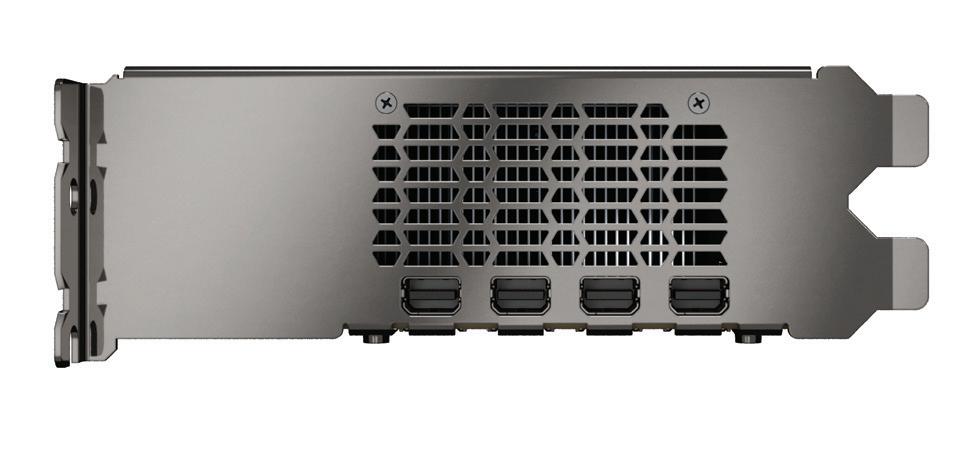
Graphics cards are typically x16 ‘lane’ devices, and more lanes used directly relates to more bandwidth speed. Note that PCIe gen 3.0 is half the speed of PCIe gen 4.0. Meaning PCIe 4 x8, and PCIe 3 x16 offer similar speeds.
7 Cable locking mechanisms
Look for a small slot above each output on the GPU for a display cable to lock into, preventing the compatible cable being accidentally removed.
8 Memory
For professional graphics, GDDR6 is today’s common high-performance memory type, but the amount can vary. Memory (RAM) can be expensive, and more RAM can increase the price of your GPU. However, you don’t always need lots of RAM for your software. Generally, 6-8GB is a great choice for modern CAD and design tasks.
9 Fan
The fan on your GPU has the important task of cooling your card. If too hot, thermal throttling occurs, slowing the GPU.
10 Multiple outputs
Numerous third-party reports have shown the tangible efficiency benefits of adding at least a second monitor to your setup. By adding more screen space, you save time hunting for menus, or finding content hidden behind multiple windows.
11 Vents
These help to efficiently expel air directly out the GPU and overall system. As with a GPU, if the host system gets too hot the complete system will start to slow down or worse, critical components may start to fail.
12 Teraflop
Is the average number of (floating-point) calculations completed each second, with tera equating to one thousand. While teraflops (TFLOPs) are not the sole indication of final GPU performance, they’re generally seen as key to faster viewports. Some CAD and design software will not benefit from huge TFLOP values though.
Power
If the total board power (TBP) requirements of the graphics card are 75w or below, then the card can be powered directly by the PCIe® slot. Not needing a dedicated power connector can mean a much smaller workstation. The industry standard for high power consumption GPUs is 6-pin, 8-pin or a combination.
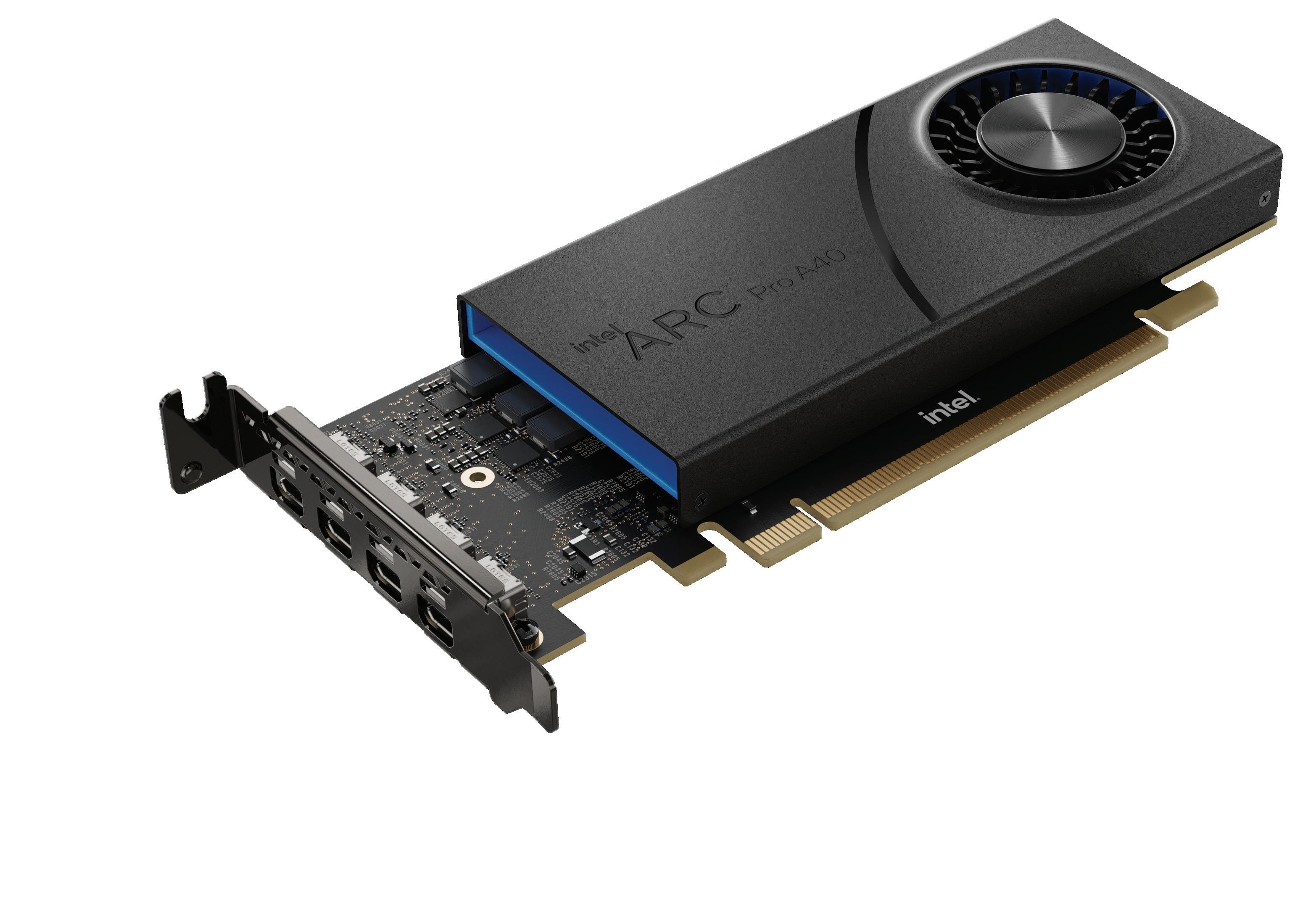
Graphics drivers
When you purchase a GPU, you are also investing in robust drivers for your software needs. Each new driver typically brings performance improvements, and a regular driver release cycle can bring frequent performance uplifts and new software support. Look for a 3-month release cycle from the vendor.
Form
A workstation graphics card is designed to meet the requirements of professional workstation cases. In particular, look for the power connector block on the edge, a high-performant fan, and a robust aluminium shroud (or protective casing).
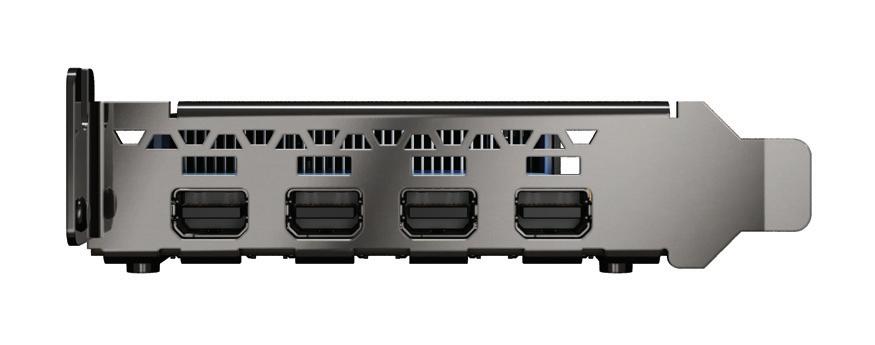
Display resolution
More pixels mean greater line detail displayed, although with ultrawide (UWD) monitors growing in popularity it’s important to check your GPU specifications can drive one. (Remember application interfaces rarely run above 4K resolution.)
Accurate colors
HDR (High Dynamic Range) technology allows the representation of more colors on your compatible display. In some CAD circumstances this isn’t needed, but for image production or renders this means greater depth and sharper contrast.
To learn more about Intel graphics visit intel.com/ArcProGraphics
2 3 4 5 6 8 9 10 12 7 11
Scan 3XS GWP-ME A132C & GWP-ME A132R
Between these two new desktop workstations, Scan has most bases covered in product development, from CAD and simulation to rendering and beyond, writes Greg
Corke
Scan is always one of the first out of the blocks with new technologies. And with the 3XS GWP-ME A132C and 3XS GWP-ME A132R it has delivered two powerful desktop workstations with the very latest processors from Intel and AMD.
The ‘C’ and ‘R’ suffixes refer to ‘Core’ and ‘Ryzen’, specifically the brand-new 13th Gen Intel Core and AMD Ryzen 7000 Series processors. As you will see from our indepth review on page WS4 these powerful new chips are extremely well suited to a range of professional workflows, from CAD and BIM to reality modelling and rendering.
Both of our test machines look identical and include several common components, but they differ in three main areas — CPU, motherboard, and GPU. So how do they fare in the typical workflows of designers?
The 13th Gen Intel Core workstation
Our Scan 3XS GWP-ME A132C test unit arrived with a top-end Intel Core i913900K CPU, paired with Nvidia’s entry-
level pro ray tracing and AI-accelerated GPU, the Nvidia RTX A2000. This combination of processors is well suited to CAD, BIM and entry-level visualisation, as well as more CPU-intensive workflows such as point cloud registration, photogrammetry, and simulation. Together with 64 GB of Corsair Vengeance DDR5 5,600MHz memory, a 2TB Samsung 980 Pro SSD and an Asus Z790-P WiFi motherboard, the unit will set you back £2,583 + VAT.
Everything is housed inside a 542 x 240 x 474 mm Fractal Design Meshify 2 chassis, adorned with Scan’s trademark 3XS custom front panel. It’s a solid, well-built case, with a ready supply of ports. Up front and top, there are two USB 3.2 Type A and one USB 3.2 Type C, with plenty more at the rear (four USB 2.0 Type A, three USB 3.2 Type A and one USB 3.2 Type C). Access is easy. Simply lift off the top panel and pull off the side to get to the parts inside. With the SSD mounted directly on the motherboard, a compact GPU, no hard disk drive (HDD), and all the cabling tucked neatly away, everything feels a little lost inside the spacious interior. But modern-day workstations are as much about keeping components cool as they are about expansion, and with the power-hungry Intel Core i9-


13900K CPU, Scan certainly has its work cut out here.
When rendering in KeyShot we recorded over 450W of power draw at the plug, pushing 530W in Solidworks Visualize, which can use both CPU and GPU. The Corsair H100i Pro XT liquid CPU cooler is well regarded as a thermal solution, but fan noise in this system is very noticeable under these heavy loads.
Product spec
■ Intel Core i9-13900K processor (3.0 GHz, 5.8 GHz turbo) (8 P-cores, 16 E-cores, 32 threads)
■ Nvidia RTX A2000 GPU (12 GB GDDR6)
■ 64 GB (2 x 32 GB)
Corsair Vengeance DDR5 5,600 memory
■ 2 TB Samsung 980 Pro NVMe SSD
■ Asus Z790-P WiFi motherboard
■ Corsair H100i Pro XT hydrocooler
■ 750W Corsair RMX, 80PLUS Gold PSU
■ Fractal Design
Meshify 2 chassis, adorned with 3XS custom front panel (542 x 240 x 474mm)
■ Microsoft Windows 11 Pro 64-bit

■ 3 Years warranty –1st Year Onsite, 2nd and 3rd Year RTB (Parts and Labour)
■ £2,583 (Ex VAT)
■ scan.co.uk/3xs
Performance is top notch, especially in CAD and BIM software. It delivered very impressive single threaded and lightly threaded CPU benchmark scores in Revit, Inventor, and Solidworks. The machine also set a new record when processing point clouds in Leica Cyclone. All four tests run entirely on the Core i9-13900K’s eight superfast P-Cores.
The processor’s 16 E-cores come into play when rendering. While performance in V-Ray and KeyShot is impressive, it doesn’t hit the heights of the AMD-based Scan workstation, propelled by its 16-core Ryzen 9 7950X CPU. Performance in Cinebench is much closer.
The processor is helped along by its 64 GB of DDR5 memory, which takes up two of the four slots on the Asus Z790-P WiFi motherboard. It is supported by a single 2TB Samsung 980 Pro SSD. Additional storage can
workstation special report
is well equipped to handle some fairly sizeable datasets for GPU rendering and real-time viz. But it has its limitations in real-time workflows. While it can comfortably handle complex models at FHD resolution, 4K is a bit of a stretch.
With our 9.5 GB Enscape office model, it dropped from 39 FPS @ FHD to 17 FPS @ 4K. And the slowdown is more dramatic as demands on the GPU grow – going from 43.3 FPS to 12.6 FPS with the Audi car configurator in Unreal Engine, and from 38.2 FPS to 16.2 FPS in our Autodesk VRED Professional car model with medium anti-aliasing.
As you might expect, GPU rendering performance is significantly lower than pro viz-focused GPUs like the RTX A4500. In the KeyShot benchmark 11.3.1 it recorded a score of 32 compared to 67 for the RTX A4500. In the V-Ray benchmark 5.02 it was 1,012 versus 2,119.
The Ryzen 7000 Series workstation
With the top-of-the-range AMD Ryzen 7950X CPU and powerful Nvidia RTX A4500 GPU, our Scan GWP-ME A132R test workstation is tuned for all types of demanding visualisation workflows. But this balance does come at a premium. At £3,583 Ex VAT, it’s precisely £1,000 more than the Intel machine.
The 16-core processor makes light work of ray trace rendering, second only to the 32-core and 64-core AMD
V-Ray and KeyShot, it demonstrates a 10% lead over its Intel-based sibling.
But with the powerful Nvidia RTX A4500 GPU with 20 GB of memory, users have choice. Both KeyShot and V-Ray, plus many other rendering tools, can take advantage of the dedicated ray-tracing and AI hardware within the dual slot card. And with careful juggling of CPU and GPU resources, this can bring new efficiencies to day-to-day workflows.
For real time viz, expect a silky-smooth viewport at 4K in all but the most demanding of workflows. It’s only when enabling real time ray tracing in Unreal Engine that frame rates drop below the golden 30 FPS, but 17.37 FPS is still acceptable.
Of course, a GPU this powerful is overkill for CAD and BIM. And with Revit and Inventor in particular, users will do just as well with an Nvidia RTX A2000, if not an Nvidia T1000. In fact, because these applications are so CPU limited, the Intel machine with its RTX A2000 actually wins out in viewport performance, as it does in core application workflows from model creation to data translation.
The workstation shares
machines, extremely well built with a 3-year warranty (1st year onsite) as standard. The big question on everyone’s lips is which one is best? That very much depends on what you do, day in day out.
Product spec
■ AMD Ryzen 9 7950X processor (4.5 GHz, 5.7 GHz boost) (16 cores, 32 threads)
■ Nvidia RTX A4500 GPU (20 GB GDDR6)
■ 64 GB (2 x 32 GB)
If your workflows centre on CAD or BIM, with a little bit of visualisation, then the 3XS GWP-ME A132C is a great choice. It has single-threaded performance in abundance, it’s no slouch in multi-threaded workflows either, and the GPU is a great entry point to realtime viz. However, fan noise really kicks in when it hits top gear. This is certainly not a quiet machine.
Corsair Vengeance DDR5 5,600 memory
■ 2 TB Samsung 980 Pro NVMe SSD
■ Asus TUF B650Plus WiFi mainboard
■ Corsair H100i Pro XT hydrocooler
■ 750W Corsair RMX, 80PLUS Gold PSU
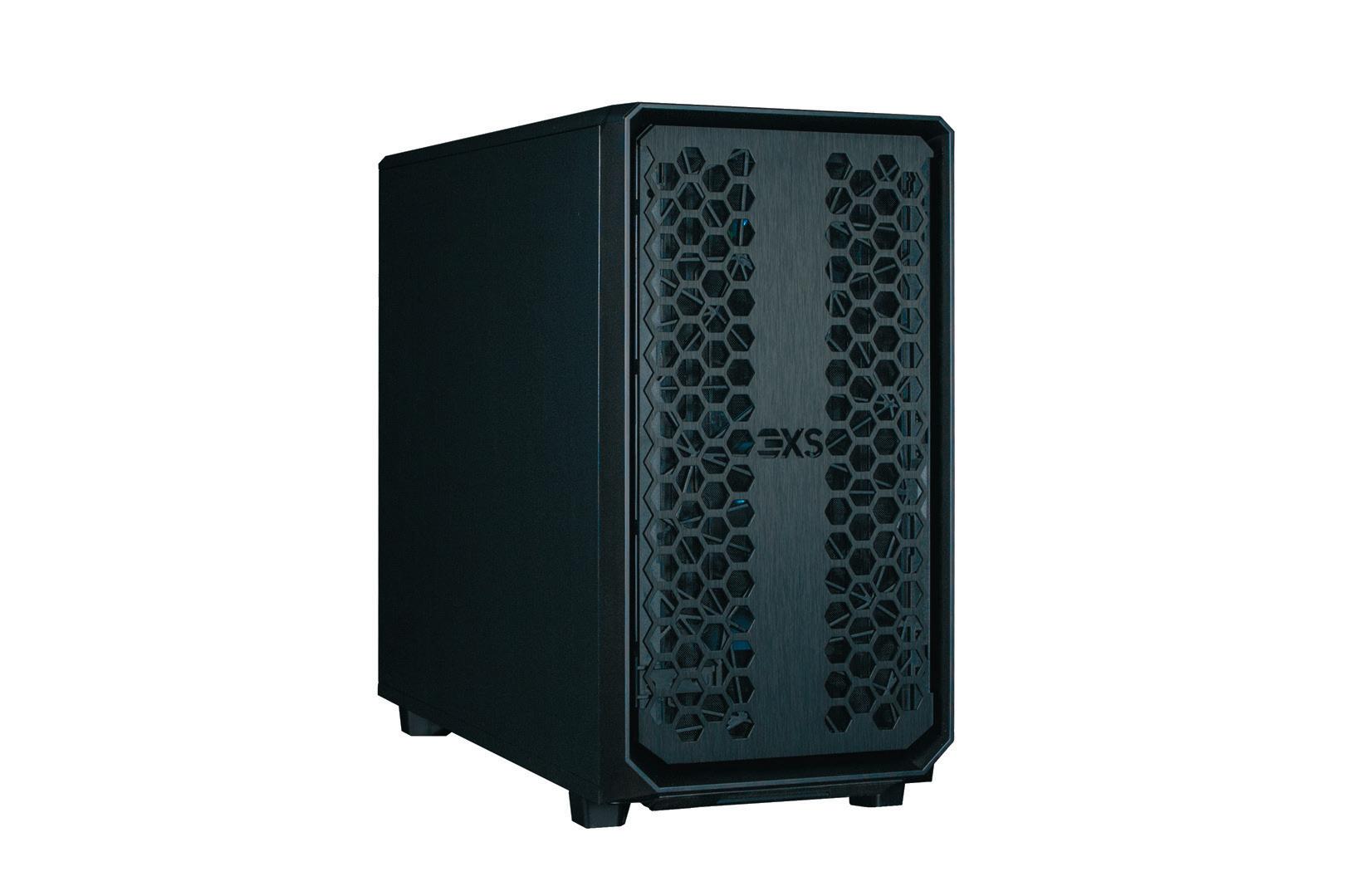
■ Fractal Design Meshify 2 chassis, adorned with 3XS custom front panel (542 x 240 x 474mm)
■ Microsoft Windows
11 Pro 64-bit
■ 3 Years warranty –1st Year Onsite, 2nd and 3rd Year RTB (Parts and Labour)
■ £3,583 (Ex VAT)
■ scan.co.uk/3xs
Meanwhile, the 3XS GWPME A132R delivers in all areas of visualisation, with the bestin-class CPU for rendering, a powerful pro GPU and good acoustics. But having this level of all-round performance does come at a premium, with our test machine costing a full £1,000 more than the Intel.
Of course, both machines are fully customisable, so you can pick and choose components to match your specific workflows. And there’s plenty of room to grow with an additional 64 GB of memory and buckets of storage.
WS15 www.develop3d.com December 2022 / January 2023 workstation special report

THE BEAST BEHIND THE BEAUTY Full spectrum performance for faster 3D Design. A force of innovation. AMD Ryzen™ Threadripper™ PRO processors offer industry leading high frequency core counts to help accelerate your creative process. Experience seamless 3D modeling and design while ripping through complex simulation and visualization. With Threadripper™ PRO you can confidently tackle the most demanding workloads on the ultimate CAD workstation. #AMD #TogetherWeAdvance To learn more www.amd.com/trpro ©2022 Advanced Micro Devices, Inc. All rights reserved. AMD, the AMD Arrow logo, Ryzen, Threadripper, and combinations thereof are trademarks of Advanced Micro Devices, Inc. Advanced Micro Devices, Inc., 2485 Augustine Drive, Santa Clara, CA 95054 USA
Boxx Apexx S4.04
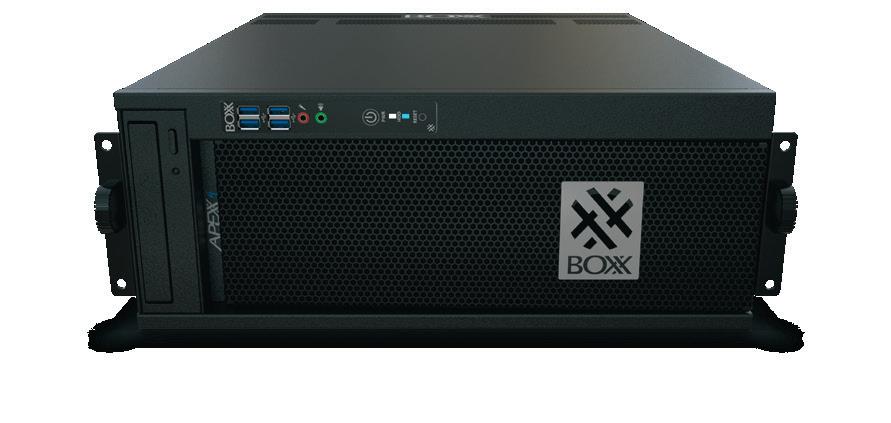
This powerful desktop workstation not only offers impressive performance for CAD, thanks to its enhanced Intel Core i9-13900K CPU, but it can be rackmounted for an easy-to-deploy resource for flexible working, writes Greg
Corke
Boxx has a long history of building high-performance custom workstations. The Texas-based company not only matches components to specific 3D workflows, but designs and manufactures its own chassis in ‘aircraft-grade’ aluminium. These are solid machines with a strength and rigidity beyond that of most off-the-shelf cases used by other custom manufacturers.
The Boxx Apexx S4.04 also stands out because it is a desktop workstation that can be rack mounted. While the ability to rack mount is not uncommon in workstations from major players like HP and Lenovo, it’s not something we often see done by custom manufacturers.
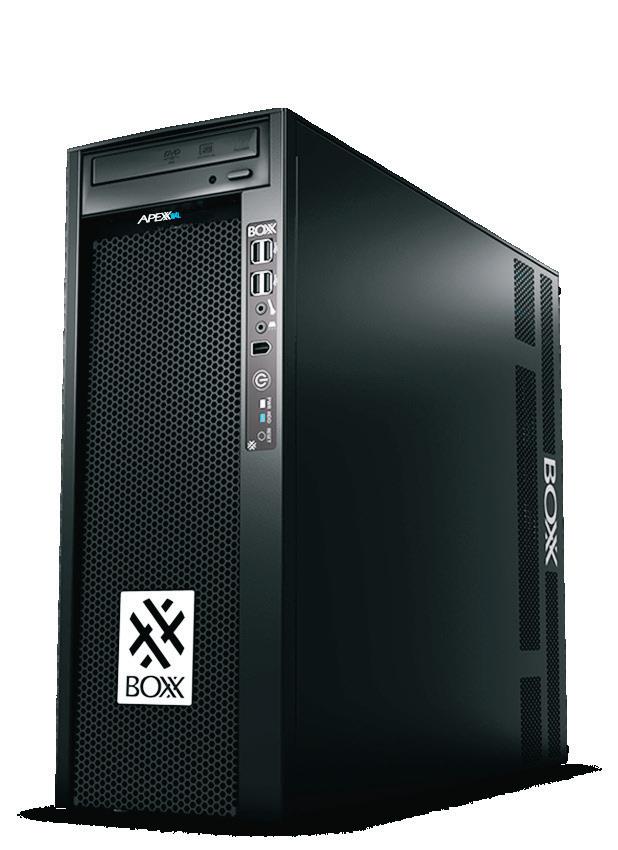
Boxx has been doing this for years, but it has never been more relevant. With increased demand for flexible working, it makes it easier for firms to support staff working from office or home. Simply set up the workstations in a centralised rack and remote into the machines from anywhere.
Of course, this can be done with dedicated rack workstations / servers, but rack-mounting desktop workstations has two major benefits: first you get the absolute best performance and second you don’t necessarily need a dedicated airconditioned datacenter or server room.
With the Apexx S4, the rack mount kit is included with the machine – you simply bolt it on to the chassis. It is designed to fit a 19” rack with 3/8” square holes.
Form certainly follows function here. The chassis is very angular, essentially a 4U box. There are no bevelled edges, a trademark of the Apexx S3, which offers the same core specs in a smaller chassis with less expandability. One gripe is there are no USB Type C ports on the front, and only two Type A (one of which is USB 2.0).
But there’s plenty at the rear — two USB Type C and eight USB Type A. Our test machine was maxed out in CPU and
memory, with the top-end Intel Core i9-13900K processor supported by 128 GB of DDR54800 MHz memory.
Product spec
■ Intel Core i9-13900K processor (3.0 GHz, 5.8 GHz turbo) (8 P-cores, 16 E-cores, 32 threads)
Boxx has ‘performance enhanced’ the CPU beyond its standard settings, which gives it an edge. It hit 5.97 GHz in single threaded workflows and 4.89 GHz on all cores, which it managed to maintain when rendering in KeyShot for over an hour. This translates to real performance benefits in core workflows. Compared to the other Core i9-13900K workstation we’ve reviewed, the Scan 3XS GWP-ME A132C (see page WS14), it was around 3-4% faster in single or lightly threaded tests in Autodesk Revit, and around 6% faster in the single threaded and multi-threaded Cinebench R23 benchmark. It was marginally slower in V-ray and KeyShot, but these benchmarks take less than a minute to run and, as we found previously, all core frequencies on the Scan machine drop after a couple of minutes.
■ Nvidia RTX A4000 GPU (16 GB GDDR6)
■ 128 GB (4 x 32 GB)
DDR5-4800 MHz memory
■ 1 TB Seagate 530
Firecuda SSD + 2 TB
7,200rpm Hard Disk Drive (HDD)
■ ASRock Z790
Taichi motherboard
■ Asetek 240mm
670LT closed loop liquid cooler
■ 1300W Seasonic Prime GX-1300 PSU
■ Custom chassis (174 x 457 x 513mm)
+ rack mount kit
■ Microsoft Windows 11 Pro 64-bit
■ 3 year return to base warranty
■ £5,400 (Ex VAT)
■ boxx-tech.co.uk
But Boxx doesn’t have the lead everywhere. Its choice of slower DDR5 4,800 MHz memory looks to have a significant impact on performance in some workflows. The Apexx S4 took 32% longer than the Scan workstation (DDR5 5,600 memory) to recompile shaders in Unreal Engine and 25% longer to process point clouds in Leica Cyclone 360. Both processes also use the GPU a little, so to check the GPU was not the major contributor to the drop in performance we swapped out the Nvidia RTX A4000 for the same GPU, but that only made a very small difference.
Smooth operator
One might presume that running all CPU cores at higher frequencies would have a negative impact on power draw and acoustics. However, this was not the case. Compared to the Scan machine, power draw with all cores was only slightly higher (458W vs 452W) and the Apexx S4 was also quieter. This is testament to Boxx’s CPU tuning and chosen cooling system, which comprises an Asetek 240mm 670LT closed loop liquid cooler and three 120mm fans at the front of the machine.
While CPU performance is top notch, Boxx has been more restrained with graphics. However, the Nvidia RTX A4000 is still an excellent GPU for CAD and mainstream
visualisation, and with 16 GB of GDDR6 memory it should cover many bases from real-time 3D to GPU rendering.
Indeed, at 4K resolution it delivers a perfectly adequate 25.89 Frames Per Second (FPS) with the Unreal Engine Audi Car Configurator model, and 32.15 FPS in VRED Professional with our automotive scene.
But the single slot card doesn’t reach the same heights as Nvidia’s dual slot RTX cards. And, if you really want to boost you GPU horsepower, then the Apexx 4 and its 1300W power supply, can handle up to dual Nvidia RTX A6000 GPUs, giving you a whopping 96 GB of GPU memory in supported applications.
For storage, there’s the classic combination of 1 TB NVMe SSD and 2 TB 7,200rpm Hard Disk Drive (HDD). Unlike most custom workstation manufacturers, which go with the Samsung 980 Pro, Boxx has chosen the Seagate 530 Firecuda. According to the company, this is down to the longevity of the SSD, with Seagate claiming an endurance of 1,275 Total Bytes Written (TBW), more than double that of the Samsung 980 Pro. Rounding out the specifications there’s 2.5G LAN, 802.11ax Wi-Fi 6E + Bluetooth.
The verdict
If you’re looking for an incredibly powerful, well-built rack mountable workstation for CAD and mainstream visualisation you’ll be hard pushed to find one better than this. However, there’s no escaping the fact that you’ll pay a premium for the pleasure.
There are ways to shed some pounds off the sizeable £5,400 (Ex VAT) price tag. Going down to 64 GB of DDR5 memory will save you £200 and not negatively impact performance, unless you work with very large datasets.
A downgrade to the Nvidia RTX A2000 (12 GB) will also save you £400 and while you’ll take a performance hit in design viz tools like Enscape, V-Ray and KeyShot, you should hardly notice any difference in Revit, Inventor, and Solidworks.
Finally, there’s the Boxx Apexx S3 to consider. If you don’t need to rack mount or expand into multiple HDDs or super high-end dual CPUs, then this more compact sibling should give you the exact same performance without making such a big dent in your precious workstation budget.
WS17 December 2022 / January 2023 workstation special report
HP Z2 Mini G9
After six years in service, HP has finally redesigned the chassis for its iconic tiny workstation. With better acoustics and significantly enhanced performance, there’s much to like about this diminutive desktop, writes
 Greg Corke
Greg Corke
In late 2016, HP broke the mould with a desktop workstation that was significantly smaller than any other from a major OEM. Since then the HP Z2 Mini has established itself as a firm favourite at DEVELOP3D.
But the original HP Z2 Mini design is now end of life. The G9 edition features a new all-metal chassis. Simple in form, it’s essentially a rectangular prism with rounded corners and a distinctive front mesh, through which air is drawn in, then expelled at the rear.
The beauty of the HP Z2 Mini G9 is its size — a mere 211 x 218 x 69mm. It can sit horizontally or vertically on the desk, kept stable with the included stand. And to keep on brand, the Z logo on the front can be rotated 90 degrees. It can even be VESA mounted under a desk or behind a display and paired with a wireless keyboard and mouse for a clutter free working environment. With integrated Intel WiFi 6E AX211 there’s no need for Ethernet. It’s an ideal machine for space constrained home offices — and there have been plenty of those over the last two years.
It’s 10mm thicker than the previous design, but that means significantly more performance. ‘Alder Lake’ 12th Gen Intel Core CPUs replace ‘Comet Lake’ 10th Gen and, with improved thermal management, the G9 can also support the 125W models, up to the Core i9-12900K. However, it’s important to note that these aren’t the latest ‘Raptor Lake’ 13th Gen Intel Core CPUs, as seen elsewhere in this special report, so are a little slower.
There’s also a wider choice of GPUs,
In single or lightly threaded workflows, the machine was only around 14-20% slower than the fastest 13th Gen Intel Core desktop. For a machine of this size, that’s impressive.
Product spec
■ Intel Core i7-12700K CPU (3.6 GHz base, 5.0 GHz Turbo, 8 P-cores, 4 E-cores, 20 threads)
■ Nvidia T1000 GPU (4 GB)
But in highly multi-threaded workflows like rendering things start to slow down. It not only has fewer E-cores than the top-end Core i9 processors, but due to the smaller chassis the CPU can’t clock as high, particularly under sustained loads. Rendering in Keyshot, for example, it only took 30 seconds for it to drop from 4.10 GHz to 3.48 GHz, although it then maintained that frequency for hours. Notably, there was hardly any fan noise throughout. Considering the thermal challenges of packing standard desktop components into a small chassis, this is quite an achievement, especially as some of the earlier HP Z2 Mini workstations could be quite noisy at times.
■ 32 GB DDR5-4800 memory (2 x 16 GB)
■ 1 TB, M.2 PCIe 4.0 NVMe SSD
■ 211 x 218 x 69mm
■ From 2.4 kg
■ Microsoft Windows 11 Pro
■ 3 year (3/3/3) limited warranty includes 3 years of parts, labour and on-site repair
■ Exact price as reviewed not available, but with Intel Core i7-12700 and Nvidia T1000 (8 GB)
£1,499 (Ex VAT)
■ www.hp.com/ zworkstations
The Nvidia T1000 hits the sweet spot for CAD, and the 50W GPU is available in 4 GB and 8 GB models. Our test machine’s 4 GB card performed well in Inventor, Revit and Solidworks, but with some of our larger Solidworks models that need more memory things slowed down, particularly at 4K resolution. Here, the 8 GB card would be a much better fit. An upgrade to the Nvidia RTX A2000 (12 GB) would take the machine into entry-level visualisation territory. Opening the case takes seconds — simply press the rear release button and slide off the top – but the small chassis does make servicing a bit tricky. To get to the storage, you’ll need to remove the GPU. To get to the memory, unscrew the CPU fan. In our test machine both SODIMM sockets were already taken but there’s a spare M.2 slot for a second SSD. There’s no PSU inside. Instead the HP Z2 Mini comes with a sizeable 280W external power adapter. Speaking of power, it drew a mere 160W at the plug when rendering.
Considering its size, the HP Z2 Mini G9 is well equipped with ports. There are two USB Type C and one USB Type A (charging) on the side, and three USB Type A at the rear, along with 1GbE LAN. A Flex I/O port allows you to add ports of your choosing — from more USB and 2.5GbE LAN to Thunderbolt and HDMi.
The verdict
HP has done an excellent job in updating this impressive micro workstation. The industrial design is excellent, the acoustics are improved, and it’s taken a big step forward in terms of performance.
But there are compromises to be made for a machine this small. While the HP Z2 Mini G9 does very well in single threaded and lightly threaded workflows, it falls off the pace with all cores in play. It simply can’t compete with larger towers when it comes to power and cooling. So if your workflows lean that way, there’s a tough choice to make: either maximise performance or minimise the impact on your desk.
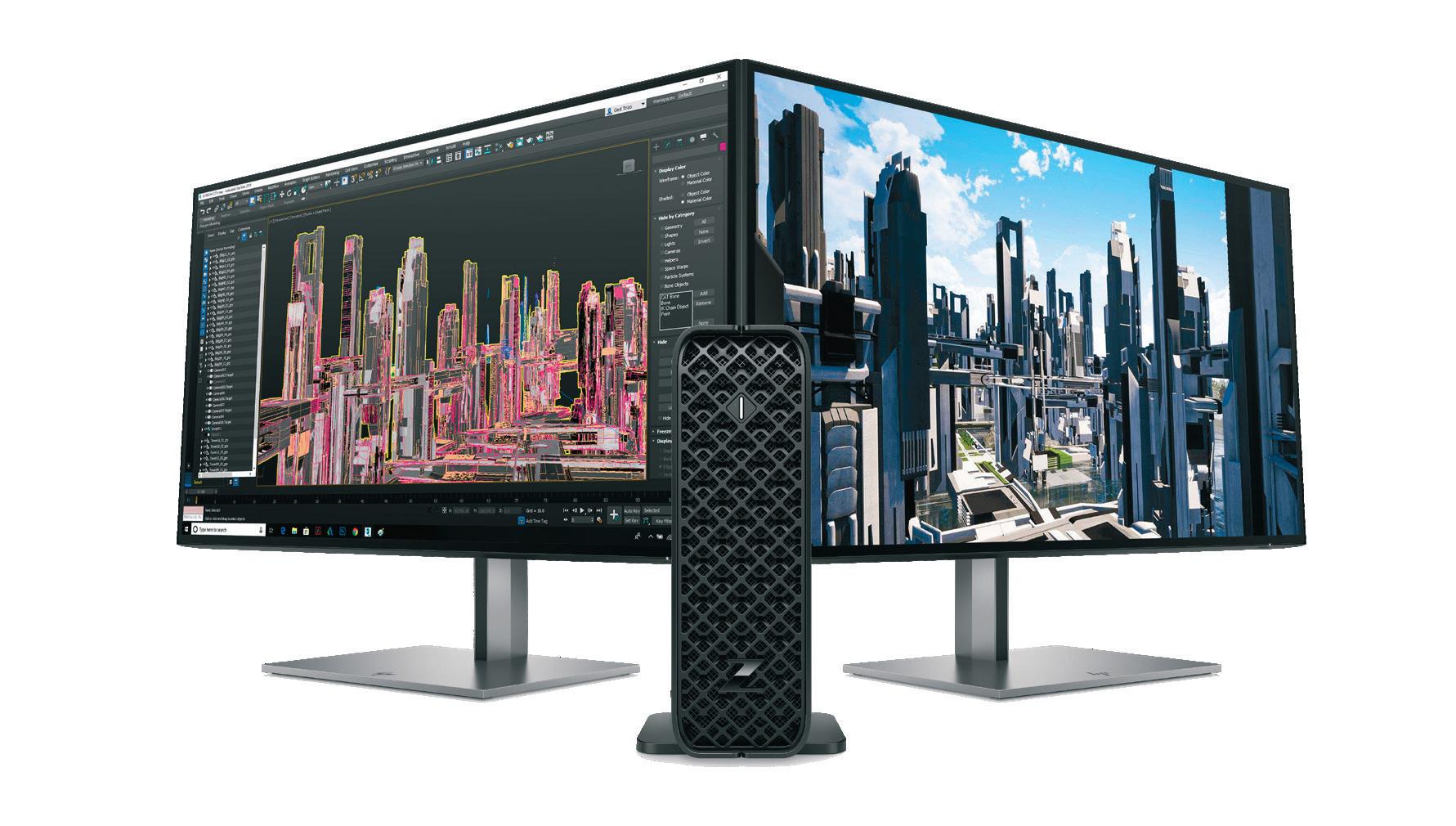
www.develop3d.com workstation special report
16 GB) and a 1 TB PCIe NVMe M.2 SSD.
Tiny desktop workstations the alternatives
Three more ultra-compact desktop workstations for space-constrained environments, or simply to sit pretty on your desk
Dell Precision 3260
At 190 x 72 x 178mm, Dell’s micro workstation is a little smaller than the HP Z2 Mini G9, but that narrows down your choice of CPUs to 65W ‘Alder Lake’ 12th Gen Intel Core.
This shouldn’t matter if you only use CAD — the difference in single threaded performance between the 65W Core i9-12900 and 125W Core i9-12900K will be negligible, but you’ll probably get less multi-threaded performance when rendering.
There’s no compromise on graphics with a choice of GPUs up the Nvidia RTX A2000 (12GB), covering CAD and entry-level viz.
The machine benefits from a wider choice of storage (2.5-inch HDDs and SSDs) and there are front USB ports for easy access.
It can be VESA-mounted and Dell’s compact all-in-one monitor stand (pictured right) helps keep your desk clutter-free. ■ dell.com/precision

Lenovo ThinkStation P360 Tiny

Tiny by name, tiny by nature, the ThinkStation P360 Tiny is by far the smallest workstation from a major OEM — coming in at 179 x 37 x 183mm. To give you an idea of just how small this machine is, simply look at the USB ports in the picture to the left. To keep thermals in check, one might presume the ThinkStation P360 Tiny can only have low power processors, but it can be configured with 35W or 65W ‘Alder Lake’ 12th Gen Intel Core CPUs (up to the Core i9-12900), plus a range of entry-level pro GPUs up to the Nvidia T1000 8GB - making it ideal for 3D CAD. The machine can be placed in desktop or tower mode (with the help of a stand) or secured under a desk or behind a VESA display with custom mounting brackets. It’s so small and light (1.4 kg) that you can easily throw it in a bag to move between office and home.
■ lenovo.com/workstations
Lenovo ThinkStation P360 Ultra

This is the most powerful of all the super compact workstations, with the option of a high-performance GPU that opens it up to new workflows. The top-end Nvidia RTX A5000 GPU (16 GB) makes it well suited to real-time viz and GPU ray tracing. However, don’t expect to get the exact same level of performance as you would from a standard tower. This is a mobile GPU on a custom desktop board, so draws a little less power.
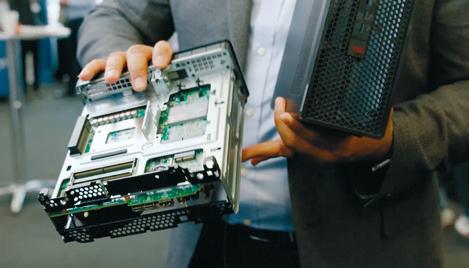
The ThinkStation P360 Ultra measures 87 x 223 x 202mm and features a unique design where the motherboard runs down the middle of the chassis to aid cooling and serviceability. Elsewhere, the system supports up to 128 GB of DDR5 SODIMM memory, which is double that of the slightly smaller HP Z2 Mini G9 and Precision 3260 Compact, and 12th Gen Intel Core processors up to 125W.
■ lenovo.com/workstations
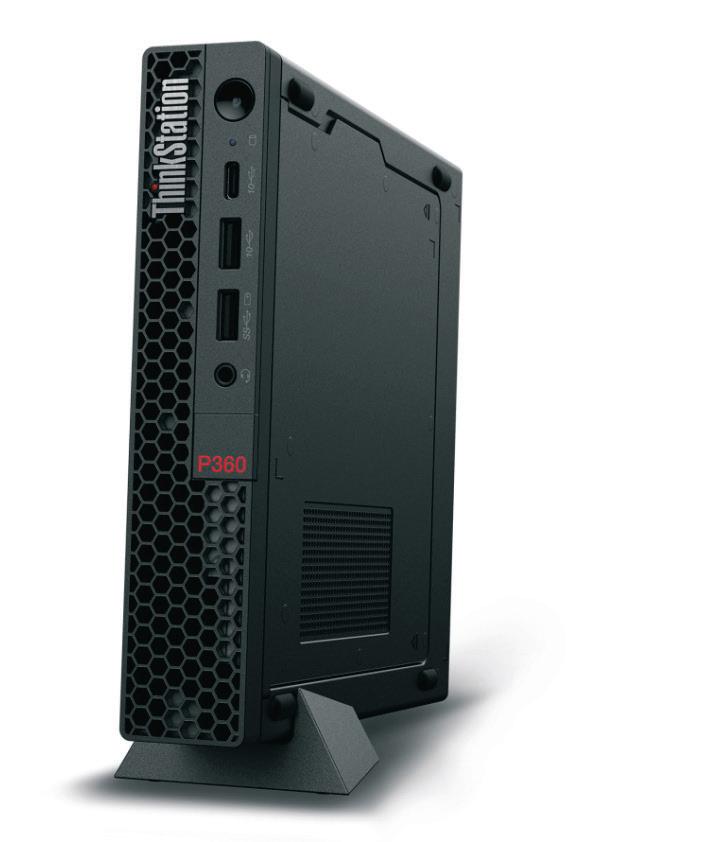
www.develop3d.com workstation special report
Check out our first look video www.tinyurl.com/P360-ultra WS19 December 2022 / January 2023
Armari Magnetar
M64TPRW1300G3
For this high-end workstation, Armari is getting the very best out of the powerful 64-core AMD Ryzen Threadripper Pro CPU, writes Greg
Corke
When it comes to tuning workstations and squeezing every last bit of performance out of high-end components, few can compete with Armari. The UK firm blew our minds in February 2020 with the Magnetar X64T-G3, which tore up the workstation rule book completely. It delivered never been seen before benchmark scores in multi-threaded workflows without compromising on single threaded performance. Ray trace rendering and 3D modelling had never been such good bedfellows.
The processor at the heart of the machine was the AMD Ryzen Threadripper 3990X, a 64-core chip for ‘consumers’ or ‘enthusiasts’ but not for workstations per se. An amazing CPU in its own right, Armari took it to the next level, tuning it with AMD Precision Boost Overdrive (PBO), a technology that allows processor core frequency to rise as long as the workstation can cool it adequately.
And the Magnetar X64T-G3 certainly could. Its Full Water Loop (FWL) cooling
system came with a giant radiator with nearly three times the surface area of those used in its other workstations. It meant that the CPU could sustain 550 – 650 watts of power in real world applications, with momentary boosts in excess of 800 watts.
Product spec
■ AMD Ryzen Threadripper Pro 5995WX processor (2.7 GHz, 4.5 GHz boost) (64-cores, 128 threads)
■ AMD Radeon Pro W6800 GPU (32 GB GDDR6)
Fast-forward nearly three years and Armari is taking a more conservative approach for its new 64-core desktop workstation. Built around the workstation-class AMD Ryzen Threadripper Pro 5995WX, the Armari Magnetar M64TPRW1300G3 is designed to work within a more moderate CPU power budget of 400 watts – 120 watts above the processor’s standard Thermal Design Power (TDP) of 280 watts. However, it still has a sprinkling of Armari magic. According to the company, it can hit all core frequencies that are 0.4 GHz to 0.5 GHz higher than the Dell Precision 7865 Tower and Lenovo ThinkStation P620. This, says Armari, is because it implements PBO, and the workstation giants do not.
■ 128 GB (8 x 16 GB)
DDR4-3200 ECC Registered memory
■ 2 x 2 TB Western Digital SN850 NVMe
4.0 M.2 2280 SSD
■ ASRock WRX80 Creator Motherboard
■ Armari Threadripper AIO CPU cooler
■ 1,300W PSU
■ Magnetar M60 Gen3 chassis (470 x 220 x 570mm)
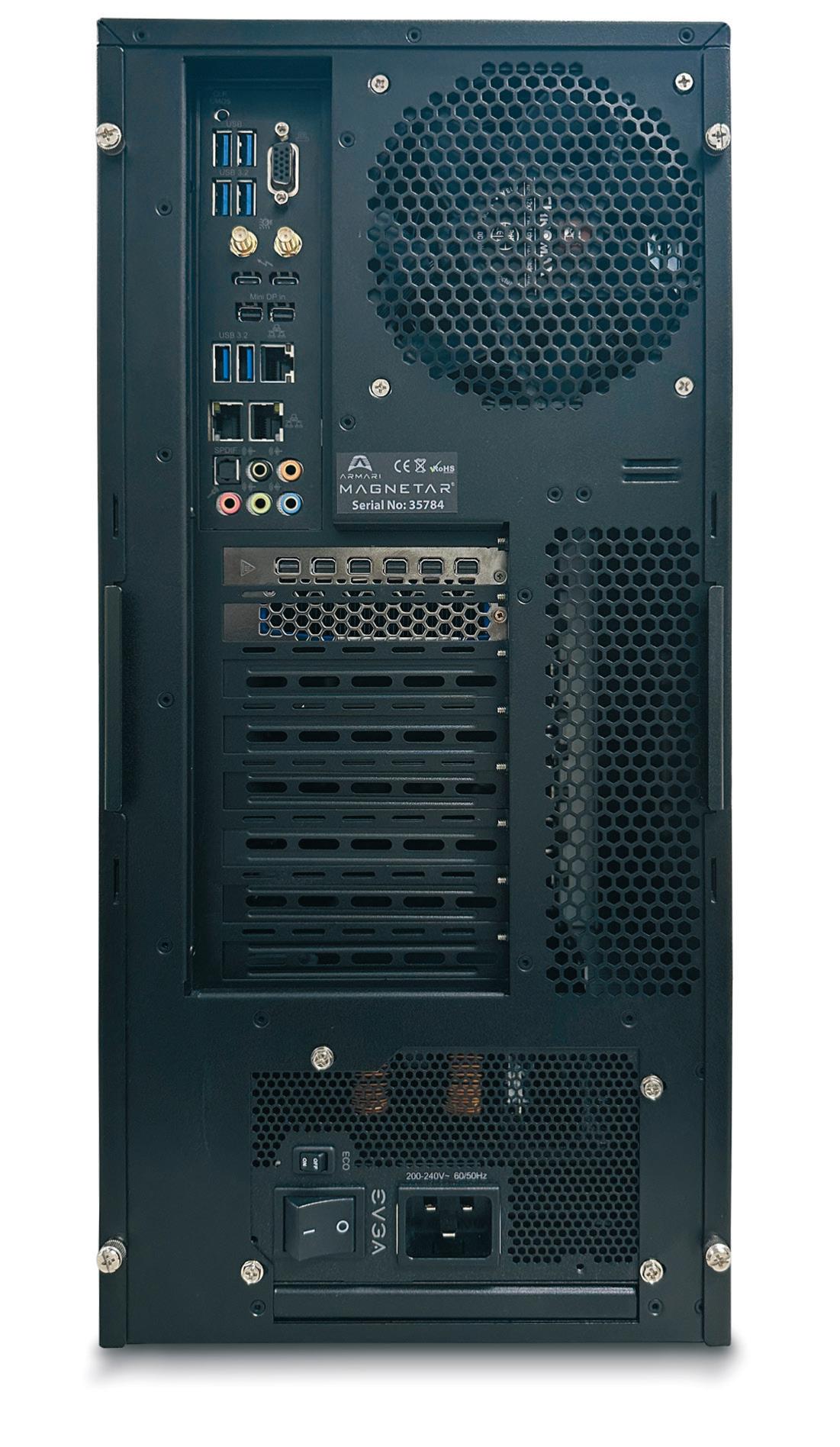

■ Microsoft Windows 11 Pro 64-bit
■ 3 Years RTB Parts & Labour, 1st year collect and return is included. Optional 7yr warranty available
■ £10,799 (Ex VAT)
■ www.armari.com
Ryzen Threadripper Pro
At this point it’s worth pointing out some differences between the workstation-class Ryzen Threadripper Pro processor and the
now discontinued ‘consumer’ Threadripper processor at the heart of Armari’s 2020 machine. ‘Pro’ includes more memory channels (8 vs 4), higher memory capacity (2 TB vs 256 GB), support for ECC memory, more PCIe lanes and several enterprise-class security and management features.
Considering few ‘consumers’ would ever need 64-cores, everything pointed towards AMD focusing all of its efforts on a workstation-specific Ryzen Threadripper processor, rather than a consumer Ryzen Threadripper processor used for workstation applications. Plus, AMD had most ‘consumer’ workflows well covered with AMD Ryzen with up to 16-cores.
On test
As you might expect Armari’s workstation excels in multithreaded workflows where the power of all 64-cores can be fully harnessed. This, of course, includes ray trace rendering, where the machine was between 1.95 and 2.29 faster than a 16-core AMD Ryzen 9 7950X workstation.
With four times as many cores as AMD’s ‘consumer’ chip, one might expect a bigger lead, but the Ryzen 9 7950X is based on AMD’s newer Zen 4 architecture, so benefits from a higher Instructions Per
WS20 www.develop3d.com December 2022 / January 2023 workstation special report
Clock (IPC). In the Scan GWP-ME A132R (see page WS14) it can also maintain a solid 5.0 GHz across its 16-cores. In contrast, the Threadripper Pro 5995WX peaked at 3.38 GHz in Cinebench and 3.45 GHz in KeyShot, though this is still around 0.7 GHz higher than the processor’s 2.70 GHz base frequency.
We saw similar results when recompiling shaders in Unreal Engine. We had expected the uplift in Unreal might be bigger because of Threadripper Pro’s 8-channel memory offering superior memory bandwidth, but this didn’t appear to be the case.
One area where we would expect to see a benefit from the machine’s 128 GB of DDR4-3200 ECC
Registered memory (8 x 16 GB modules) is in simulation. Computational Fluid Dynamics (CFD) software including Ansys Fluent and Finite Element Analysis (FEA) software Ansys Mechanical are well known to thrive on high memory bandwidth in certain workflows.
While the machine excels in rendering, it doesn’t win out in more lightly multithreaded workflows, where fewer cores are used. In our Leica Cyclone Register 360 point cloud processing benchmark, for example, which can use up to 6-cores, it was significantly slower than the Ryzen 9 7950X. AMD’s 16-core consumer processor also wins out in single-threaded workflows like CAD.
The Armari workstation is also no slouch when it comes to graphics workflows. With 32 GB of on-board memory, the AMD Radeon Pro W6800 is well equipped to handle colossal viz
Armari might have made its name in high-performance desktop workstations, but the company is now expanding into cloud – but with a difference.
Unlike most cloud workstations, which are virtual machines, Armari’s cloud workstations offer the exact same specs as the company’s desktop Threadripper Pro machines. And each user gets their own dedicated workstation which they can access remotely over a
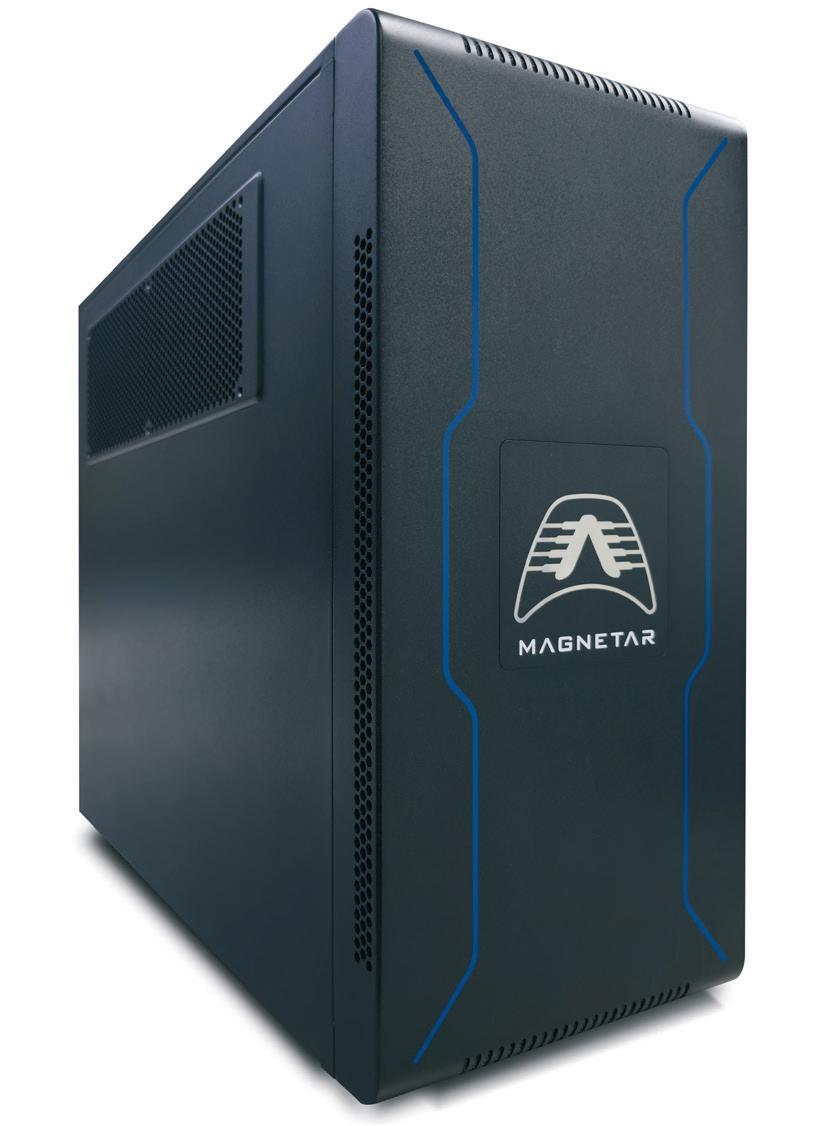
datasets. You’ll get the most out of this card in demanding applications like Unreal Engine and in VR, but it’s overkill for CAD. Compared to the rest of the machine, storage is quite pedestrian, courtesy of two 2 TB Western Digital SN850 NVMe M.2 2280 SSDs – one for OS and applications and one for data. But there’s plenty of scope for expansion. For I/O intensive workflows, RAID 0 SSDs are an option, and there are four bays for a range of drives including 3.5-inch HDDs.
The ASRock WRX80 Creator Motherboard also supports up to 2 TB of memory, so the machine can be configured to handle colossal datasets, way above the 128 GB limit of Ryzen 7000. There’s a whopping seven PCIe 4.0 x16 slots that can accommodate up to four double height graphics cards, so if GPU rendering is your thing, this has you covered. There are plenty of ports for peripherals including two USB Type A and one USB Type C, front / top. Dual 10Gb/s LAN and Intel 802.11ax (WiFi 6E) + Bluetooth is standard.
Smooth operator
As we’ve come to expect from Armari, the machine is solid and well-built, with a steel frame and lightweight aluminium side panels. It’s also extremely quiet when rendering on all 64-cores.
Considering the CPU is so powerful, this is quite a remarkable achievement. This is thanks to Armari’s use of low
1:1 connection. This means higher CPU frequencies for both single threaded and multi-threaded workflows.
To connect, Armari uses an ‘extensively modified’ Microsoft RDP service, which runs on the cloud workstations and is said to improve the experience and performance.
The so-called Armari ‘ripper-rentals’ service is designed to help firms either dynamically expand their workstation capacity without upfront
noise Noctua fans with a custom All-inOne (AIO) cooler designed to handle up to 500W on the CPU. Unlike the Full Water Loop (FWL) cooling system that Armari used in its ‘consumer’ Threadripper machine, the AIO is sealed for life so never requires servicing.
Fan noise only really became a minor annoyance when pushing the machine to its absolute limits, maxing out both processors at the same time — CPU rendering in KeyShot and GPU ray tracing in Unreal Engine. Doing so also drew a colossal 700W of power at the socket, so be warned!
The verdict
Armari’s Threadripper Pro workstation is the type of machine you feel you can throw anything at, and it will just keep on going. Even with extreme multi-tasking everything feels responsive.
If your workflows demand lots of CPU cores, Threadripper Pro delivers everything you would want in a high-end workstation processor. And Armari certainly knows how to get the most out of it.
At the moment, Intel has nothing that can compete. But doesn’t AMD just know that. The price of its flagship workstation processor has risen considerably since first gen Threadripper Pro and the 64core Threadripper Pro 5950X processor alone is just shy of an eye-watering £6,000 + VAT. This is huge jump up from the previous generation, where £6,755 + VAT would have got you an entire 64-core Threadripper Pro 3995WX workstation (a Lenovo ThinkStation P620) with 128 GB RAM, 1TB SSD and an Nvidia Quadro RTX 5000 GPU.
What you’ve probably guessed from all of this is that the Armari Magnetar M64TP-RW1300G3 is not exactly cheap. As reviewed, it comes in at an eye watering £10,799 + VAT. But for a machine that can completely transform certain workflows, delivering more iterations in shorter timeframes, many will feel this is a price worth paying.
capital expense, or to give customers access to a workstation while they are waiting for their physical machine to arrive. Those who order a qualifying workstation within 30 days from the last day of their rental can claim up to 50% of the rental cost back against the new system.
Armari also offers VPN and LAN-to-LAN bridges to allow firms to dynamically add machines to their existing network.
Armari says that, once
the order is placed, the workstation will be ready to use within 15 minutes.
We gave the service a quick test drive. It’s certainly very easy to get started - simply punch the supplied credentials into the Microsoft Remote Desktop app and away you go.
Within minutes we had Enscape running in a smooth responsive environment, using a standard laptop over WiFi. However, latency is on our
side as we are just down the road from Armari’s HQ in Watford, where the workstations are located.
The service is currently recommended for users across the UK, but Armari is in the process of testing in Europe. Coverage may be extended by colocating machines in other datacentres.
Prices start at £350 per week (£50 per day). Minimum rental period is seven days. Armari also offers a free trial.
WS21 www.develop3d.com December 2022 / January 2023 workstation special report
Threadripper Pro in the cloud

©2022 Advanced Micro Devices, Inc. All rights reserved. AMD, the AMD Arrow logo, Radeon, AMD RDNA, Ryzen and combinations thereof are trademarks of Advanced Micro Devices, Inc. Other product names used in this publication are for identification purposes only and may be trademarks of their respective companies. PID#: 21771403 Ver#:02 smart performance. smart pairing. Get the ultimate software experience with up to a gigantic 32GB of lightning-fast framebuffer, high-performing hardware raytracing, optimizations for up to 6 ultra-high res HDR displays, and superior multitasking capabilities. All wrapped around an award-winning graphics architecture, called AMD RDNA™ 2 which is the proven graphics foundation for the leading, visually rich gaming consoles. The latest AMD Radeon™ PRO W6000 Series graphics is compatible with modern workstations offering additional optimizations for select AMD Ryzen™ based processors, harnessing the GPU’s and system’s full performance potential. #AMD #TogetherWeAdvance To learn more visit amd.com/RadeonPRO
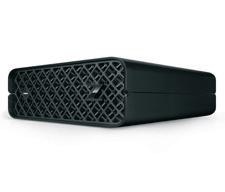


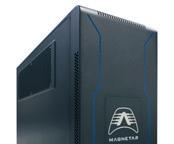


WS23 www.develop3d.com December 2022 / January 2023 workstation special report HP Z2 Mini G9 Scan 3XS GWP-ME A132C Scan 3XS GWP-ME A132R Boxx Apexx S4.04 Armari Magnetar M64TP-RW1300G3 Dell Precision 5470 CPU Intel Core i7-12700K Intel Core i9-13900K AMD Ryzen 9 5950X Intel Core i9-13900K AMD Ryzen Threadripper Pro 5995WX Intel Core i7-12800H GPU Nvidia T1000 (4 GB) Nvidia RTX A2000 (12 GB) Nvidia RTX A4500 Nvidia RTX A4000 AMD Radeon Pro W6800 Nvidia RTX A1000 (4 GB) Memory 32 GB DDR5-4800 64 GB DDR5 5600 64 GB DDR5 5600 128 GB DDR5-4800 128 GB DDR4-3200 32 GB DDR5 5,200 Primary storage 1 TB NVMe SSD 2 TB Samsung 980 Pro NVMe SSD 2 TB Samsung 980 Pro NVMe SSD 1 TB Seagate 530 Firecuda SSD 2 TB Western Digital SN850 NVMe SSD 1 TB NVMe SSD Price (Ex VAT) Approx £1,499 (see page WS18) £2,583 £3,583 £5,400 £10,799 £3,119 Autodesk Inventor Professional 2023 (Invmark) Modelling 1,912 2,307 2,141 2,319 1,941 1,602 Drawing 1,745 2,166 1,959 2,138 1,394 1,384 Assemblies 2,172 2,615 2,487 2,578 1,674 2,053 Assembly Pattern 1,975 2,327 2,080 2,261 1,424 1,887 Assembly Build 2,163 2,652 2,545 2,625 1,701 2,010 Ray Tracing 2,707 5,706 5,593 5,680 11,744 2,041 Data Translation 1,440 1,743 1,544 1,689 1,124 1,252 Opening files 2,171 2,807 2,757 2,790 1,971 2,152 Saving to disk 1,262 1,240 1,364 1,671 1,134 1,262 Dynamic Sim 2,171 2,611 2,509 2,521 1,449 2,091 FEA 1,328 1,473 1,434 1,470 1,132 1,210 Graphics (4K) 3,389 5,068 4,874 4,797 2,966 3,582 (FHD) Solidworks Professional 2022 (SPECapc) CPU ray trace 3.30 7.25 6.78 7.35 13.28 2.44 CPU rebuild 2.07 2.41 2.32 2.49 1.59 1.74 CPU convert 1.95 2.28 2.17 2.37 1.5 1.67 CPU simulate 1.75 2.18 1.99 2.08 1.6 1.62 CPU mass properties 2.09 2.41 2.57 2.39 1.68 1.65 CPU Boolean 1.86 2.26 2.06 2.21 1.44 1.58 Graphics (AA, shaded, edges) (4K) 0.50 1.12 2.4 2.52 1.19 2.01 (FHD) Graphics (AA, shaded, edges, RealView) (4K) 0.59 1.23 2.79 2.68 2.03 2.48 (FHD) V-Ray 5.0 CPU benchmark 13,288 26,952 29,458 26,548 66,461 7,556 Cinebench R23 Multi-core 16,943 37,862 37,601 39,978 73,520 12,396 KeyShot 11.3.1 benchmark CPU test 2.67 5.65 5.70 5.48 13.06 1.82 Benchmarks (frames per second) (FPS) (bigger is better) Enscape 3.1 Enscape 3.1 architectural sample project (FHD / 4K) 36.7 / 14.05 72.20 / 26.55 152.7 / 56.35 131.47 / 48.67 40.43 / 23.4 50.25 (FHD only) Unreal Engine 4.26 Audi Car Configurator model (FHD / 4K) 13.13 43.34 / 12.59 109.94 / 34.45 84.54 / 25.89 101.37 / 29.12 23.23 (FHD only) Audi Car Configurator model (Ray Tracing) (FHD / 4K) N/A 25.62 / 6.63 62.91 / 17.36 50.23 / 14.05 39.81 / 10.53 N/A Autodesk VRED Professional 2023 Automotive test model (no Anti-Aliasing) (FHD / 4K) 30.7 / 10.85 68.2 / 25.7 150.1 / 62.6 129.2 / 52.2 44.25 / 34.05 40.5 (FHD only) Automotive test model (medium Anti-Aliasing) (FHD / 4K) 16.4 / 7.00 38.22 / 16.25 90.1 / 40.3 70.9 / 32.15 38.85 / 26.48 23.2 (FHD only) Automotive test model (ultra-high Anti-Aliasing) (FHD / 4K) 7.80 / N/A 18.7 / 6.35 45.5 / 15.9 36.18 / 12.75 28.95 / 14.1 10.8 (FHD only) Benchmarks (time - seconds) (smaller is better) Autodesk Revit 2021 RFO 3.1 benchmark - Model Creation 72.7 61.5 68.9 59.8 94.1 76.1 RFO 3.1 benchmark - Export 222.1 189.6 211.4 182.1 292.7 247.9 RFO 3.1 benchmark - Rendering 30.6 18.8 19.8 19.7 19.1 43.5 RFO 3.1 benchmark - Graphics (FHD) 37.9 16.9 18.2 16.6 29.2 20.1 Leica Cyclone Register 360 Point cloud registration (large dataset) 3,327 (runs on 2 threads) 1,106 (runs on 5 threads) 1,194 (runs on 5 threads) 1386 (runs on 6 threads) 1,794 (runs on 6 threads) 4,295 (runs on 2 threads) Unreal Engine 4.26 Recompile Shaders (Audi Car Configurator model) 383.3 194.4 189.7 256.0 84.9 594.4
Dell Precision 5470
This highly portable 14-inch mobile workstation impresses. Equipped with an Nvidia RTX A1000 GPU, it opens up possibilities beyond those of mainstream 3D CAD for this historically less popular form factor, writes Greg
Corke
The 14-inch mobile workstation form factor has come and gone over the years. They’ve never been great sellers, partly because performance has significantly lagged behind their 15-inch counterparts. But with the Precision 5470, Dell is looking to change that.
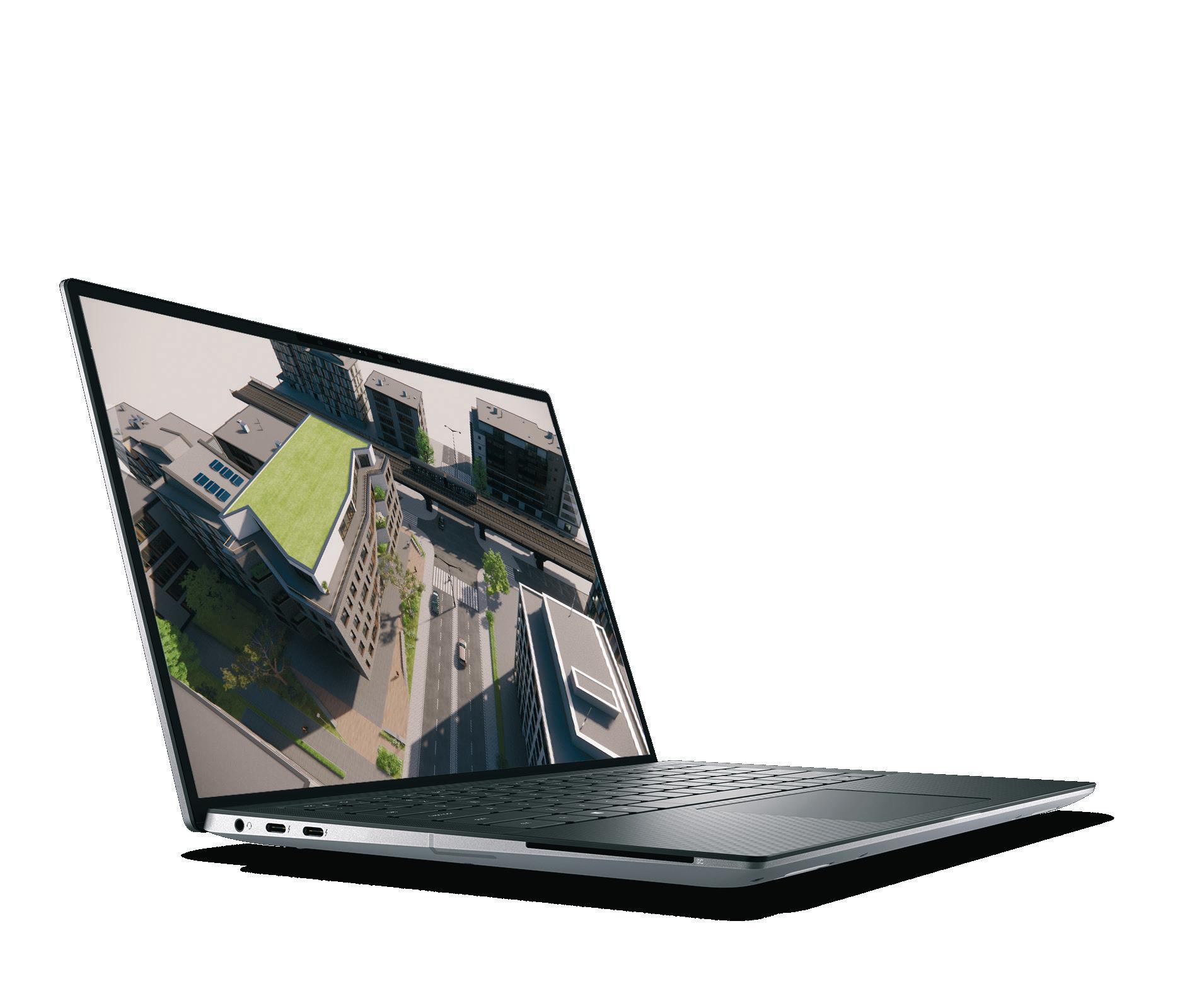
With a choice of 45-watt 12th Gen Intel Core H-Series CPUs and the Nvidia RTX A1000 GPU, this workstation-class 14-inch laptop certainly stands out from the competition. The HP ZBook Firefly comes with the less powerful Nvidia RTX A500 GPU while the Lenovo ThinkPad P14s has the Nvidia T550, which does not have RTX acceleration. Both laptops are also limited to 28-watt 12th Gen Intel Core P-Series CPUs.
Having a higher wattage CPU shouldn’t
12800H. When rendering in KeyShot it maintained 2.5 GHz across all P-cores. And it managed to do this without making too much noise, even in Dell’s ‘Ultra Performance mode’ where processor and cooling fan speed is increased for more performance. However, in Solidworks Visualize, when CPU and GPU can be hammered at the same time, CPU frequency dropped to 1.5 GHz and fan noise increased considerably. For a better balance of performance and noise choose the ‘optimised’ setting in Dell’s Power Manager where frequency drops to 1.3 GHz. The ‘Quiet’ setting takes this even lower, to 0.9 GHz. Tuning down the CPU in this way should also extend battery life when not plugged in.
Product spec
■ Intel Core i7-12800H processor (2.40 GHz, 4.80 GHz Turbo) (6 P-cores, 8 E-cores, 24 threads)
■ Nvidia RTX A1000 GPU (4 GB)
■ 32 GB, DDR5, 5,200 MHz, integrated memory
■ 1 TB, M.2 PCIe 4.0
NVMe SSD
■ 14-inch FHD+ (1,920 x 1,200)
100% sRGB, 500 nits display
■ 311mm x 210mm x 18.95mm (w/d/h)
■ From 1.48 kg
■ 14-inch FHD+ (1,920 x 1,200)
100% sRGB, 500 nits display
■ Microsoft Windows 11 Pro

■ ProSupport and Next Business Day Onsite Service, 36 Month
For graphics, the Nvidia RTX A1000 (4 GB) GPU easily delivers for 3D CAD and BIM, in applications like Revit and Inventor, but it also offers enough performance for entrylevel visualisation at FHD+ (1,920 x 1,200) resolution. With a small to medium sized BIM model in Enscape, the 50 Frames Per
■ £3,119 (Ex VAT)
■ www.dell.com/ precision
responsive, although a little small compared to larger machines. The Pro 2.5 keyboard is excellent with a fingerprint reader built into the power button. Alternatively, gain access to the machine through facial recognition with the Windows Hello compliant HD IR camera.
The 100% sRGB, 500 nits IPS display is perfectly respectable, but lacks the impact of brighter and more vibrant OLED displays available on larger pro laptops. Our test machine’s FHD+ (1,920 x 1,200) display resolution is well matched to a machine of this size, adding a few more pixels to the standard FHD (1,920 x 1,080). For higher pixel density, there’s a QHD+ (2,560 x 1,600) touchscreen option, though this will increase load on the GPU, probably reducing frame rates a little in graphics-hungry viz applications. The lnfinityEdge bezel contributes to the compact 311mm x 210mm footprint. Weight starts at 1.48kg, plus 0.47kg for the 130W AC adapter including UK plug.
The laptop is slim, maxing out at 18.95mm, which means it’s USB-C only (two Thunderbolt 4 ports left, two right). There’s no HDMi, DisplayPort, or Ethernet, but Dell includes a USB-C to HDMi / USB-A adapter in the box. Of course, to increase the connectivity options, there’s an optional Dell Thunderbolt 4 Dock. Superfast wireless is standard, courtesy of the Intel AX211 Wi-
There’s much to like about this highly portable 14-inch mobile workstation. Historically, machines of this size have been limited in what they can be used for, mostly because their GPUs have struggled with anything more demanding than small to medium sized 3D CAD models. However, the Dell Precision 5470’s Nvidia RTX A1000 GPU expands the possibilities considerably, making it a viable option for entry-level visualisation.
This impressive balance of performance and portability doesn’t come cheap, however. Our test machine comes in at £3,119 (Ex VAT). Still, considering the flexibility a lightweight laptop like this can give you, some will certainly find it a price worth paying.
www.develop3d.com workstation special report
Lightweight workstation laptops the alternatives
Six more options for ultra-portable mobile workstations to take CAD and design visualisation on the road — all less than 20mm thick and most below 2kg
1 Dell Precision 5570
The 15.6-inch Dell Precision 5570 is the latest incarnation of one of our favourite workstation laptops. It’s very portable, considerably smaller than the 16-inch Lenovo ThinkPad P1 G5 and HP ZBook Studio G9. It’s a mere 7.7mm at the front, 11.64mm at the rear (although this is slightly misleading, as Dell doesn’t appear to include the display in this measurement). It starts at 1.84kg.
Despite its sleek aesthetic, it still includes perfectly good processors for CAD, including up to the Intel Core i9-12900HK CPU and Nvidia RTX A2000 (8 GB) GPU, which includes hardware ray-tracing to make your CAD models pop.
One trade off of the slender chassis is no USB Type A ports (only USB Type C / Thunderbolt 4), although it ships with a USB Type A and HDMi dongle.
2 Dell Precision 5770
17-inch mobile workstations used to be all about performance and expandability with high-end GPUs and loads of storage, but the Dell Precision 5770 is a far cry from these heavyweights of old. Trading off some GPU power for more portability, you get a stunning 17-inch UHD+ (3,840 x 2,400) InfinityEdge display for detailed design work in a 2.17kg, sub 20mm chassis.
The Nvidia RTX A3000 GPU might not be top notch, but it’s a step up from the 15.6-inch Precision 5570’s Nvidia RTX A2000 and has 12GB of GPU memory to raise the ceiling on the size of datasets it can handle.
It has four Thunderbolt 4 ports (USB Type C with DisplayPort) and relies on the included dongle for USB Type A and HDMi.
■ www.dell.com/precision
3 HP ZBook Studio G9
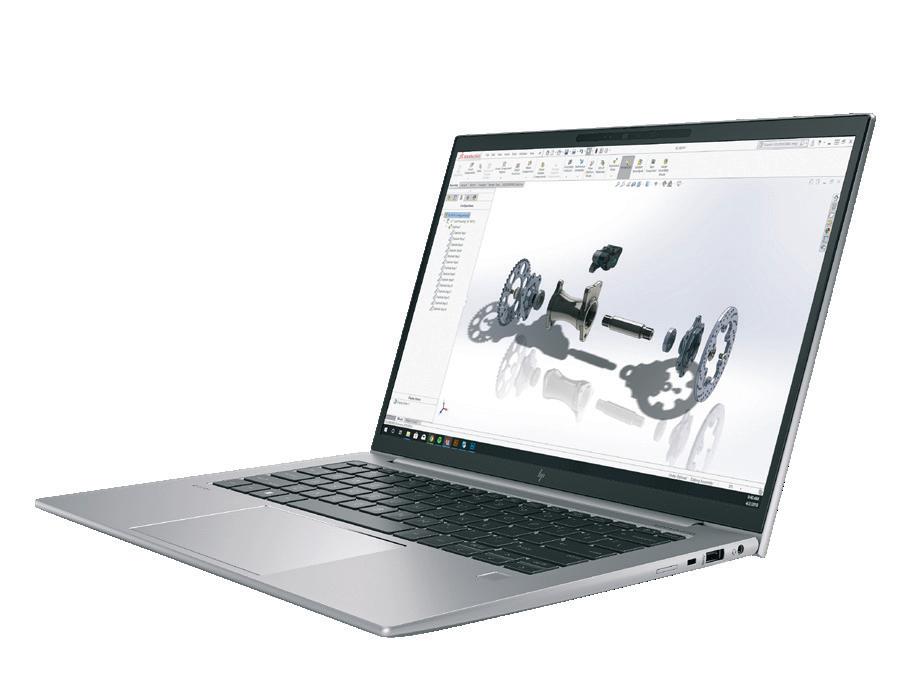
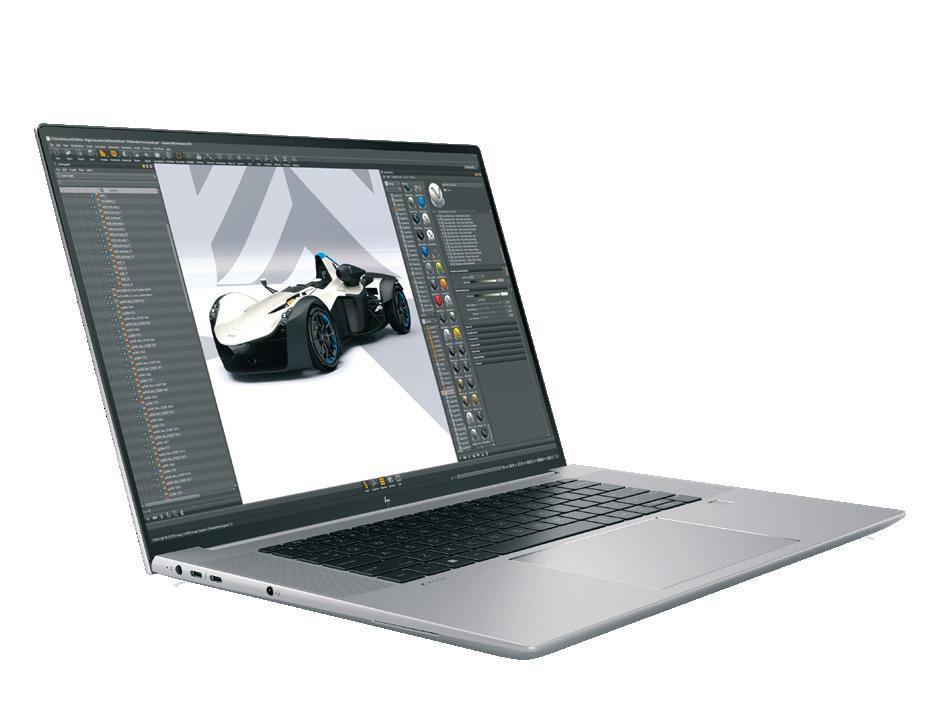
For the G9 edition of this slimline pro laptop, HP made the switch from a 15.6-inch to a 16-inch panel. This made it a tiny big bigger than the G8 edition, but with a 16:10 aspect ratio 4K (3,840 x 2,400) display (with Dreamcolor and OLED options) you get 11% more usable screen area than the previous 16:9. Memory has also been improved with 64 GB, double that of the G8, which was a little lacking. Compared to the beefier HP ZBook Fury G9, the HP ZBook Studio G9 offers slightly less powerful 12th Gen Intel Core H-Series processors with up to 6 P-cores and 8 E-cores. Graphics options are similar, up to the Nvidia RTX A5500 (16 GB), but with a lower power draw, expect slightly www.hp.com/zworkstations
4 HP ZBook Firefly G9
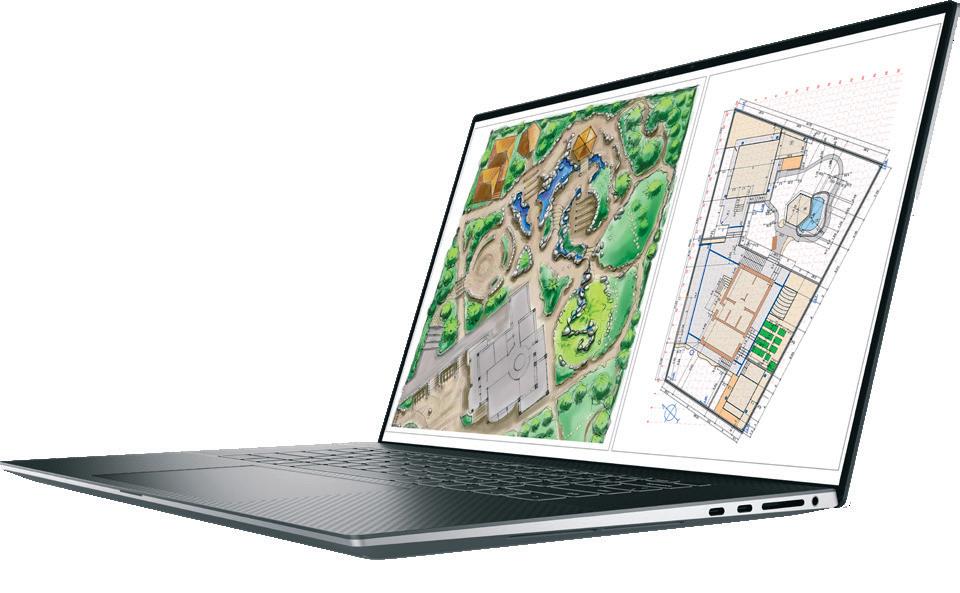

The HP ZBook Firefly G9 comes in two sizes - 14-inch and 16-inch. With a chassis depth of 19.9mm, the budget mobile workstation just about makes it into our sub 20mm roundup. Users get a choice of low power 12th Generation Intel Core i7 Processors. These should still deliver good performance in single threaded CAD-centric workflows, and some of the super power efficient 15W ‘U’ models will save you money. However, with fewer cores and a lower power budget, multi-threaded renders will take longer.
The GPU choices are limited, with only 4 GB options available. Both machines offer the Nvidia T550 GPU, while the 16-inch model can also be configured with the Nvidia RTX A500. However, despite having hardware enabled ray tracing, it’s still really just suited to mainstream CAD. ■ www.hp.com/zworkstations
5 Lenovo ThinkPad P1 G5


6 Lenovo ThinkPad P14s G3 (Intel and AMD editions)
The CAD-focused 14-inch ThinkPad P14s G3 comes in two variants - an ‘Intel’ edition with 28W 12th Generation P series Intel Core processors and an Nvidia T550 (4GB) GPU and an ‘AMD’ edition with AMD Ryzen 5 / 7 Pro 6000 U Series processors and integrated AMD Radeon 680M graphics with Pro APU driver.
Both share the same 17.9mm chassis, but by combining CPU and GPU onto a single chip the ‘AMD’ edition is slightly lighter, starting at 1.28kg. The ‘Intel’ edition has a slight edge in memory capacity (48 GB vs 32 GB).
The laptop stands out for its optional 4K IPS display, which is higher res than others, a FHD camera, HDMi, two USB Type A ports and two USB Type C. ■ www.lenovo.com/ workstations
WS25 December 2022 / January 2023 workstation special report
Lenovo was one of the first OEMs to make the switch from a 16:9 aspect ratio 15.6-inch display to a 16:10 16-inch display, so this is largely a refresh of the G4 edition with 12th















3XS GW-CAD T120C LN130226 • Intel Core i5 13600K • 16GB DDR4 • 8GB NVIDIA T1000 • 1TB M.2 SSD • Microsoft Windows 11 Pro • 3 Year Premium Warranty 3XS GW-AEC A132C LN130231 • Intel Core i9 13900K • 32GB DDR4 • 16GB NVIDIA RTX A4000 • 1TB M.2 SSD • Microsoft Windows 11 Pro • 3 Year Premium Warranty 3XS GW-CAD A124C LN130228 • Intel Core i7 13700K • 16GB DDR4 • 12GB NVIDIA A2000 • 1TB M.2 SSD • Microsoft Windows 11 Pro • 3 Year Premium Warranty 3XS GW-AEC A132C LN130341 • Intel Core i9 13900K • 32GB DDR4 • 20GB NVIDIA RTX A4500 • 1TB M.2 SSD • Microsoft Windows 11 Pro • 3 Year Premium Warranty Cost-efficient workstations optimised for CAD applications such as AutoCAD, Rhinoceros & SketchUp Streamline your building projects with workstations optimised for AEC & BIM applications such as Ansys, Archicad & Revit £ 1,599.99 INC VAT £ 2,699.99 INC VAT £ 1,949.99 INC VAT £ 3,099.99 INC VAT Find your perfect workstation today at: scan.co.uk/shop/pro-graphics • 01204 47 47 47 The only limit is your imagination Workstations for every workflow
Speed up modelling, animating and rendering with workstations optimised for M & E applications such as 3DS Max, Cinema4D & Unreal Engine £

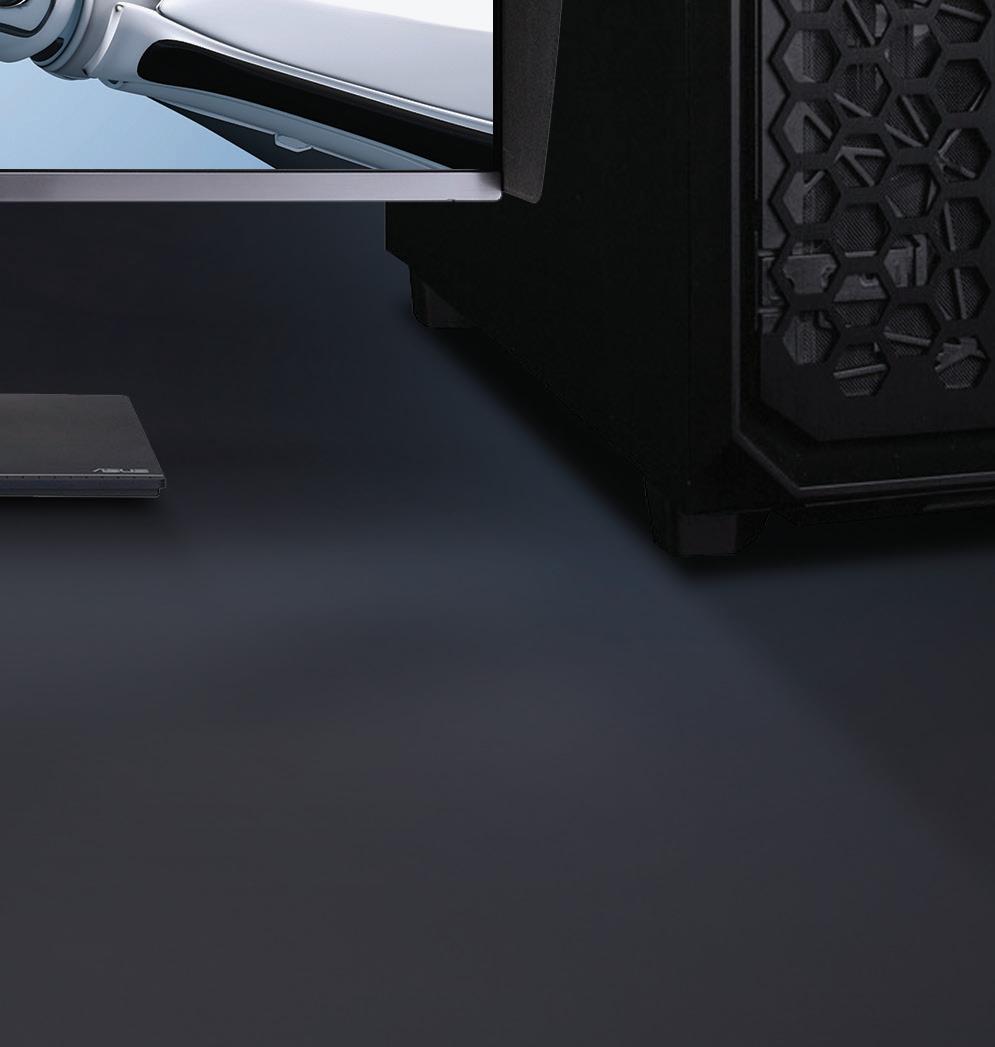
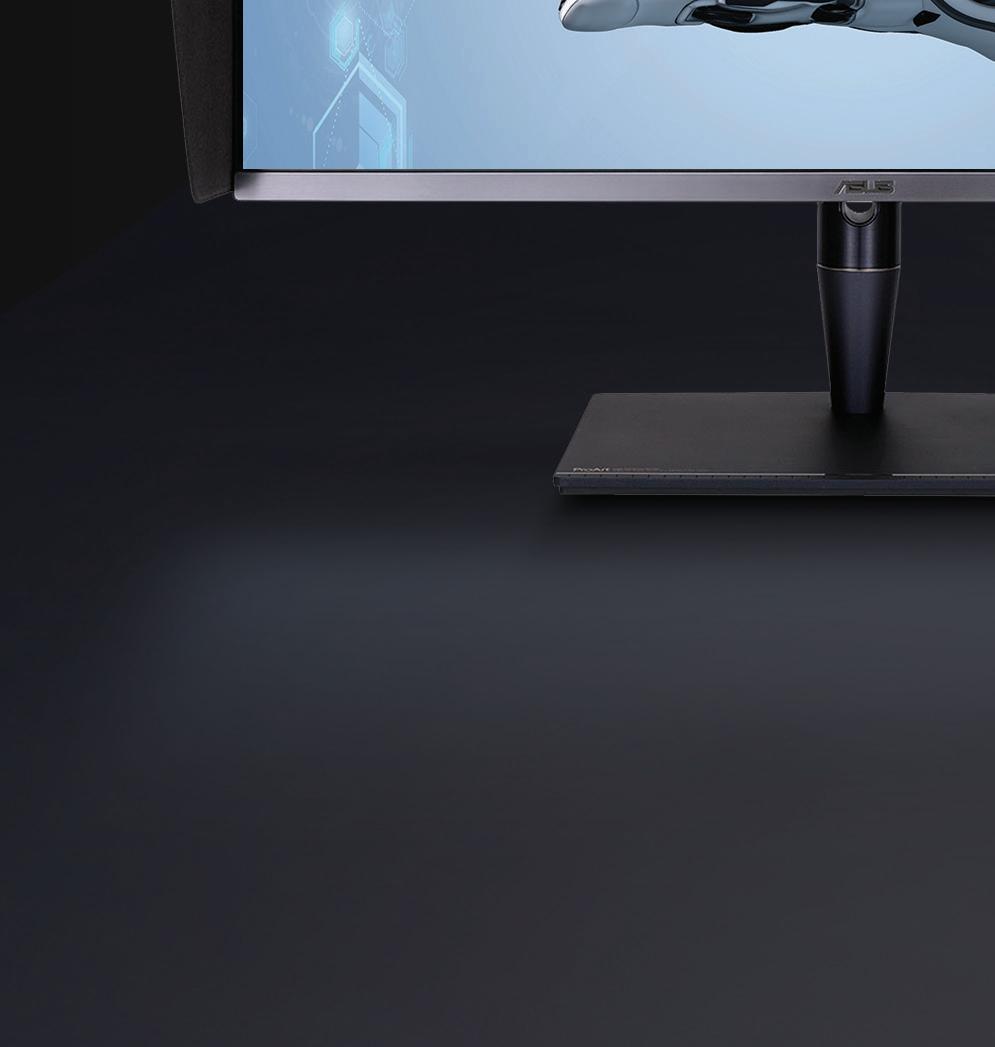


INC VAT
INC VAT

9,499.99 INC VAT







17,999.99 INC VAT

3XS GWP-ME A132C LN130222 • Intel Core i9 13900K • 64GB DDR5 • 20GB NVIDIA RTX A4500 • 2TB M.2 SSD • Microsoft Windows 11 Pro • 3 Year Premium Warranty 3XS GWP-ME A164T LN128456 • AMD Threadripper 5975WX • 128GB DDR4 • 24GB NVIDIA RTX A5000 • 2TB M.2 SSD, 4x1TB M.2 SSDs • Microsoft Windows 11 Pro • 3 Year Premium Warranty
3XS GWP-ME A132C LN130224 • Intel Core i9 13900K • 64GB DDR5 • 24GB NVIDIA RTX A5000 • 2TB M.2 SSD • Microsoft Windows 11 Pro • 3 Year Premium Warranty 3XS GWP-ME A1128T LN128457 • AMD Threadripper 5995WX • 256GB DDR4 • 48GB NVIDIA RTX A6000 • 2TB M.2 SSD, 4x2TB M.2 SSDs • Microsoft Windows 11 Pro • 3 Year Premium Warranty
4,699.99
£
3,799.99
£
£
Intel Arc Pro A40 / A50 GPUs
Intel’s long awaited discrete pro graphics cards have finally arrived, targeting CAD and BIM workflows. But do these entry-level workstation GPUs have enough to upset the apple cart?
Greg Corke explores
www.intel.com/arcprographics
For years, AMD and Nvidia have been the only manufacturers of discrete workstation GPUs - by which we mean graphics cards that plug into a workstation motherboard and are not built into the CPU. But with the launch of the Intel Arc Pro A-series two players have now become three.
Competition is always good, and with Intel’s first-generation pro GPUs — the Intel Arc Pro A40 (6 GB) and Intel Arc Pro A50 (6 GB) — the battle is at the entry-level. And as Intel eases its way into discrete graphics with the first products from its ‘Alchemist’ GPU architecture it makes perfect sense to address this volume market.
A huge part of the entry-level pro graphics market is for workstations that run 3D CAD and Building Information Modelling (BIM) software. Applications including Autodesk Revit, Autodesk Inventor, Graphisoft Archicad and others, are largely CPU limited. This happens when the CPU becomes the bottleneck and

is not able to keep up with the graphics card. As a result, no matter how much graphics processing power you throw at a 3D CAD model, frame rates will only increase by a relatively small amount. In some cases, they will not increase at all.
The Arc Pro cards
The Intel Arc Pro A40 and Intel Arc Pro A50 GPUs are low profile PCIe 4.0 graphics cards, designed for ultracompact and small form factor (SFF) desktop workstations, such as the HP Z2 Mini (see page WS18), HP Z2 SFF, Lenovo ThinkStation P360 Ultra, Dell Precision 3460 SFF, and Dell Precision 3260 Compact. However, fitted with a longer bracket they can also be used in larger desktop towers.
Both cards support the major graphics APIs — OpenGL, DirectX and Vulkan.
Execution Units, Xe-cores, Render Slices, and Ray Tracing Units. Both use a motherboard’s PCIe slot as a power source. Neither need an external power connector. The cards are very well built with a minimalist design.
The only notable differences are form factor, Thermal Design Power (TDP) and peak performance. The Arc Pro A40 is a single slot card with 50W of peak power and 3.50 TFLOPs of peak performance, while the Arc Pro A50 is a dual slot card with 75W of peak power and 4.8 TFLOPs of peak performance. Base clock speeds are the same but because the Arc Pro A50 has a higher TDP, sustained clock speeds can go higher.
They also have hardware accelerated ray tracing and hardware assisted AI (XMX) capabilities built in. This means they will work with applications that use Microsoft DX12 / DXR and Vulkan ray tracing (more on this later).
The specifications of the two cards are very similar. They both feature 6 GB of GDDR6 memory, four mini-DisplayPort outputs and offer the same memory bandwidth, plus the same number of
Intel’s choice of 6 GB of memory appears to be spot on for its intended market. Most true entry-level pro graphics cards, such as the AMD Radeon Pro W6400 and Nvidia T600, come with 4 GB. And while most CAD and BIM models should fit comfortably within that, they might struggle with larger models, especially in CAD applications with more modern graphics APIs such as Solidworks. And when there is not enough memory, performance can drop dramatically.
Equipping its Arc Pro GPUs with 6 GB of memory should also build in some level of future proofing. Indeed, next generation graphics engines that use modern APIs like Vulkan and DX12, and have ray tracing built into the viewport, will certainly need more GPU memory. Here, we are not talking about real time ray tracing, Unreal Engine style, where
WS28 www.develop3d.com December 2022 / January 2023 workstation special report
Autodesk Revit 2021 RFO v3 benchmark 0 10 20 30 40 50 24.29 24.25 14.19 14.08 17.22 17.04 36.38 33.39 18.59 16.33 40.33 25.85 Intel Arc Pro A40 (6 GB) Intel Arc Pro A50 (6 GB) Nvidia T1000 (8 GB) Nvidia RTX A2000 (12 GB) AMD Radeon Pro W6400 (4 GB) AMD Radeon Pro W6600 (8 GB) Intel Arc Pro A40 (6 GB) Intel Arc Pro A50 (6 GB) Nvidia T1000 (8 GB) Nvidia RTX A2000 (12 GB) AMD Radeon Pro W6400 (4 GB) AMD Radeon Pro W6600 (8 GB) Seconds (smaller is better) 1.23 FHD resolution (1,920 x 1,080) 4K resolution (3,840 x 2,160) InvMark for Inventor (by Cadac Group and TFI) 0 1000 2000 3000 4000 5000 6000 4,957 4,980 5,962 5,923 5,589 5,747 3,050 3,249 4,007 4,760 3,635 4,698 Intel Arc Pro A40 (6 GB) Intel Arc Pro A50 (6 GB) Nvidia T1000 (8 GB) Nvidia RTX A2000 (12 GB) AMD Radeon Pro W6400 (4 GB) AMD Radeon Pro W6600 (8 GB) Intel Arc Pro A40 (6 GB) Intel Arc Pro A50 (6 GB) Nvidia T1000 (8 GB) Nvidia RTX A2000 (12 GB) AMD Radeon Pro W6400 (4 GB) AMD Radeon Pro W6600 (8 GB) Benchmark score (bigger is better) 1.23 FHD resolution (1,920 x 1,080) 4K resolution (3,840 x 2,160) ‘‘
’’ Invmark for Inventor
From a pure hardware standpoint, the Arc Pro A40 and A50 compare favourably to the competition. They have 2 GB more memory, which should be to their benefit in GPU-hungry CAD applications and entry-level visualisation
massively powerful GPUs ray trace render multiple frames per second. Rather, when working on a model in the viewport, an architect, engineer, or designer, will be able to switch to ‘ray traced’ quality by clicking an icon. It won’t be instant, and it probably won’t be as photorealistic as a specialist viz application like V-Ray or KeyShot, but it should offer a relatively quick way of getting a level of visualisation in the viewport that simulates the way lighting and materials interact — at a quality that surpasses that of the current OpenGL and DirectX rasterisation graphics engines used in most CAD software.
Both Dassault Systèmes (Project Romulan for Solidworks) and Autodesk (One Graphics Engine) have demonstrated GPU ray tracing in the viewport. Autodesk has included a pre-release version in Inventor 2023 that uses DirectX Raytracing (DXR) though it’s still early days.
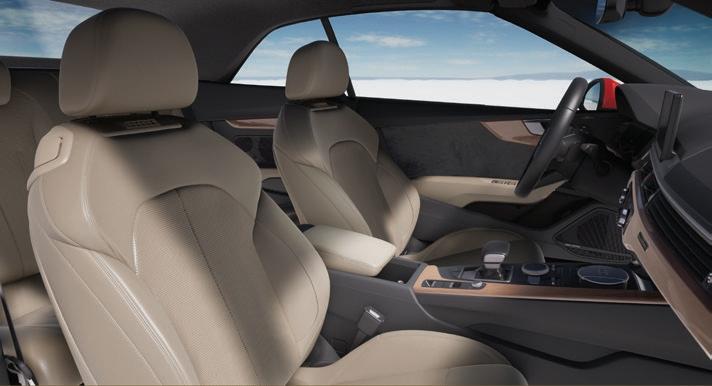
Availability and cost
Exclusive first review
OEMs like Dell, HP and Lenovo usually introduce new GPUs in line with new workstation launches. And with Intel gearing up for its ‘Sapphire Rapids’ workstation CPUs, and continuing the roll out of 13th Gen Intel Core, the two could align soon.
The new Arc Pro GPUs might be out but are not yet widely available. Intel told DEVELOP3D that the focus is currently on rolling out the products in workstations from major OEMs. You won’t see boxed cards in the channel, for now.

4.26 (Audi Model) Intel Arc Pro A40 (6 GB) Intel Arc Pro A50 (6 GB) Nvidia T1000 (8 GB) Nvidia RTX A2000 (12 GB) AMD Radeon Pro W6400 (4 GB) AMD Radeon Pro W6600 (8 GB)
Frames Per Second (FPS) (bigger is better) 1.23 FHD resolution (1,920 x 1,080)
1.23 19.61 23.72 23.87 47.29 11.40 54.49
Seconds (smaller is better) 1.23 FHD resolution (1,920 x 1,080)
Intel Arc Pro A40 (6 GB) Intel Arc Pro A50 (6 GB) Nvidia T1000 (8 GB) Nvidia RTX A2000 (12 GB) AMD Radeon Pro W6400 (4 GB) AMD Radeon Pro W6600 (8 GB)
150 146 412 70 219 93
Autodesk Inventor 2023 (GPU ray tracing) 0 100 200 300 400 500
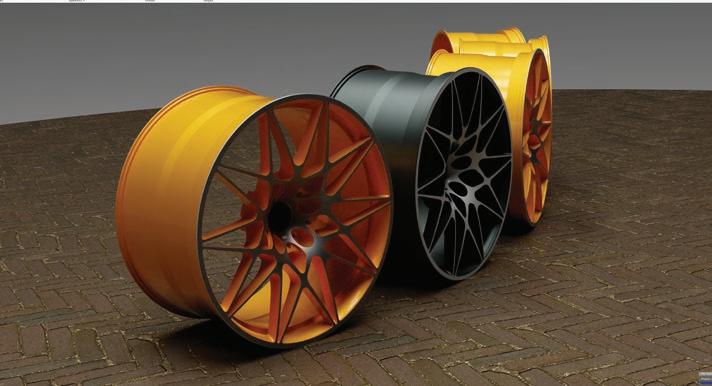
Frames Per Second (FPS) (bigger is better) 1.23 FHD resolution (1,920 x 1,080)
Intel Arc Pro A40 (6 GB) Intel Arc Pro A50 (6 GB) Nvidia T1000 (8 GB) Nvidia RTX A2000 (12 GB) AMD Radeon Pro W6400 (4 GB) AMD Radeon Pro W6600 (8 GB)
13 17 16 29 12 23
Twinmotion 2022 (Lakehouse retreat model) 0 5 10 15 20 25 30

WS29 www.develop3d.com December 2022 / January 2023 workstation special report
Unreal Engine
As the Arc Pro A40 and A50 are not available to buy directly, Intel would not be drawn on pricing. However, Intel sees the Nvidia T600 (4 GB) and Nvidia T1000 (4GB and 8GB) as key competitive products, so the Arc Pro A40 and A50 will need to be priced accordingly. As Intel is new to the world of discrete pro 0 10 20 30 40 50 60
graphics, it will need to shine on value compared to both Nvidia and AMD.
Drivers and certification
New GPUs aren’t just about new silicon; drivers are an essential part of the package, and pro graphics drivers are what set the Intel Arc Pro cards apart from their consumer counterparts — the Intel Arc A380 and the more powerful Intel Arc A750 and A770.
Intel has a dedicated workstation graphics driver team that works closely with its core driver team, as well as the major Independent Software Vendors (ISVs). In other words, the companies that develop the CAD, BIM and other professional 3D software tools.
Both performance and stability are critical in pro graphics, so the workstation driver team works on optimisations and bug fixes for a wide range of pro applications. Intel says some issues are fixed in its pro graphics driver and others in the applications themselves. The end goal is to get the GPUs certified by each ISV — giving them an official ‘stamp of approval’.
So far, the Arc Pro GPUs are certified for a wide range of Autodesk products, including 3ds max (2022, 2023), AutoCAD (2022, 2023), Fusion 360, Inventor (2022, 2023), Maya (2022, 2023). Others include Bentley MicroStation 10.17.00.209, PTC Creo (8, 9), Siemens Solid Edge 2022.
Certification for Vectorworks Architect, Dassault Systèmes Solidworks and Siemens NX should come by the end of next quarter. There are many more apps planned for certification on the 2023 roadmap from Autodesk, Dassault Systèmes, and Nemetschek. The intention is to get both cards certified for at least the two most recent releases of each application.
Of course, Intel has its work cut out here, having to compete with decades of pro driver development from both AMD and Nvidia. It’s a considerable task, especially as many architects, engineers and product designers use multiple applications. But Intel points out that it isn’t starting afresh in terms of ISV relations. Its workstation CPU business has worked very closely with the major ISVs for many years.
Testing Arc Pro
For testing we used the Intel Graphics Driver 31.0.101.3517 for Intel Arc Pro
that was released on 5 December 2022. This is just the bare bones graphics driver without the supporting UI. When installing the driver, it’s supposed to automatically pull-down a Pro version of the Intel Graphics Command Centre from the Microsoft Store. However, at time of testing this wasn’t quite ready. Future versions of the driver will be integrated.
We put the Arc Pro A40 and Arc Pro A50 up against a range of entry-level pro graphics cards from AMD and Nvidia. This includes the AMD Radeon Pro W6400 (4 GB), AMD Radeon Pro W6600 (8 GB), the Nvidia T1000 (8 GB) and Nvidia RTX A2000 (12 GB) (thanks to PNY and Scan for supplying the Nvidia GPUs) . Of those four cards, the Nvidia T1000 is the only one not to support hardware accelerated ray tracing.
Unfortunately, we
our ASRock Z790 Taichi motherboard (where it goes by the name of C.A.M). It is supported by most modern motherboards and CPUs, including AMD and Intel, and one would presume by any OEM workstations that come in the future.
Autodesk Revit

Revit is a key target application for the Intel Arc Pro A40. It is a leading tool for BIM and notorious for being CPU limited, so there is no real benefit to using highend GPUs. It uses DirectX 11.
We loaded up a variety of test models, ranging from 30 MB to 200 MB (including linked models), and with the Arc Pro A40 the viewport felt responsive at both FHD and 4K resolution, in shaded and realistic visual styles.
By default, Revit simplifies models during navigation, suspending certain graphics effects, such as shadows. However, even when this was disabled, we got a smooth experience. With some of the larger models, there was a little bit of lag at 4K, but it was still perfectly usable.
To assess relative performance, we ran the RFO 3.1 benchmark for Revit 2021. Here both the Arc Pro A40 and A50 edged out the AMD Radeon Pro W6400 at 4K, but not at FHD. The Nvidia T1000 and Nvidia RTX A2000 were some way ahead (see page WS33 for all of the benchmark results)
Autodesk Inventor
T600 (4 GB), which is a shame as Intel considers this to be a key competitor for the Arc Pro A40. For the workstation we used the Boxx Apexx S4 with an Intel Core i9-13900K. The core specs can be seen below. See page WS17 for a full review.
Boxx Apexx S4
• Intel Core i9-13900K processor
• 128 GB DDR5-4800 MHz memory
• 1 TB Seagate 530 Firecuda SSD + 2 TB 7,200rpm Hard Disk Drive (HDD)
• ASRock Z790 Taichi motherboard
• Microsoft Windows 11 Pro 64-bit
Intel states the importance of enabling Resizable BAR (Base Address Register) on your motherboard to maximise performance. The technology is designed to allow your CPU and GPU to better communicate with one another over the PCIe bus.
Resizable BAR was already enabled on
Inventor is a popular mechanical CAD (MCAD) tool that uses DX 11. For handson testing we used a 355MB assembly of a Mastenbroek trenching machine with 1,569 parts. Even when ramping up the quality in the viewport, enabling shadows (ground, object and ambient), reflections and a realistic visual style, navigation was silky smooth with a 3Dconnexion Space Mouse, even at 4K resolution.
Testing for performance using the Invmark for Inventor benchmark both the Intel Arc Pro A40 and Arc Pro A50 came in second to the AMD and Nvidia cards.
CAD-integrated GPU ray tracing
As mentioned earlier, Inventor 2023 includes a pre-release version of a GPU ray tracer that uses DirectX Raytracing (DXR) and hence takes advantage of the Intel Arc Pro’s Ray Tracing Units and, potentially in the future, hardware assisted AI-based upscaling (XeSS). It is designed as an alternative to the current CPU-based Autodesk Raytracer (ART).
In terms of performance there was
WS30 www.develop3d.com December 2022 / January 2023 workstation special report
Autodesk Revit is a key target app for the Arc Pro A40
very little between the Arc Pro A40 and A50, both completing ‘low quality’ FHD renders of a relatively simple model in a very similar time. The Intel GPUs were significantly faster than the AMD Radeon Pro W6400 and wiped the floor with the Nvidia T1000 (8 GB). However, this comes as no surprise as Nvidia’s entrylevel GPU does not include dedicated ray tracing hardware, relying instead on its general purpose CUDA cores to crunch the path tracing algorithms. The more powerful and more expensive hardware ray tracing enabled Nvidia RTX A2000 and AMD Radeon Pro W6600 demonstrated a clear lead.

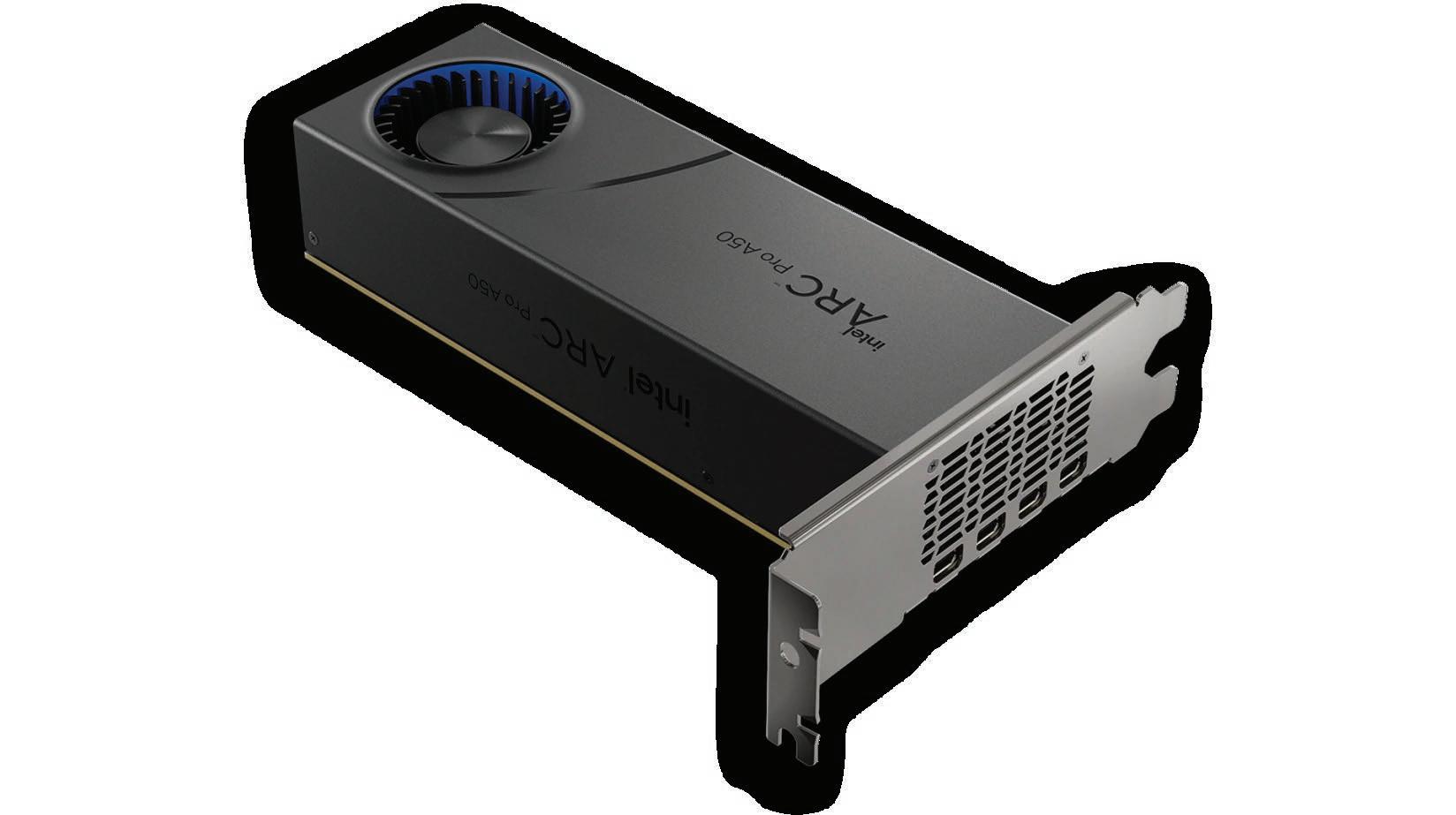
We also tried rendering the considerably more complex Mastenbroek model, but here the question of GPU memory came to the fore. The model alone took 3 GB and enabling GPU ray racing took things well over the 6 GB threshold of the Arc Pro cards. It still rendered, however, and didn’t take that much longer than the simple scene.
Taking things to the next level, the complex factory layout model from TFI’s Invmark benchmark used up over 13 GB of GPU memory (6 GB dedicated and 7 GB shared). It took 2,128 secs to render the FHD resolution ‘low-quality’ scene. In short, while the GPU can be used to ray trace large scenes that far exceed its 6 GB capacity, expect to wait a very long time for the results.
Solidworks
Solidworks is one of the most popular MCAD applications and, as a result, one that we often use to test workstation hardware. For its graphics engine it uses OpenGL 4.5, one of the more modern versions of the mature graphics API, and offloads more of the graphics processing to the graphics card which can increase demands on GPU memory.
Graphics certification for Solidworks is not just important for stability and performance. Once a GPU has that ‘seal of approval’ it will unlock special ‘pro’ features in Solidworks such as RealView for more realistic real time shading.
The Intel Arc Pro A40/A50 are not yet certified for Solidworks and therefore performance in the viewport wasn’t great. According to Intel, its GPUs are now in the final stages of Solidworks certification and this should happen soon. When it does, we’ll follow up with some proper testing.
Design visualisation
The Arc Pro A40 and A50 are very much focused on CAD and BIM workflows, but
one can’t ignore the growing importance of real-time visualisation throughout the design process. This is especially true in architecture, engineering and construction (AEC), where tools such as Chaos Enscape, Lumion and Epic Games Twinmotion (powered by Unreal Engine)
bones 3 million polygon 120 MB Revit model linked via Datasmith, delivered 27 FPS, but performance would naturally decrease as entourage is added. From our testing, the Arc Pro A50 had the edge over the Nvidia T1000. The Arc Pro A40 was notably slower, which is not surprising as, unlike CAD, Twinmotion is GPU limited so can take full advantage of the Arc Pro A50’s superior raw performance.
pretty much forget about working at 4K resolution. The GPUs simply don’t have enough memory or horsepower to deliver workable frame rates. At 4K resolution even some medium sized models will struggle to fit into 6 GB.
In saying that, there’s no reason why the Arc Pro A50 shouldn’t be considered for CAD-centric visualisation on a FHD display. With one quarter of the pixels to render as 4K, the demands on the GPU are much lower.
Twinmotion
Since Epic Games acquired Twinmotion and initially gave it away for free, there have been millions of downloads of this easy to use architectural
Twinmotion can also be used with DirectX 12, which also adds support for path tracing. Flipping into DirectX 12 mode boosted performance a little but it also increased memory usage. We then enabled the path tracer to render out a scene. While this worked, it made the viewport very choppy and hard to navigate. However, if left alone to do its thing, it delivered some nice results, fairly quickly. For this to work in practice, you’d need to frame your scene first and then enable path trace mode.
One word of warning, however. When enabling DirectX 12, we were cautioned that our config may be too limited to support path tracing properly and we ‘might experience instability’. We didn’t experience any problems ourselves but imagine the warning could be related to the risk of running out of GPU memory.
Enscape
Enscape is a fantastic tool for real-time visualisation and one that is hugely popular with architects. It uses the Vulkan API and elements of ray tracing for realtime rendering.
demo scene, which includes a relatively simple 3D model but tonnes of vegetation. On the flip side, a bare
Initially when testing Enscape with some Revit scenes and executables, the software crashed. When we raised this with Intel, we were told the pro driver team was already aware of the issue, having identified some problematic Vulkan code in Enscape. According to Intel, the two companies worked together to resolve the problem. In just two weeks, Enscape updated its software so it was ready for the 3.5 preview release, and Intel then fixed its driver. To see this in action we got the system running stably with Enscape 3.5 preview and the forthcoming Intel Arc Pro 31.0.101.4079 driver (currently in pre-release) but with time constraints that’s about as far as we got. Because we were working with beta software, and the AMD and Nvidia GPUs were all tested with Enscape 3.1, we were unable to make a direct performance comparison.
WS31 www.develop3d.com December 2022 / January 2023 workstation special report
IntelArcProA50
IntelArcProA40
Unreal Engine
Unreal Engine needs little introduction. As well as being the world’s leading game engine, it’s making huge strides in design visualisation, in both AEC and automotive. While we wouldn’t recommend that anyone use the Arc Pro A40 or A50 for creating real time experiences in Unreal Engine, testing the GPUs with the engine does give a good indication of where their performance lies and what a consumer of Unreal Engine real time experiences might expect. At FHD resolution, the Arc Pro A50 was on par with the Nvidia T1000 (8 GB).
Memory
Intel’s choice of 6 GB certainly hits the sweet spot for most CAD workflows. In Revit and Inventor, you’ll be very hard pushed to find a model that won’t fit comfortably within that envelope. With Solidworks, the memory requirements are a bit bigger, but the Arc Pro A40 and A50 should still be able to handle most small to medium-sized assemblies once the optimisations and certification are sorted.
As you move into design visualisation, however, GPU demands can rise considerably, especially when using a real-time viz tool alongside your CAD/BIM tool of choice. In fairness, the Intel Arc Pro A40 and A50 seemed to handle datasets larger than 6 GB quite well when the system was left alone for ray tracing, but, as you would expect, less for real time navigation, where frame rates dropped dramatically and viewports became choppy. Here an 8 GB or 12 GB card would make a big difference.
One observation was that the Arc Pro GPUs appeared to use more memory than GPUs from AMD or Nvidia when loading the same datasets. With the Lakehouse retreat model in Twinmotion, for example, the Arc Pro A50 used around 5.2 GB whereas the Nvidia T1000 used around 1 GB less. So, while the Arc Pro A40 and A50 give you 2 GB more than other entry-

level pro GPUs – the AMD Radeon Pro W6400, Nvidia T400, Nvidia T600 and Nvidia T1000 (4 GB) - the difference in usable memory might not be as big.
Conclusion
It’s great to see a new player in pro graphics, and they don’t come much bigger than Intel. Competition is good for everyone. It helps bring down prices and encourages innovation. And Intel knows this better than most, with AMD continuing to push Intel hard in CPUs.
But entry-level pro graphics is a different beast entirely. It’s not just about who has the fastest GPU and raw performance. It’s about channelling those resources to get the most out of CPUlimited CAD software, ensuring stability and that 3D geometry, materials, lighting and UIs display correctly.
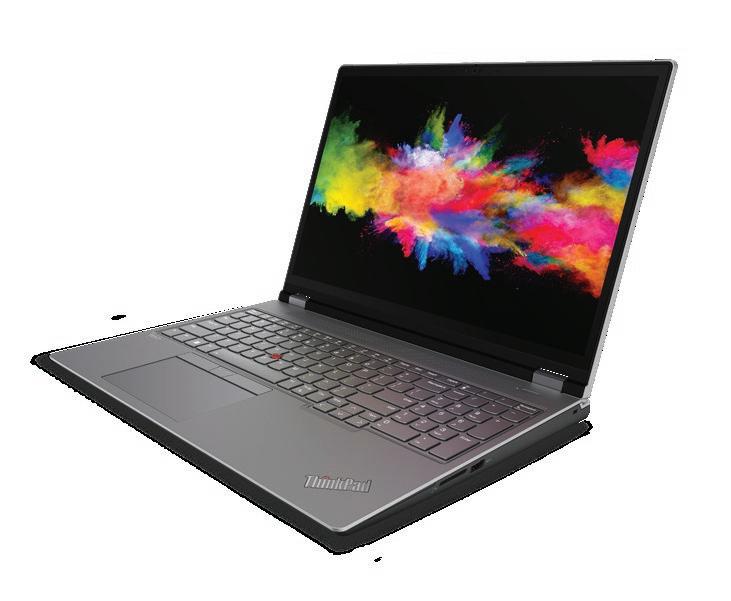
From what we have seen from our
are many complementary tools, covering visualisation, simulation, CAM, reality modelling, Product Lifecycle Management (PLM) and more.
With workflows that rely on a broad set of applications, designers, engineers, and architects want all bases covered. AMD and Nvidia have pro certifications that run into the hundreds, so Intel certainly has its work cut out here.
But there’s little point in judging Intel on that quite yet, as Arc Pro desktop GPUs are not yet really available. This should come next year when workstation OEMs launch new machines based on 13th Gen Intel Core and Sapphire Rapids processors.
Putting application certifications aside for one minute, from a pure hardware standpoint, the Arc Pro A40 / A50 compare favourably to the competition. They have 2 GB more memory than the AMD Radeon Pro W6400, Nvidia T600 and Nvidia T1000 (4GB), which should be to their benefit in more GPU-hungry CAD applications and for entrylevel visualisation. Also, Nvidia’s T-Series GPUs do not include hardware ray tracing.
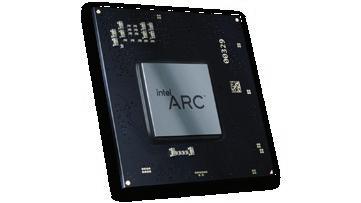
testing, Intel has made a solid, if not remarkable start to its journey — and it will be a journey. Our experiences in Revit and Inventor with the Arc Pro A40 were good and with Twinmotion and Unreal Engine we saw how the Arc Pro A50 can even be used for entry-level visualisation at FHD resolution.
But there will be bumps in the road. Fixing problems is all part of pro graphics, AMD and Nvidia included, and while it’s good to see Intel being very active here — Enscape being a case in point — it will take time to build trust among users.
Certification will certainly help. Arc Pro GPUs are already certified for many of the major 3D CAD/BIM tools, but there are plenty missing. And while certifications for DS Solidworks, DS Catia, Graphisoft Archicad, Siemens NX and SketchUp should come soon, there
But all of this could change, of course. With AMD and Nvidia recently launching new GPU architectures (AMD RDNA 3 and Nvidia Ada Lovelace) we wonder if we might see new entry-level pro GPUs from both vendors at some point in 2023. And while AMD has already included hardware ray tracing with its entry-level pro GPUs, there’s every chance Nvidia will do the same for its next generation.
And this leads us on to the important question of how much the Arc Pro A40 and A50 will cost. Intel will certainly need to be aggressive on price to entice people away from tried and tested Nvidia and AMD solutions. And as IT budgets are squeezed, this could make a big difference. But we’ll have to wait a little while for that, to find out which OEMs have taken on the products and in which workstations.
WS32 December 2022 / January 2023 workstation special report
‘‘
’’
It’s good to see that Intel’s pro driver team is actively fixing problems as they arise –Enscape being a case in point – but it will take time to build trust among users
Intel has a third member of its pro graphics family, the Intel Arc Pro A30M. Designed for mobile workstations, this entrylevel GPU has similar specs to the Arc Pro A40 but has 4 GB of memory and a slightly lower peak power rating of 35-50 watts.
Lenovo is the first major workstation OEM to take on the product, offering it as an option inside the ThinkPad P16 Gen 1. Choosing the Intel Arc Pro A30M (4 GB) instead of the Nvidia RTX A1000 (4GB) will take £183 off the price of the machine.
Intel Arc Pro for mobile workstations


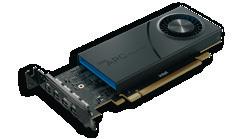
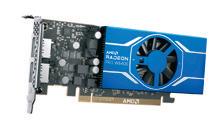

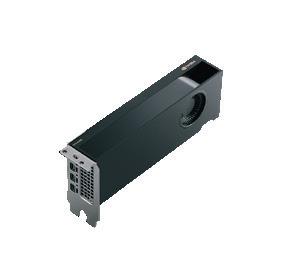

WS33 www.develop3d.com December 2022 / January 2023 workstation special report Test Workstation: Boxx Apexx S4 Intel Core i9-13900K, 128 GB DDR5-4800 MHz memory 1 TB Seagate 530 Firecuda SSD, Microsoft Windows 11 Pro AMD Radeon Pro W6400 AMD Radeon Pro W6600 Intel Arc Pro A40 Intel Arc Pro A50 Nvidia T1000 Nvidia RTX A2000 Nvidia RTX A4000 GPU memory 4 GB GDDR6 8 GB GDDR6 6 GB GDDR6 6 GB GDDR6 4 GB or 8 GB GDDR6 6 GB or 12 GB GDDR6 16 GB GDDR6 Peak Single-Precision Performance 3.54 Teraflops 10.4 Teraflops 3.5 TFLOPs 4.8 TFLOPs 2.5 TFLOPs 8.0 TFLOPS 19.2 TFLOPS Hardware Ray Tracing / AI Yes Yes Yes Yes No Yes Yes Form Factor Half Height, Single Slot Full Height, Single Slot Half Height, Single Slot Half Height, Dual Slot Half Height, Single Slot Half Height, Dual Slot Full Height, Single Slot Display Connectors 2x DisplayPort 1.4 4x DisplayPort 1.4 4 x mini DisplayPort 2.0 ready 4 x mini DisplayPort 2.0 ready 4 x mini DisplayPort 1.4 4 x mini DisplayPort 1.4 4x DisplayPort 1.4a Max Power Consumption 50W 130W 50W 75W 50W 70W 140W Power Connectors Not required 6-pin PCIe Not required Not required Not required Not required 6-pin PCIe Price (Ex VAT) (from scan.co.uk 9/12/22) £192 £483 N/A N/A £290 (4 GB) £355 (8 GB) £429 (6 GB) £550 (12 GB) £950 Benchmarks (score) (bigger is better) Autodesk Inventor Professional 2023 Invmark Graphics - FHD 5,589 5,747 4,957 4,980 5,962 5,923 6,046 Invmark Graphics - 4K 3,635 4,698 3,050 3,249 4,007 4,760 4,797 Solidworks Professional 2022 SPECapc benchmark AA (shaded with edges) - FHD 1.25 1.69 N/A N/A 1.80 3.15 3.97 SPECapc benchmark AA (shaded with edges) - 4K 0.60 1.38 N/A N/A 0.57 1.20 2.52 SPECapc benchmark AA (shaded RealView with edges) - FHD 2.20 2.60 N/A N/A 2.18 3.96 6.96 SPECapc benchmark AA (shaded RealView with edges) - 4K 0.63 1.58 N/A N/A 0.68 1.31 2.68 Benchmarks (frames per second) (FPS) (bigger is better) Solidworks Professional 2022 Computer model (shaded with edges) - FHD 128.77 165.40 N/A N/A 128.30 217.02 380.59 Computer model (shaded with edges) - 4K 78.65 133.74 N/A N/A 55.91 105.09 199.63 Computer model (shaded RealView with edges) - FHD 119.98 152.87 N/A N/A 90.17 159.82 277.92 Computer model (shaded RealView with edges) - 4K 69.27 123.74 N/A N/A 43.22 81.13 155.66 Snow Bike model (shaded with edges) - FHD 19.97 30.76 N/A N/A 22.86 34.57 57.18 Snow Bike model (shaded with edges) - 4K 4.53 29.38 N/A N/A 18.07 28.87 52.50 Snow Bike model (shaded RealView with edges) - FHD 8.90 29.57 N/A N/A 20.74 32.13 53.78 Snow Bike model (shaded RealView with edges) - 4K 4.27 28.10 N/A N/A 15.97 26.42 47.77 Enscape 3.1 Enscape 3.1 architectural sample project - FHD 12.30 28.95 N/A N/A 40.53 74.20 131.47 Enscape 3.1 architectural sample project - 4K 4.85 15.85 N/A N/A 16.00 27.00 -48.67 Unreal Engine 4.26 Audi Car Configurator model - FHD 11.40 54.49 19.61 23.72 23.87 47.29 84.54 Audi Car Configurator model - 4K 1.42 14.06 2.82 3.06 6.01 13.14 25.89 Audi Car Configurator model (Ray Tracing enabled) - FHD N/A 19.52 N/A N/A N/A 26.56 50.23 Audi Car Configurator model (Ray Tracing enabled) - 4K N/A 0.60 N/A N/A N/A 6.99 14.05 Autodesk VRED Professional 2023 Automotive test model (no Anti-Aliasing) - FHD 10.50 21.025 N/A N/A 30.00 71.48 129.20 Automotive test model (no Anti-Aliasing) - 4K Too slow 16.20 N/A N/A 12.48 25.55 52.20 Automotive test model (medium Anti-Aliasing) - FHD 9.55 18.925 N/A N/A 19.175 38.88 70.90 Automotive test model (medium Anti-Aliasing) - 4K Too slow 12.95 N/A N/A 7.85 16.25 32.15 Automotive test model (ultra-high Anti-Aliasing) - FHD 6.90 14.125 N/A N/A 8.90 18.18 36.18 Automotive test model (ultra-high Anti-Aliasing) - 4K Too slow 6.80 N/A N/A 3.00 6.35 12.75 Benchmarks (time - seconds) (smaller is better) Autodesk Revit 2021 RFO 3.1 benchmark - Graphics standard view - FHD 17.22 17.04 24.29 24.25 14.19 14.08 14.11 RFO 3.1 benchmark - Graphics standard view - 4K 40.33 25.85 36.38 33.39 18.59 16.33 15.70 RFO 3.1 benchmark - Graphics sketchy view - FHD 16.09 14.36 21.22 20.55 11.62 11.51 11.74 RFO 3.1 benchmark - Graphics sketchy view - 4K 51.46 33.85 44.33 42.59 20.66 17.69 17.20 Solidworks Visualize 2022 (smaller is better) 1969 Camaro model (iRay) (100 passes + denoise) (4K) N/A N/A N/A N/A N/A 39 23 1969 Camaro model (iRay) (1,000 passes) (4K) N/A N/A N/A N/A N/A 386 218
Nvidia RTX A2000 (12 GB)
With impressive performance and hardware ray tracing built in, this low profile pro graphics card can transform workflows for lovers of small desktop workstations, writes Greg
Corke
Price (Ex VAT): £429 (6 GB) £550 (12 GB) www.nvidia.com
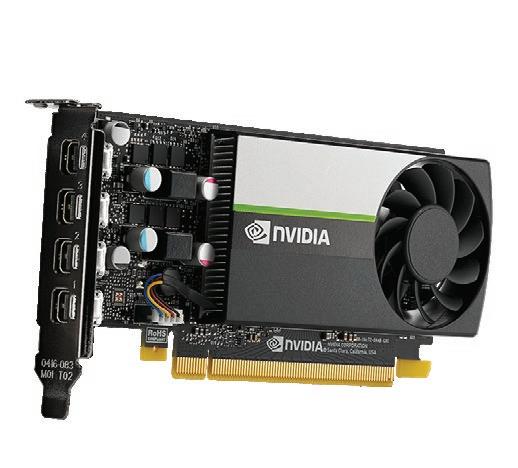
Small Form Factor (SFF) workstations like the Dell Precision 3460 SFF have become extremely popular with designers and engineers because they take up significantly less space than standard desktop towers. However, because of their slender form, they have been limited to ‘low-profile’ GPUs with a half height bracket. Historically, low-profile cards have been very much ‘entry-level’ — perfectly good for 3D CAD, but lacking the performance and features for more demanding workflows such as real-time visualisation and ray trace rendering.
This all changed last year with the introduction of the Nvidia RTX A2000. This powerful low profile GPU not only delivered more performance than ever before, but introduced RTX technology to the entry-level segment. Previously, in order to get professional Nvidia graphics with hardware ray tracing built-in, you needed a 4000 class GPU.
The other major difference between the Nvidia RTX A2000 and previous low-profile offerings is that it’s a double height board, taking up two slots on the motherboard. This is so it can accommodate a beefier radial type fan for better cooling, where hot air is directly exhausted out of the workstation via the grille on the bracket.
Despite the increase in size, the RTX A2000 started appearing in more workstations than ever before — not just SFFs, but ultra-compact workstations as well, such as the HP Z2 Mini G9 (page WS18)
Nvidia T1000 (8 GB)
If budgets are tight and you have little interest in design visualisation, you should consider the Nvidia T1000. This low-profile card is nailed on for 3D CAD. It has four Mini DisplayPorts, a max power of 50W and comes in 4 GB and 8 GB models.
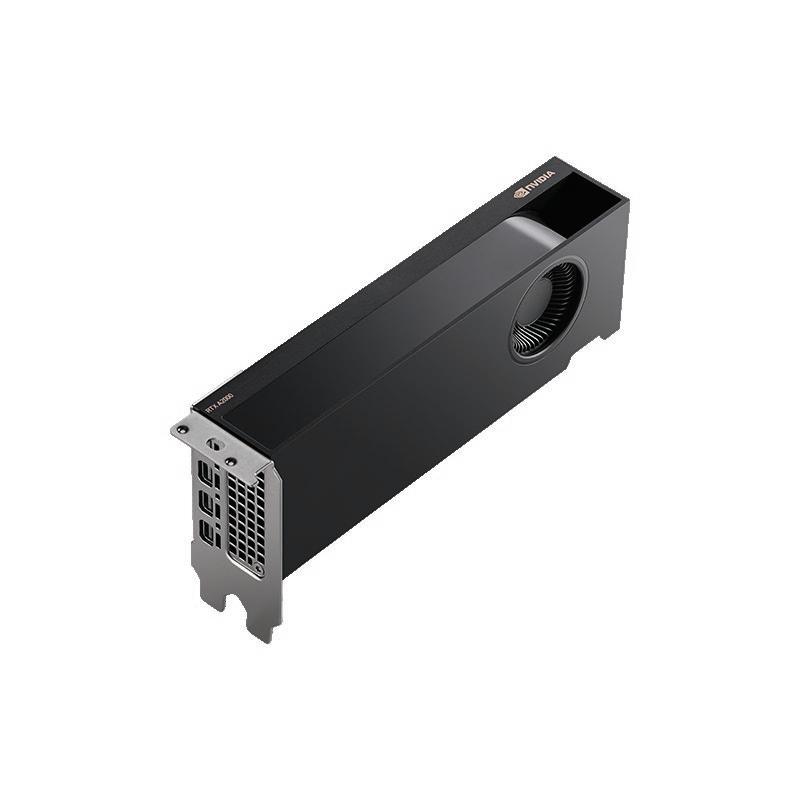
But it’s not just limited to tiny workstations. It can also be fitted to standard towers and, when the GPU is purchased separately, it comes with a half height and full height ATX bracket.
The first Nvidia RTX A2000 featured 6 GB of GDDR6 memory. At time of launch we suggested this might be a little light for its intended workflows. After all, viz datasets quickly swell, especially at 4K resolution. More recently, however, Nvidia released a 12 GB version, which is the
Both the 6 GB and 12 GB models look identical with four Mini DisplayPort outputs and a minimal matt black enclosure. With a max board power of 70W the GPU is designed to operate with PCIe slot power alone.
We tested the RTX A2000 with a full suite of pro applications. In CAD and BIM software — Inventor, Solidworks and Revit — it more than delivered. Compared to the Nvidia RTX A4000, SPECapc Solidworks 2022 benchmark scores may have dropped off at 4K resolution, but we still got a perfectly smooth viewport with 26.4 Frames Per Second (FPS) when testing our large 2,300 part, 49 million triangle snow bike assembly with RealView enabled.
In viz workflows things started to slow down a little. While the card showed great performance at FHD resolution, it
dropped off considerably at 4K, especially in some of our more demanding tests. In VRED Professional 2023 with antialiasing set to ultra-high and in Unreal Engine 4.26 with ray tracing enabled, it never reached double digits.
In GPU rendering, the RTX A4000 was 88% faster in V-Ray, but in Solidworks Visualize it still rendered the Camaro 1969 model at 4K (100 passes with de-noising) in a perfectly acceptable 38.5 seconds.
As an aside, our testing highlighted the importance of selecting the right pro driver. Newer is not always better. In Solidworks Visualize 2022, the card was almost six times slower with the 527.01 driver than it was with the certified 516.94 driver.

The verdict
With its impressive performance and hardware ray tracing, the Nvidia RTX A2000 has completely transformed the SFF and ultra-compact workstation. It’s an excellent choice for CAD users who want to expand into design visualisation, with dedicated tools like KeyShot or GPU ray tracers that are starting to make their way into CAD viewports. But forget about the 6 GB version of the card. 12 GB is a much better fit —now and well into the future.
The Nvidia RTX A2000 is not the GPU for you if you take design viz seriously. The Nvidia RTX A4000 and above are much better suited to more demanding workflows, especially at 4K resolution.
But these are full height boards for full sized towers. If you have your heart set on a pint-sized desktop, then there’s nothing out there right now that comes close.
WS34 www.develop3d.com December 2022 / January 2023 workstation special report
In Solidworks 2022, things slowed down a little at 4K resolution with some of our larger assemblies, but in Inventor and Revit there was hardly any difference to the Nvidia RTX A2000. And at £355 (Ex VAT) for the 8GB model it’s a full £200 cheaper.
The Nvidia RTX A2000 opens up possibilities for entry-level design viz in small workstations using applications like KeyShot (image courtesy of Jet Cooper)




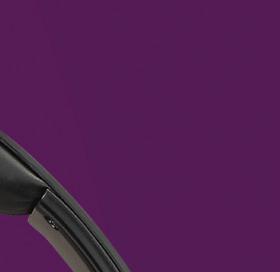
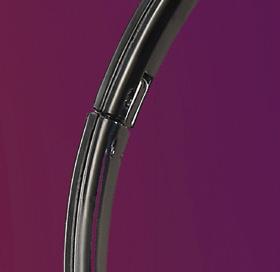




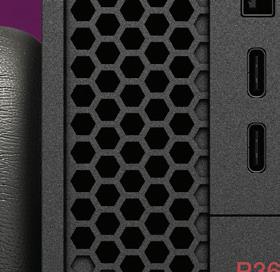
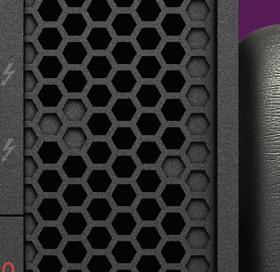
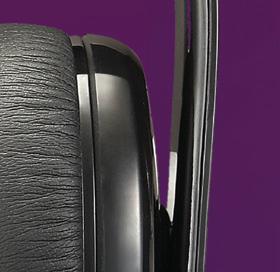

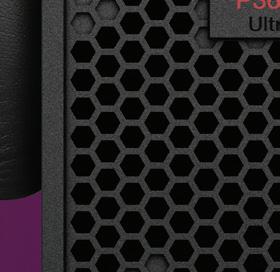

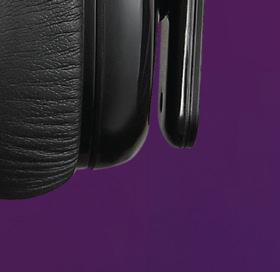

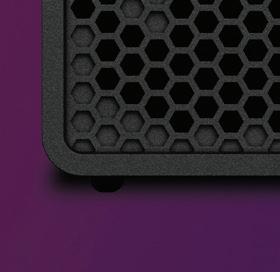
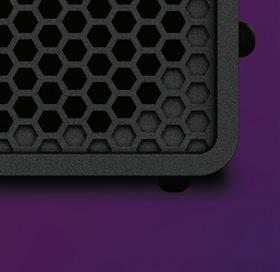

AMD Radeon Pro OpenGL driver
AMD’s new professional graphics driver can deliver a significant 3D performance boost in DS Solidworks and other OpenGL-based applications. This doesn’t just benefit the current AMD Radeon Pro W6000 series, but AMD’s older generation pro graphics cards as well, writes
amd.com/radeonpro
Greg Corke
Graphics drivers are a critical part of your workstation setup. Without them, your Graphics Processing Unit (GPU), or graphics card, wouldn’t know how to communicate with your workstation, your operating system (typically Windows), and the 3D design tools you use every day. A well written driver can deliver the best 3D performance and get the absolute most out of your graphics hardware. A poorly written driver not only slows you down but can cause your software to incorrectly display your 3D model or User Interface (UI), or even make your application or operating system crash.
All graphics card manufacturers –AMD, Intel and Nvidia – write dedicated drivers for their own graphics cards and update and improve these periodically. This helps support new Windows updates, new applications, and enhancements to 3D graphics APIs, namely OpenGL, DirectX and Vulkan. Graphics APIs are used in all 3D CAD applications, making it easier for software developers to utilise graphics hardware without having to write hardware-specific code.
When improving drivers, most graphics card manufacturers quite rightly concentrate on the most modern APIsVulkan and DirectX 12 — but OpenGL is still important. In particular, many of the more mature CAD and viz applications use OpenGL. This includes PTC Creo, DS Solidworks, DS Catia, Autodesk VRED, Autodesk Maya, Siemens NX, Graphisoft Archicad, Trimble SketchUp, McNeel Rhino and many more. It does not cover Autodesk Inventor, Autodesk 3ds max, or Autodesk Revit, which rely on DirectX.
Each quarter, AMD releases a new pro graphics driver for its workstation-class Radeon Pro GPUs. These sometimes add new features, boost performance, and increase stability in pro applications. In September 2022, the company launched AMD Software: Pro Edition 22.Q3, a brand
new driver with a fundamental change in the way it works with OpenGL-based applications.
Triple digit boost
AMD’s re-architected 22.Q3 driver is designed to boost performance in both current generation and older generation Radeon Pro GPUs.
At time of launch, AMD released performance figures that showed gains ranging from 0% to 115% in the SPECviewperf 2020 benchmark.
SPECviewperf is a synthetic benchmark. While it is based on real world 3D applications, it does not run directly inside them. At DEVELOP3D, we prefer to use the actual 3D tools that designers, engineers and architects rely on, and pair them with real world datasets.
For our testing, we used CAD applications (Siemens NX and DS Solidworks), BIM applications (Graphisoft Archicad and Acca Software Edificius), and visualisation software Autodesk VRED. We compared the OpenGL-optimised 22.Q3 driver with the older 22.Q2 driver using a range of AMD GPUs including the current generation Radeon Pro W6400 (4 GB), W6600 (8 GB) and W6800 (16 GB), and older Radeon Pro W5500 (8 GB) and Radeon Pro WX5100 (8 GB).
WS36 www.develop3d.com December 2022 / January 2023 workstation special report
Solidworks 2022 SP5 (OpenGL) Snow Bike model (Shaded with edges) 0 10 20 30 40 50 36.76 20.53 31.65 42.59 37.02 53.19 10.61 11.70 11.56 19.61 Radeon Pro W6400 (4 GB) Radeon Pro W6600 (8 GB) Radeon Pro W6800 (32 GB) Radeon Pro WX5100 (8 GB) Radeon Pro W5500 (8 GB) Frames Per Second (FPS) (bigger is better) 1.23 0 50 100 150 200 250 AMD Q2.22 driver AMD Q3.22 driver 0 50 100 150 200 250 Solidworks 2022 SP5 (OpenGL) Snow Bike model (Shaded with edges + RealView) 0 10 20 30 40 15.48 13.89 30.98 41.03 34.42 45.00 9.42 10.68 11.71 19.19 Radeon Pro W6400 (4 GB) Radeon Pro W6600 (8 GB) Radeon Pro W6800 (32 GB) Radeon Pro WX5100 (8 GB) Radeon Pro W5500 (8 GB) Frames Per Second (FPS) (bigger is better) 1.23 0 50 100 150 200 250 AMD Q2.22 driver AMD Q3.22 driver 0 50 100 150 200 250 Solidworks 2022 SP5 (OpenGL) Maunakea telescope model (Shaded with edges) 0 5 10 15 20 25 30 35 9.30 3.39 19.85 29.06 19.92 36.07 N/A N/A Radeon Pro W6400 (4 GB) Radeon Pro W6600 (8 GB) Radeon Pro W6800 (32 GB) Radeon Pro WX5100 (8 GB) Radeon Pro W5500 (8 GB) Frames Per Second (FPS) (bigger is better) 1.23 0 50 100 150 200 250 AMD Q2.22 driver AMD Q3.22 driver 0 50 100 150 200 250 Solidworks 2022 SP5 (OpenGL) Maunakea telescope model (Shaded with edges + RealView) 0 5 10 15 20 25 30 7.11 3.30 19.84 28.97 19.69 32.79 N/A N/A Radeon Pro W6400 (4 GB) Radeon Pro W6600 (8 GB) Radeon Pro W6800 (32 GB) Radeon Pro WX5100 (8 GB) Radeon Pro W5500 (8 GB) Frames Per Second (FPS) (bigger is better) 1.23 0 50 100 150 200 250 AMD Q2.22 driver AMD Q3.22 driver 0 50 100 150 200 250 Solidworks 2022 SP5 (OpenGL) Black Owl PC model (Shaded with edges) 0 50 100 150 200 250 300 350 400 89.60 162.97 97.20 290.17 220.75 354.30 64.06 63.86 56.68 150.54 Radeon Pro W6400 (4 GB) Radeon Pro W6600 (8 GB) Radeon Pro W6800 (32 GB) Radeon Pro WX5100 (8 GB) Radeon Pro W5500 (8 GB) FHD (1,920 x 1,080 resolution) Frames Per Second (FPS) (bigger is better) 1.23 0 50 100 150 200 250 AMD Q2.22 driver AMD Q3.22 driver 0 50 100 150 200 250 Solidworks 2022 SP5 (OpenGL) Black Owl PC model (Shaded with edges + RealView) 0 50 100 150 200 250 84.10 109.44 94.33 195.66 198.86 242.45 56.13 42.29 52.81 99.97 Radeon Pro W6400 (4 GB) Radeon Pro W6600 (8 GB) Radeon Pro W6800 (32 GB) Radeon Pro WX5100 (8 GB) Radeon Pro W5500 (8 GB) Frames Per Second (FPS) (bigger is better) 1.23 0 50 100 150 200 250 AMD Q2.22 driver AMD Q3.22 driver 0 50 100 150 200 250 FHD FHD (1,920 x 1,080 resolution) FHD FHD (1,920 x 1,080 resolution) FHD FHD (1,920 x 1,080 resolution) FHD FHD (1,920 x 1,080 resolution) FHD FHD (1,920 x 1,080 resolution) FHD
Our test machine featured an AMD Ryzen 7 5800X CPU, 32 GB of DDR4 memory and Windows 10 Professional. The most significant boost in performance was seen in Solidworks 2022. Frame rates, the number of Frames Per Second (FPS) that can be rendered when moving 3D models on screen, was shown to increase by as much as three times over the previous 22.Q2 driver.
Similar results could be seen in Autodesk VRED Professional 2023. However, in Archicad, Edificius and Siemens NX, we saw no discernible performance increase. In fact, while we didn’t do extensive testing, it appeared that performance in NX may even go down a little.
Solidworks 2022
We tested with a variety of different Solidworks models, including a small computer assembly with 295 parts and 3.6 million triangles, a large snow bike assembly with 2,300 parts and 49 million triangles and the colossal Maunakea Spectroscopic Explorer telescope assembly with 8,149 parts and 58.9 million triangles.
We used variety of viewing modesshaded with edges, which is typical for most CAD workflows, and shaded with edges with RealView, which brings added realism to the viewport. To see the impact
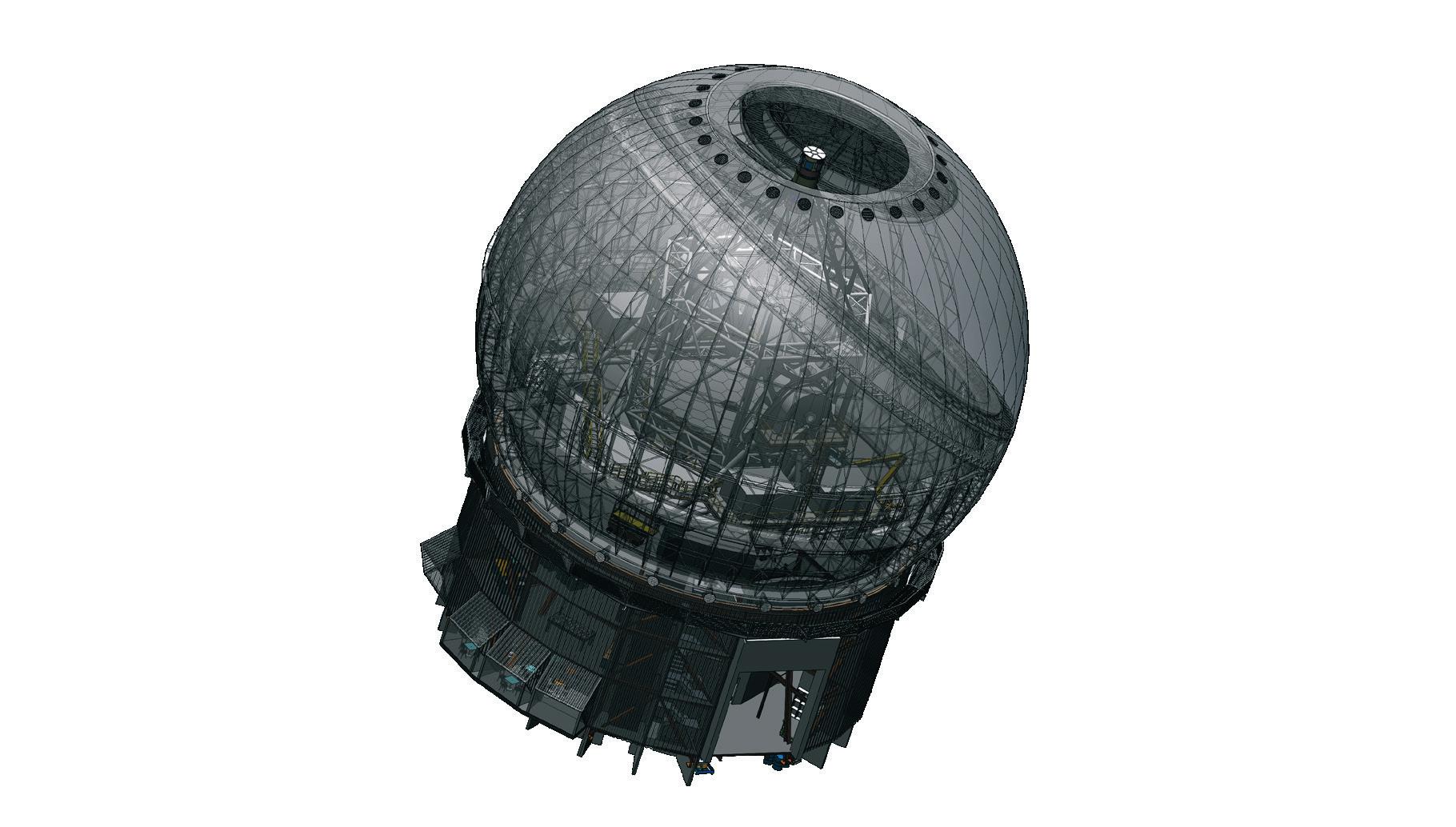
of resolution, we also tested at FHD (1,920 x 1,080) and 4K (3,840 x 2,160). All of the results can be seen below.
During testing we noticed that with the exact same Solidworks models the 22.Q3 driver used more GPU memory
With the snow bike and Maunakea Spectroscopic Explorer telescope, the GPU memory requirements are much higher, going above 4 GB and encroaching on 8 GB. As you can see from the charts, the Radeon Pro W6400 with the new
see from the results, performance dramatically improved with the new driver, doubling the FPS, even when RealView was enabled.
According to AMD, Solidworks is also architected to get the most out of pro graphics cards with 8 GB of memory and above. This is to
WS37 www.develop3d.com December 2022 / January 2023 workstation special report
Solidworks 2022 SP5 (OpenGL) Black Owl PC model (Shaded with edges) 0 50 100 150 200 250 40.32 86.49 63.88 165.92 133.47 243.73 35.93 24.74 40.85 95.29 Radeon Pro W6400 (4 GB) Radeon Pro W6600 (8 GB) Radeon Pro W6800 (32 GB) Radeon Pro WX5100 (8 GB) Radeon Pro W5500 (8 GB) 4K (3,840 x 2,160 resolution) Frames Per Second (FPS) (bigger is better) 1.23 0 50 100 150 200 250 AMD Q2.22 driver AMD Q3.22 driver 0 50 100 150 200 250 Solidworks 2022 SP5 (OpenGL) Black Owl PC model (Shaded with edges + RealView) 0 50 100 150 200 35.98 62.13 57.31 120.60 118.00 174.56 31.08 17.73 37.46 66.52 Radeon Pro W6400 (4 GB) Radeon Pro W6600 (8 GB) Radeon Pro W6800 (32 GB) Radeon Pro WX5100 (8 GB) Radeon Pro W5500 (8 GB) 4K (3,840 x 2,160 resolution) Frames Per Second (FPS) (bigger is better) 1.23 0 50 100 150 200 250 AMD Q2.22 driver AMD Q3.22 driver 0 50 100 150 200 250 4K 4K Solidworks 2022 SP5 (OpenGL) Snow Bike model (Shaded with edges) 0 10 20 30 40 8.89 5.93 25.26 38.35 32.90 49.39 9.32 9.29 10.15 18.41 Radeon Pro W6400 (4 GB) Radeon Pro W6600 (8 GB) Radeon Pro W6800 (32 GB) Radeon Pro WX5100 (8 GB) Radeon Pro W5500 (8 GB) 4K (3,840 x 2,160 resolution) Frames Per Second (FPS) (bigger is better) 1.23 0 50 100 150 200 250 AMD Q2.22 driver AMD Q3.22 driver 0 50 100 150 200 250 Solidworks 2022 SP5 (OpenGL) Snow Bike model (Shaded with edges + RealView) 0 10 20 30 40 3.72 6.85 24.42 36.56 30.24 42.56 8.52 8.64 10.28 17.95 Radeon Pro W6400 (4 GB) Radeon Pro W6600 (8 GB) Radeon Pro W6800 (32 GB) Radeon Pro WX5100 (8 GB) Radeon Pro W5500 (8 GB) 4K (3,840 x 2,160 resolution) Frames Per Second (FPS) (bigger is better) 1.23 4K 4K Solidworks 2022 SP5 (OpenGL) Maunakea telescope model (Shaded with edges) 0 5 10 15 20 25 30 2.96 2.83 16.77 20.21 17.82 31.10 N/A N/A Radeon Pro W6400 (4 GB) Radeon Pro W6600 (8 GB) Radeon Pro W6800 (32 GB) Radeon Pro WX5100 (8 GB) Radeon Pro W5500 (8 GB) 4K (3,840 x 2,160 resolution) Frames Per Second (FPS) (bigger is better) 1.23 0 50 100 150 200 250 AMD Q2.22 driver AMD Q3.22 driver 0 50 100 150 200 250 Solidworks 2022 SP5 (OpenGL) Maunakea telescope model (Shaded with edges + RealView) 0 5 10 15 20 25 3.19 2.66 14.39 23.24 17.33 28.50 N/A N/A Radeon Pro W6400 (4 GB) Radeon Pro W6600 (8 GB) Radeon Pro W6800 (32 GB) Radeon Pro WX5100 (8 GB) Radeon Pro W5500 (8 GB) 4K (3,840 x 2,160 resolution) Frames Per Second (FPS) (bigger is better) 1.23 4K 4K 0 50 100 150 200 250 AMD Q2.22 driver AMD Q3.22 driver 0 50 100 150 200 250 0 50 100 150 200 250 AMD Q2.22 driver AMD Q3.22 driver 0 50 100 150 200 250
Maunakea Spectroscopic Explorer telescope Solidworks model
ensure the GPU has enough memory to fully enable shaders for processes including GPU-accelerated transparency.
The other important thing to note here is how the new driver can give a new lease of life to older generation cards. With the 8 GB Radeon Pro W5500, for example, which is nearly three years old, you get a significant uplift of between 60% and 90%. This is in part because it shares a similar architecture to the Radeon Pro W6000 Series (Navi 1.0 vs Navi 2.0).
With the older Radeon Pro WX 5100 (8 GB), which is six years old and based on AMD’s older RDNA architecture, the benefits of the new driver were marginal.
Autodesk VRED VRED is typically used in automotive design visualisation. The new 22.Q3 driver showed significant benefits when anti-aliasing, a process that smoothes the jagged edges on models, is enabled in the viewport. Anti-aliasing is critical for automotive styling, so most users will have this enabled. Interestingly, when anti-aliasing was turned off or set to medium at FHD resolution, performance on all GPUs went down.
The new driver delivers the biggest benefits when the greatest demands are placed upon the GPU, which is at 4k resolution and when anti-aliasing is set to ultra-high. AMD has said it will continue
to work on AA optimisations.
Our automotive test model fits just within the 4 GB memory limit of the Radeon Pro W6400. However, other visualisation datasets are likely to have bigger memory footprints and, as you can see from the frame rates, the CADfocused Radeon Pro W6400 is massively underpowered for an application of this type. Here, the Radeon Pro W6800 comes into its own, delivering 14.35 FPS at 4k resolution with AA set to ultrahigh. In this scenario, the 22.Q3 driver is nearly three times faster than the 22.Q2
assemblies in Solidworks, the chances are you’ve already been getting enough 3D performance from the entry-level Radeon Pro W6400 and previous 22.Q2 driver.
But, if you work with larger models, and your viewport experience is not as smooth as you would like it to be, then the seemingly increased graphics memory demands of the new driver may put the potential performance benefits out of reach for entry level graphics cards with only 4 GB of memory.
Perhaps the biggest beneficiaries will be users of 8 GB cards like the Radeon Pro W6600 — or Radeon Pro W5500, where it has the potential to give an ageing GPU a new lease of life.
driver, giving users a massive boost in interactivity in the viewport.
Conclusion
Normally when graphics card manufacturers deliver driver optimisations you expect single digit improvements, but some of the frame rate increases with the new OpenGL driver are simply massive. Solidworks users in particular should be paying attention.
But things aren’t so clear cut. The question of GPU memory is really important. If you deal with small to medium
Of course, the 22.Q3 driver won’t benefit all OpenGL applications out of the box. AMD has done a lot of testing / optimisation with Solidworks, and as one of the biggest MCAD applications this comes as no surprise.
It could be that with future driver updates, AMD focuses on improving performance in other CAD applications. However, because many of these tools are very CPU limited (i.e. bottlenecked by the frequency of the CPU) there might not be much it can do.
Since testing was done for this article AMD has released a new 22.Q4 driver, which builds on the improvements made in the 22.Q3 driver.
WS38 www.develop3d.com December 2022 / January 2023 workstation special report
‘‘
Autodesk
Professional 2023 (OpenGL) Automotive model (Anti Aliasing off) 0 10 20 30 40 50 11.80 7.60 23.80 15.47 48.70 34.45 Radeon Pro W6400 (4 GB) Radeon Pro W6600 (8 GB) Radeon Pro W6800 (32 GB) Frames Per Second (FPS) (bigger is better) 1.23 0 50 100 150 200 250 AMD Q2.22 driver AMD Q3.22 driver 0 50 100 150 200 250 4K (3,840 x 2,160 resolution) 4K Autodesk VRED Professional 2023 (OpenGL) Automotive model (Anti Aliasing Medium) 0 5 10 15 20 25 30 3.70 6.30 7.13 12.80 15.70 26.70 Radeon Pro W6400 (4 GB) Radeon Pro W6600 (8 GB) Radeon Pro W6800 (32 GB) Frames Per Second (FPS) (bigger is better) 1.23 0 50 100 150 200 250 AMD Q2.22 driver AMD Q3.22 driver 0 50 100 150 200 250 4K (3,840 x 2,160 resolution) 4K Autodesk VRED Professional 2023 (OpenGL) Automotive model (Anti Aliasing Ultra-high) 0 3 6 9 12 15 0.80 3.20 2.30 6.55 5.30 14.35 Radeon Pro W6400 (4 GB) Radeon Pro W6600 (8 GB) Radeon Pro W6800 (32 GB) Frames Per Second (FPS) (bigger is better) 1.23 0 50 100 150 200 250 AMD Q2.22 driver AMD Q3.22 driver 0 50 100 150 200 250 4K (3,840 x 2,160 resolution) 4K Autodesk VRED Professional 2023 (OpenGL) Automotive model (Anti Aliasing off) 0 20 40 60 80 100 120 32.10 11.20 62.50 22.30 115.00 45.20 Radeon Pro W6400 (4 GB) Radeon Pro W6600 (8 GB) Radeon Pro W6800 (32 GB) Frames Per Second (FPS) (bigger is better) 1.23 0 50 100 150 200 250 AMD Q2.22 driver AMD Q3.22 driver 0 50 100 150 200 250 FHD (1,920 x 1,080 resolution) FHD Autodesk VRED Professional 2023 (OpenGL) Automotive model (Anti Aliasing Medium) 0 10 20 30 40 50 12.25 9.95 23.10 19.75 44.20 39.45 Radeon Pro W6400 (4 GB) Radeon Pro W6600 (8 GB) Radeon Pro W6800 (32 GB) Frames Per Second (FPS) (bigger is better) 1.23 0 50 100 150 200 250 AMD Q2.22 driver AMD Q3.22 driver 0 50 100 150 200 250 FHD (1,920 x 1,080 resolution) FHD Autodesk VRED Professional 2023 (OpenGL) Automotive model (Anti Aliasing Ultra-high) 0 5 10 15 20 25 30 4.25 7.00 8.45 14.30 18.00 28.95 Radeon Pro W6400 (4 GB) Radeon Pro W6600 (8 GB) Radeon Pro W6800 (32 GB) Frames Per Second (FPS) (bigger is better) 1.23 0 50 100 150 200 250 AMD Q2.22 driver AMD Q3.22 driver 0 50 100 150 200 250 FHD (1,920 x 1,080 resolution) FHD
Normally when graphics card manufacturers deliver driver optimisations you expect single digit improvements, but some of the frame rate increases with the new OpenGL driver are simply massive ’’
VRED
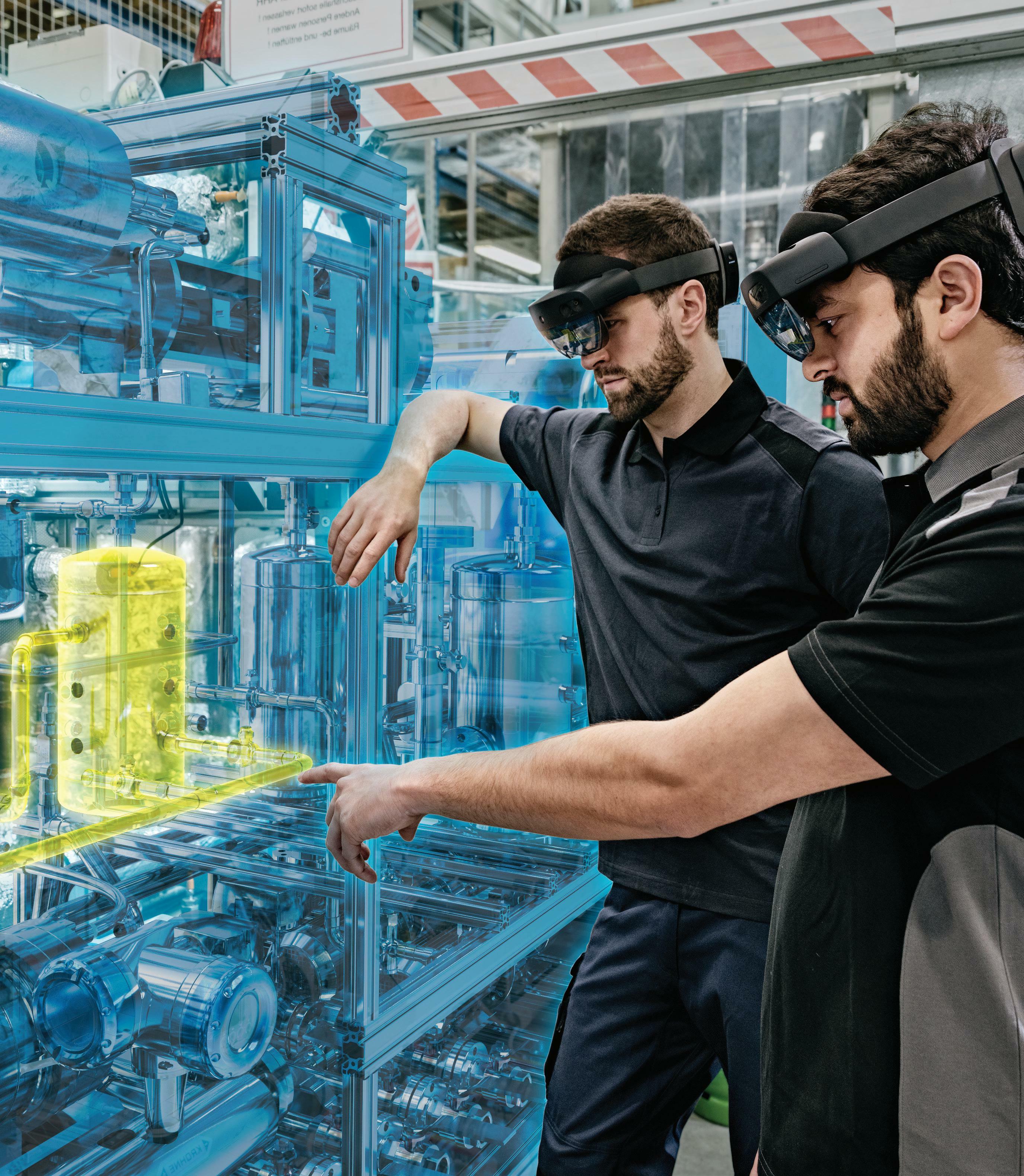

Import your CAD data Work on your designs in AR Collaborate remotely and in real-time Improve Your Engineering Workflows with Augmented Reality www.holo-light.com
Changes to how we live and purchase products create new opportunities and challenges for designers. Preparing for Christmas, Stephen Holmes considers these shifts and wonders how they will impact our gift-giving habits


The season of comfort and joy is upon us. At the time of writing, people everywhere are already cursing Black Friday and swearing that the Christmas adverts started even earlier this year.
According to most of these commercials, Christmas is made up of visiting family and friends, squeezing around a table to eat, filling up every available space in the living room with presents, and cramming bodies and luggage into public or private transport.
Scalability and flexibility are things we all struggle with, and not just when it comes to divvying up a turkey once a year, or bemoaning the lack of luggage space on a creaking train en route to the in-laws.
Speaking with Casio for this issue of DEVELOP3D, these were major themes in the conversation, given the company’s commitment to redesigning the piano to fit modern living spaces.
Japan, as a nation, has a history of cleverly scaling down designs to fit compact urban living environments. So the thought that Casio’s designers headed to Europe to research this latest product grabbed my attention. London is now a city battling for space, with every inch of real estate being fought over, built on and monetised. Apartment blocks have sprung up everywhere, and continue to do so, impacting how millions of people live.
The design created by Casio is not only shaped to fit into a tight space and blend into the existing surroundings, but also to be pulled into the centre of a room, so that others can gather around it. Christmas carols, anyone?
EXPAND AND ACCOMMODATE
This led me to think about other products and how we might benefit from more flexible design thinking.
For some products, the flexibility to extend, expand and accommodate is already possible, from antique dining tables that can add an extra leaf to seat more people, to futuristic Samsung televisions that roll away into a housing.
Another option is scalability. January is prime marketing time for the selling of new sofas, adverts for which roam relentlessly across our TV and computer screens like bison across the plains. Increasingly, new companies are approaching this product category from a compartmentalised, selfassembled angle, allowing the customer to add more seats or arrange them in a configuration that better suits the space. And then there is the growing trend of ‘product as a service’. Now that we’re all comfortable with Netflix and Spotify, we are increasingly targeted with contract leases and lifecycles for physical products, too — not just tech and cars, but clothing and jewellery are also available for hire. Renting rather than owning is no longer seen as a signifier of low income, but a more sustainable shortcut to experiencing a product. It’s a model pioneered by software vendors with cloud-based products, a trend that increasingly applies to CAD and that more designers will need to consider in 2023 and beyond.
CHANGES AHEAD
As ever, the changing living spaces and purchasing habits of consumers raise challenges for product designers. Perhaps the most interesting aspect of this is the
potential for products to have a set rental lifespan, or the ability to accommodate future configurations and updates.
With flexibility in mind, do internal QA requirements and external legislation need to change? Could products built with an end-of-life in mind be better designed for recycling or repurposing?
Another question is how much of this will consumers accept or demand. At what point does not owning a product outright begin to impact purchasing decisions, or will added flexibility increase a product’s appeal?
(For more on this point, google the Ship of Theseus theory, a thought experiment that asks whether an object that has had all of its original components replaced remains the same object? It’s also known to some as the ‘Trigger’s Broom’ paradox, thanks to an episode of UK comedy ‘Only Fools and Horses’, where street sweeper Trigger boasted he’d had the same broom for 20 years, but that the broom had had 17 new heads and 14 new handles in that time.)
Either way, I hope you get what you want this year, be it scalable, flexible — or at the very least, edible.
GET IN TOUCH: With his home still not fully renovated, Christmas for Stephen this year is likely to be more ‘Home Alone 2’ than ‘It’s A Wonderful Life’ — but hopefully, without the cameo appearance by Donald Trump. On Twitter, he’s @swearstoomuch
44 DECEMBER 2022 / JANUARY 2023 DEVELOP3D.COM
LAST WORD
How would you like your Christmas gift this year — flexible, scalable, or at the very least, edible?
Renting rather than owning is no longer seen as a signifier of low income, but a more sustainable shortcut to experiencing a product

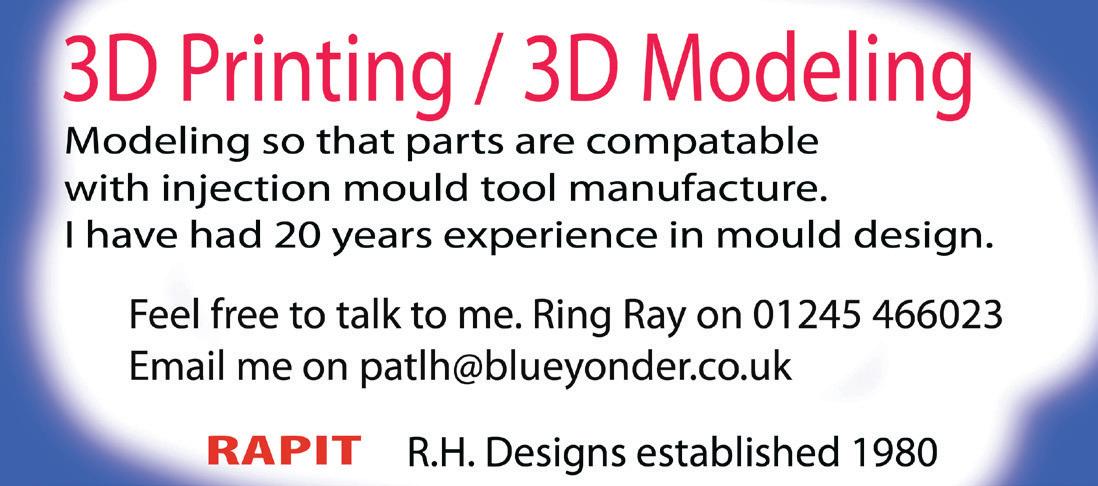

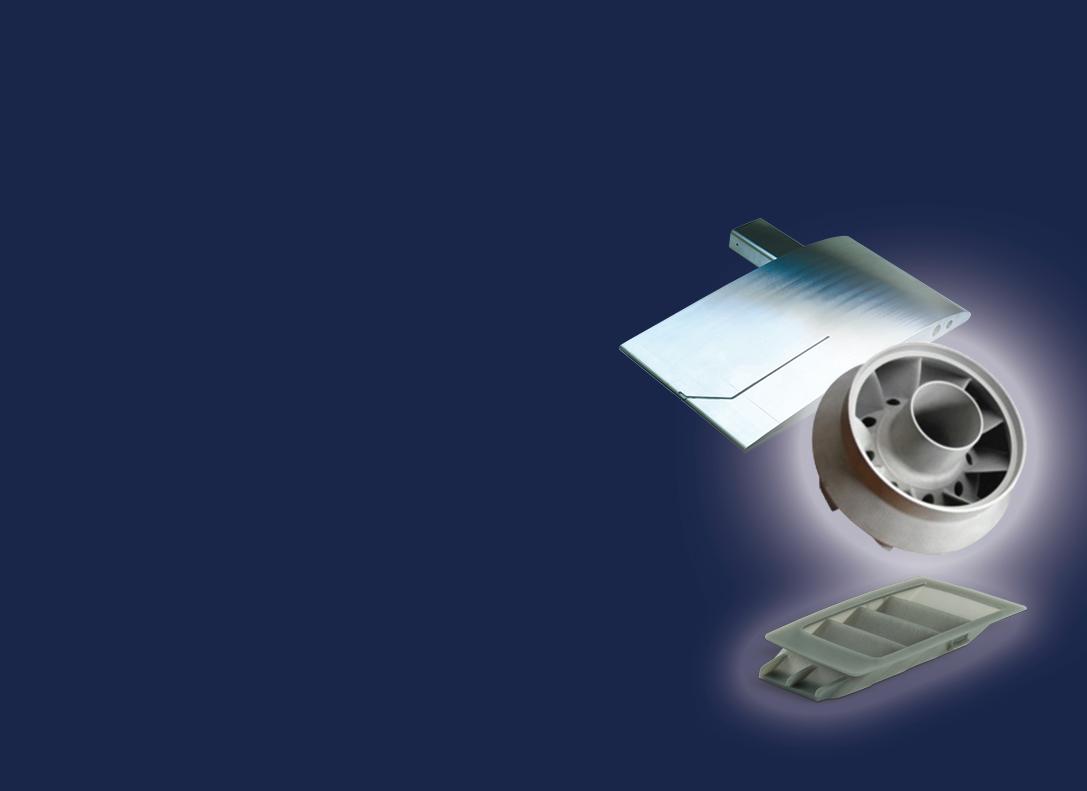
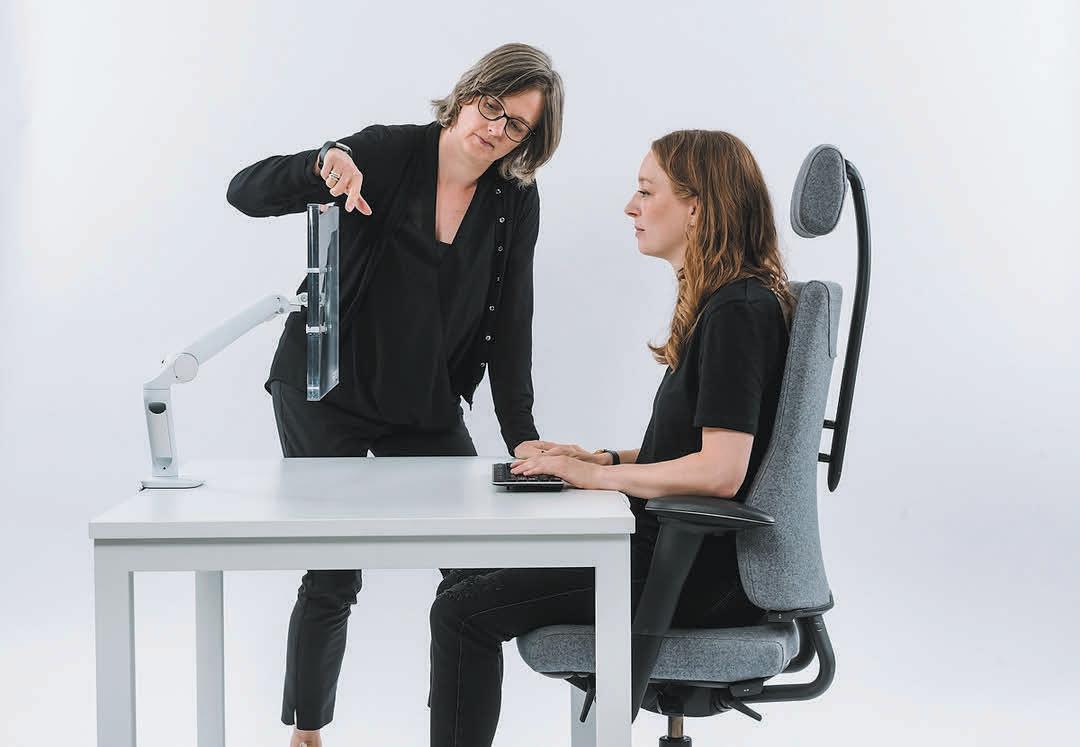


DEVELOP3D.COM DECEMBER 2022 / JANUARY 2023 45 DEVELOP3DSERVICES TO ADVERTISE YOUR SERVICES HERE CONTACT STEVE KING STEVE@X3DMEDIA.COM | +44 (0) 20 3355 7314 | +44 (0)7850 507362 Don't let your workstation cause you discomfort ergonomic chairs sit stand desks workplace assessments ergonomic accessories Bad back? We can help with: 0330 332 0880 www.posturepeople.co.uk Watch on-demand develop3dlive.com 2022 Register FREE now
“Its

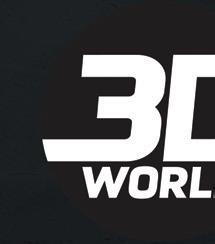









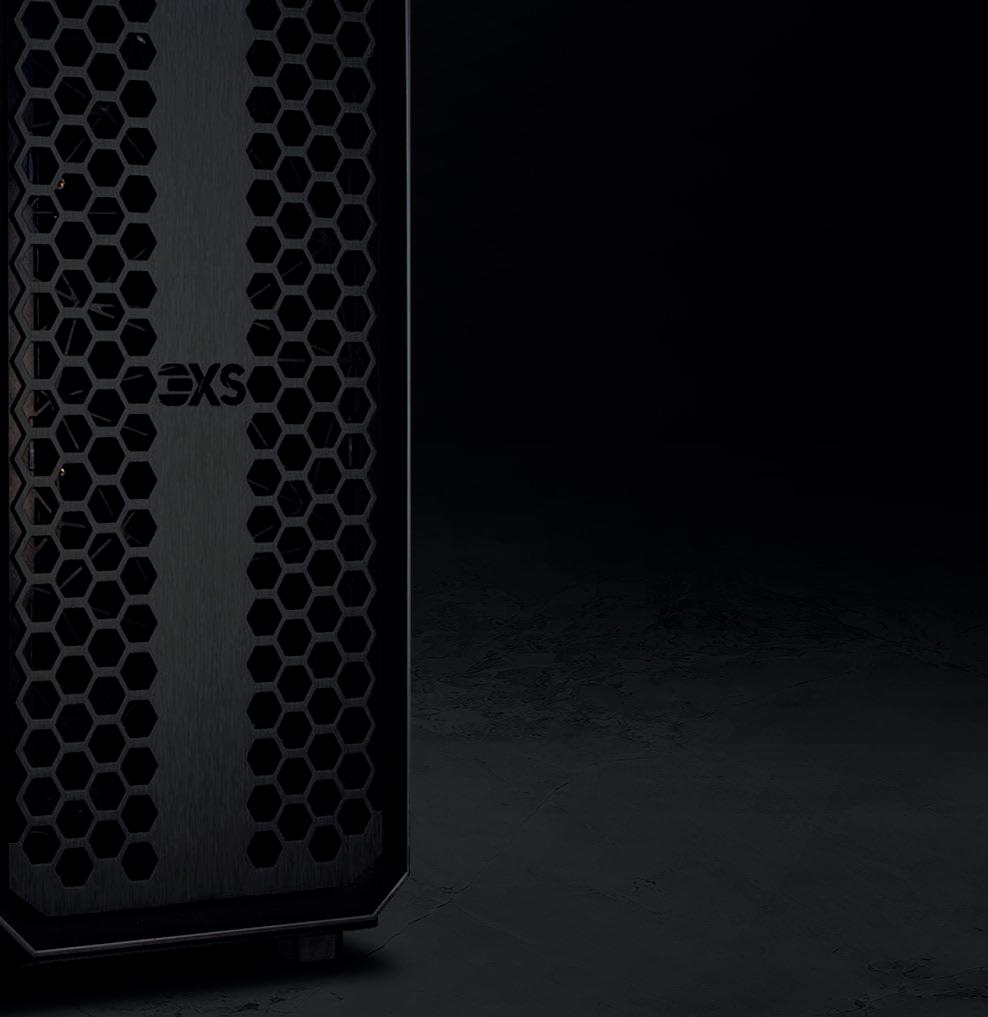
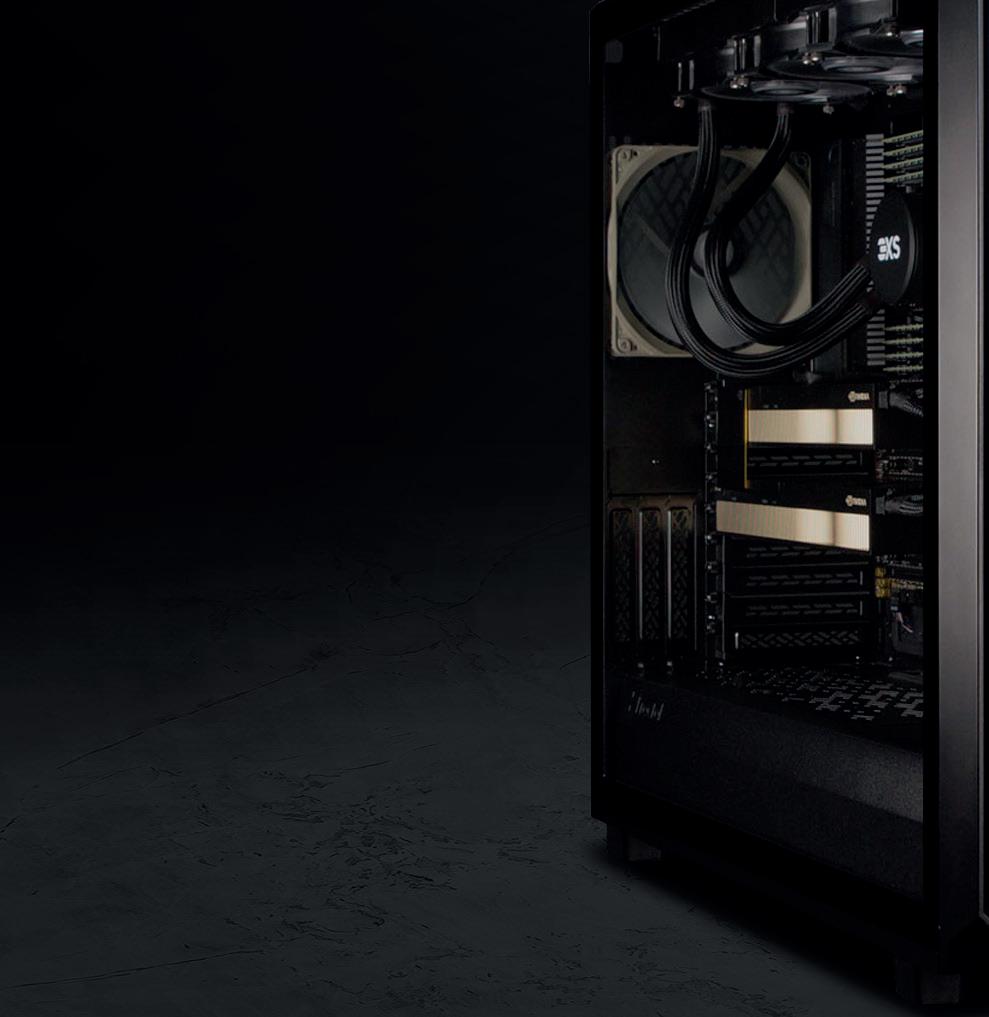


Enough said... The UK’s most highly-acclaimed workstations Discover your perfect workstation at • 01204 47 47 47 scan.co.uk/workstations
doesn’t even begin to describe this supreme graphics workstation” - PC Pro
“Powerful
modelling abilities are excellent” - 3D World
workstation beast has the power to deliver in a whole range of design viz workflows” - AEC Magazine
“This
Scan’s
3D
“A workstation packing an incredible punch for real time viz, VR and GPU rendering” - Develop3D
to
and extreme multi-tasking”
AEC Magazine
“A well-rounded system, performing well across the board and backed up by
typically great service” -
Artist
“Scan wins hands down when it comes
rendering
-





































































































































































































































































































































































































































































































 Greg Corke
Greg Corke






















































































































